Quick filters:
360 bc Stock Photos and Images
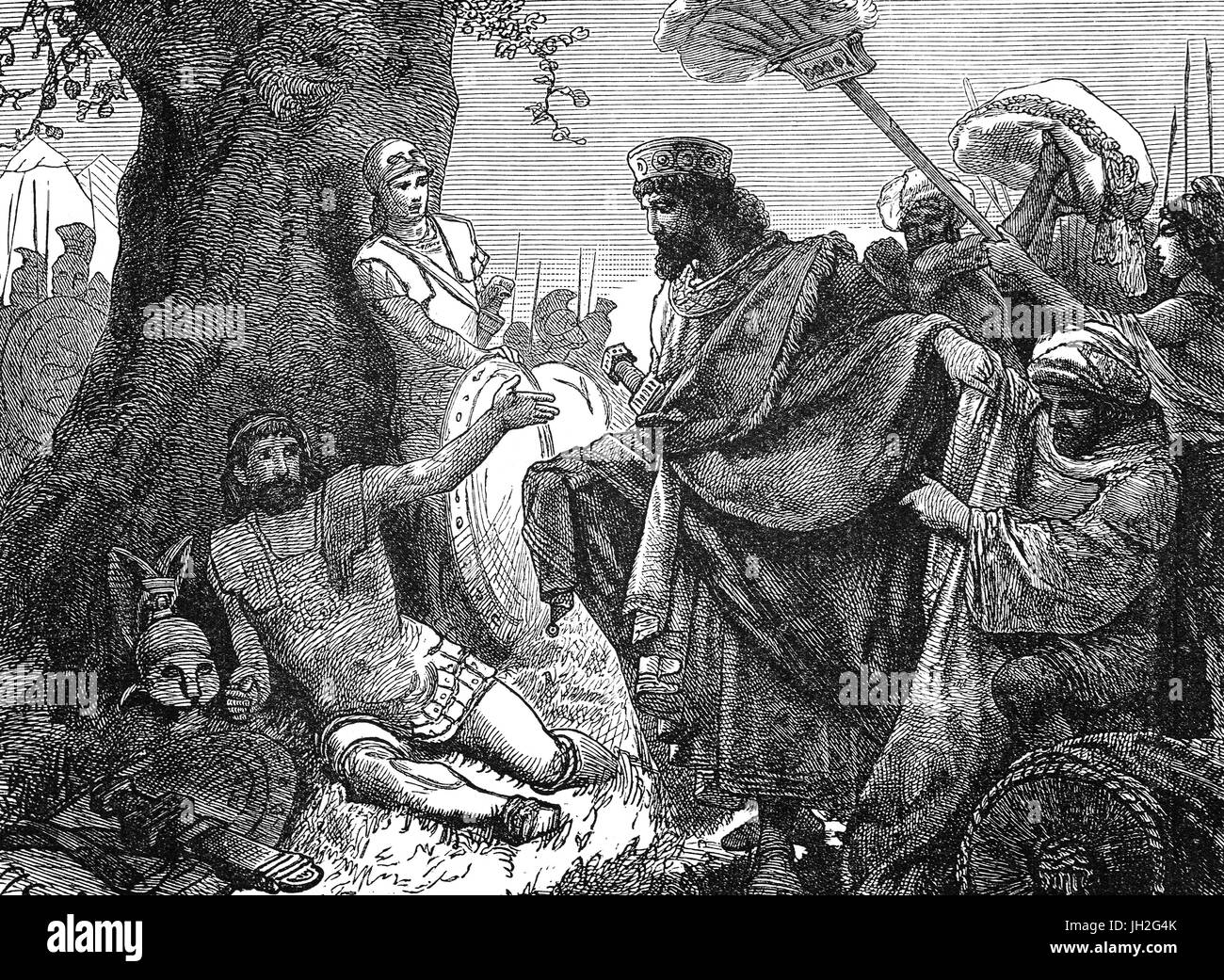 Pharnabazus, a Persian soldier and statesman before Agesilaus II (444 – 360 BC), the Eurypontid king of the Ancient Greek city-state of BATTLEFIELD, who ruled from approximately 400 BC to 360 BC. Stock Photohttps://www.alamy.com/image-license-details/?v=1https://www.alamy.com/stock-photo-pharnabazus-a-persian-soldier-and-statesman-before-agesilaus-ii-444-148188675.html
Pharnabazus, a Persian soldier and statesman before Agesilaus II (444 – 360 BC), the Eurypontid king of the Ancient Greek city-state of BATTLEFIELD, who ruled from approximately 400 BC to 360 BC. Stock Photohttps://www.alamy.com/image-license-details/?v=1https://www.alamy.com/stock-photo-pharnabazus-a-persian-soldier-and-statesman-before-agesilaus-ii-444-148188675.htmlRMJH2G4K–Pharnabazus, a Persian soldier and statesman before Agesilaus II (444 – 360 BC), the Eurypontid king of the Ancient Greek city-state of BATTLEFIELD, who ruled from approximately 400 BC to 360 BC.
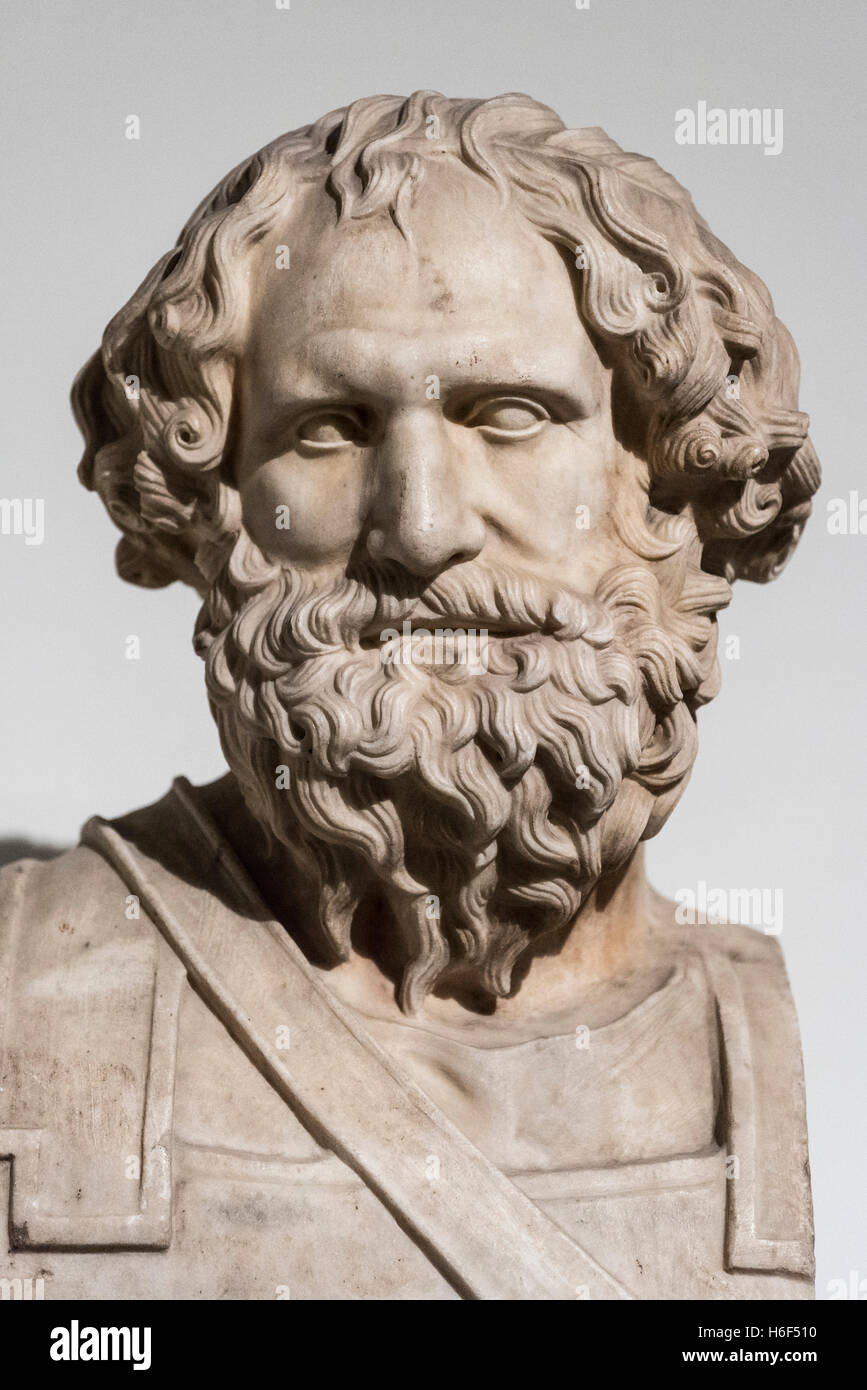 Naples. Italy. Archidamus III, King of Sparta (360 BC-338 BC) Roman bust (late 1st C AD), from Villa of the Papyri, Herculaneum. Stock Photohttps://www.alamy.com/image-license-details/?v=1https://www.alamy.com/stock-photo-naples-italy-archidamus-iii-king-of-sparta-360-bc-338-bc-roman-bust-124493740.html
Naples. Italy. Archidamus III, King of Sparta (360 BC-338 BC) Roman bust (late 1st C AD), from Villa of the Papyri, Herculaneum. Stock Photohttps://www.alamy.com/image-license-details/?v=1https://www.alamy.com/stock-photo-naples-italy-archidamus-iii-king-of-sparta-360-bc-338-bc-roman-bust-124493740.htmlRMH6F510–Naples. Italy. Archidamus III, King of Sparta (360 BC-338 BC) Roman bust (late 1st C AD), from Villa of the Papyri, Herculaneum.
 Egyptian, Building Inscription with part of the Horus name of Nectanebo I, 378/360 BC, Carved Limestone, 9 1/4 x 11 3/4 x 3 in. (23.5 x 29.8 x 7.6 cm Stock Photohttps://www.alamy.com/image-license-details/?v=1https://www.alamy.com/egyptian-building-inscription-with-part-of-the-horus-name-of-nectanebo-i-378360-bc-carved-limestone-9-14-x-11-34-x-3-in-235-x-298-x-76-cm-image328719963.html
Egyptian, Building Inscription with part of the Horus name of Nectanebo I, 378/360 BC, Carved Limestone, 9 1/4 x 11 3/4 x 3 in. (23.5 x 29.8 x 7.6 cm Stock Photohttps://www.alamy.com/image-license-details/?v=1https://www.alamy.com/egyptian-building-inscription-with-part-of-the-horus-name-of-nectanebo-i-378360-bc-carved-limestone-9-14-x-11-34-x-3-in-235-x-298-x-76-cm-image328719963.htmlRM2A2PDJK–Egyptian, Building Inscription with part of the Horus name of Nectanebo I, 378/360 BC, Carved Limestone, 9 1/4 x 11 3/4 x 3 in. (23.5 x 29.8 x 7.6 cm
 Amazon Sarcophagus (370 BC-360 BC) Stock Photohttps://www.alamy.com/image-license-details/?v=1https://www.alamy.com/stock-image-amazon-sarcophagus-370-bc-360-bc-163713167.html
Amazon Sarcophagus (370 BC-360 BC) Stock Photohttps://www.alamy.com/image-license-details/?v=1https://www.alamy.com/stock-image-amazon-sarcophagus-370-bc-360-bc-163713167.htmlRMKE9NPR–Amazon Sarcophagus (370 BC-360 BC)
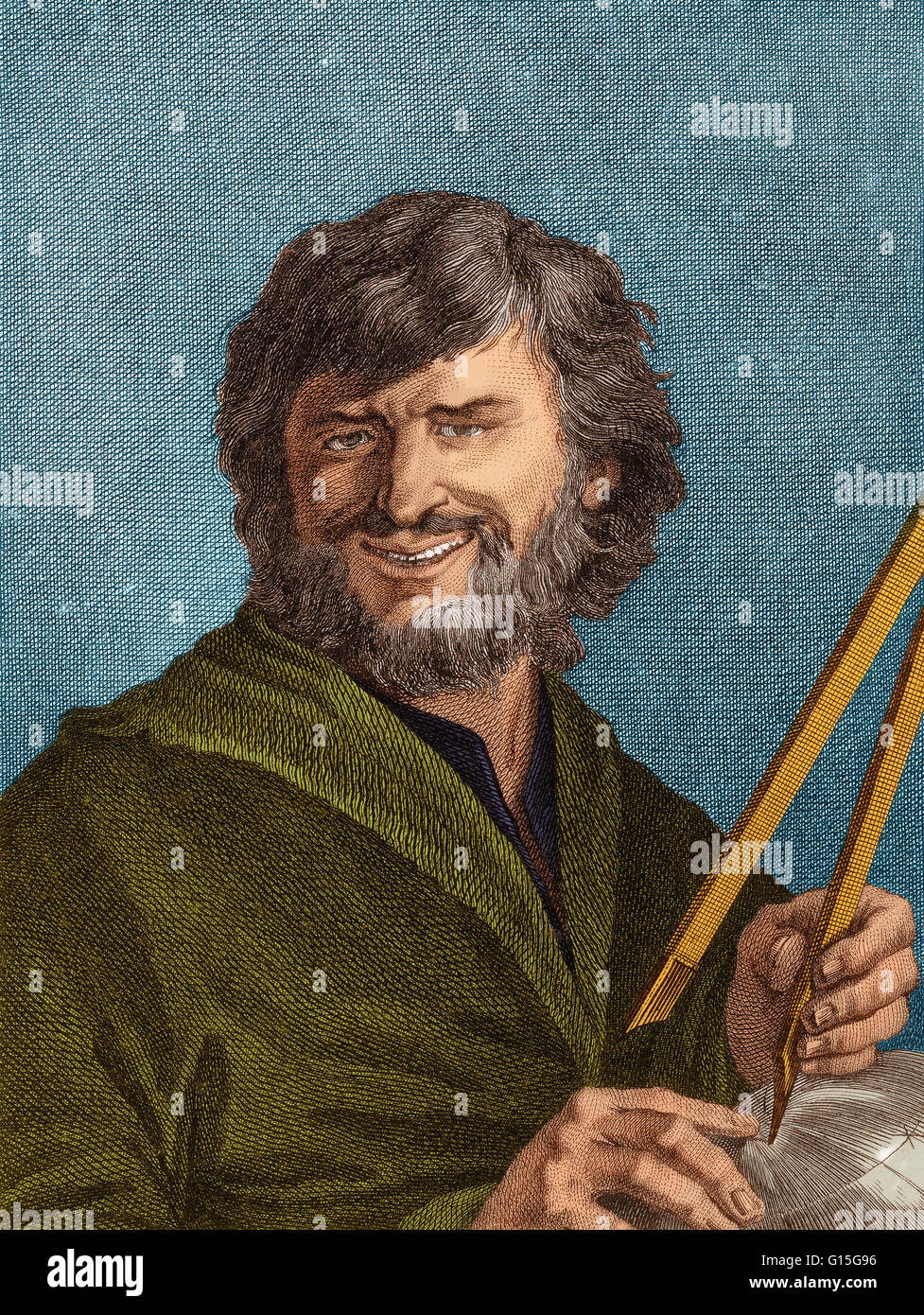 Democritus of Abdera (472/457-370/360 BC) pre-Socratic Greek philosopher and the father of atomic theory. Democritus published works on ethics, physics, mathematics, cosmology and music. Very little has survived but his theories are known through commenta Stock Photohttps://www.alamy.com/image-license-details/?v=1https://www.alamy.com/stock-photo-democritus-of-abdera-472457-370360-bc-pre-socratic-greek-philosopher-103999426.html
Democritus of Abdera (472/457-370/360 BC) pre-Socratic Greek philosopher and the father of atomic theory. Democritus published works on ethics, physics, mathematics, cosmology and music. Very little has survived but his theories are known through commenta Stock Photohttps://www.alamy.com/image-license-details/?v=1https://www.alamy.com/stock-photo-democritus-of-abdera-472457-370360-bc-pre-socratic-greek-philosopher-103999426.htmlRMG15G96–Democritus of Abdera (472/457-370/360 BC) pre-Socratic Greek philosopher and the father of atomic theory. Democritus published works on ethics, physics, mathematics, cosmology and music. Very little has survived but his theories are known through commenta
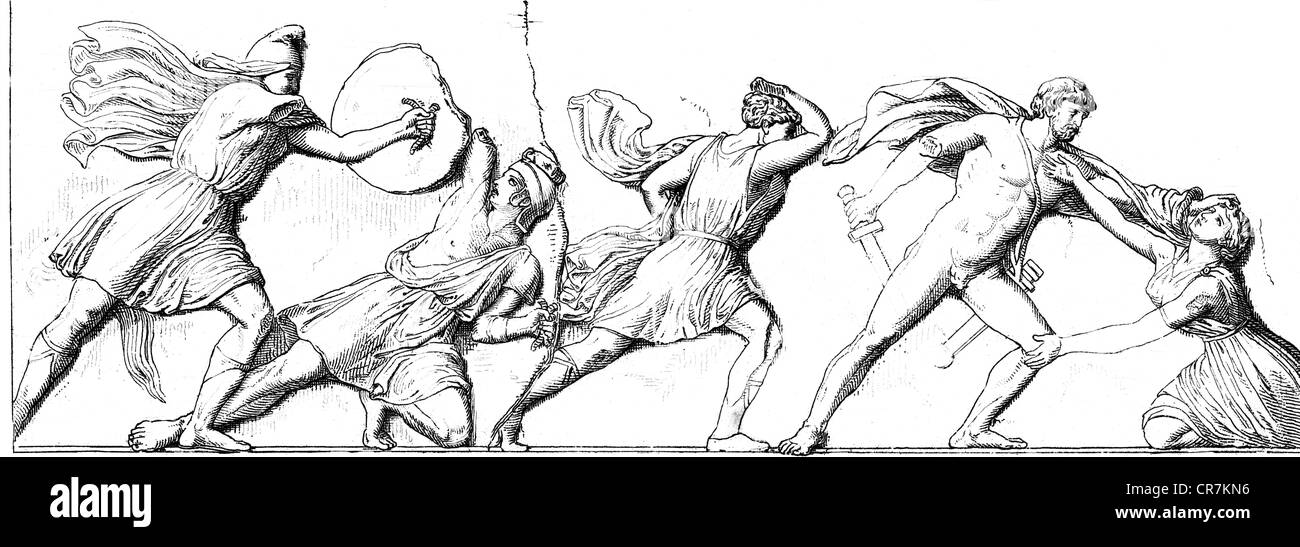 Amazons, Greek legendary figures, fight between Greeks and Amazons, relief, frieze of the tomb of the Maussolos, Halicarnassus, circa 360 BC, wood engraving, 19th century, Stock Photohttps://www.alamy.com/image-license-details/?v=1https://www.alamy.com/stock-photo-amazons-greek-legendary-figures-fight-between-greeks-and-amazons-relief-48726978.html
Amazons, Greek legendary figures, fight between Greeks and Amazons, relief, frieze of the tomb of the Maussolos, Halicarnassus, circa 360 BC, wood engraving, 19th century, Stock Photohttps://www.alamy.com/image-license-details/?v=1https://www.alamy.com/stock-photo-amazons-greek-legendary-figures-fight-between-greeks-and-amazons-relief-48726978.htmlRMCR7KN6–Amazons, Greek legendary figures, fight between Greeks and Amazons, relief, frieze of the tomb of the Maussolos, Halicarnassus, circa 360 BC, wood engraving, 19th century,
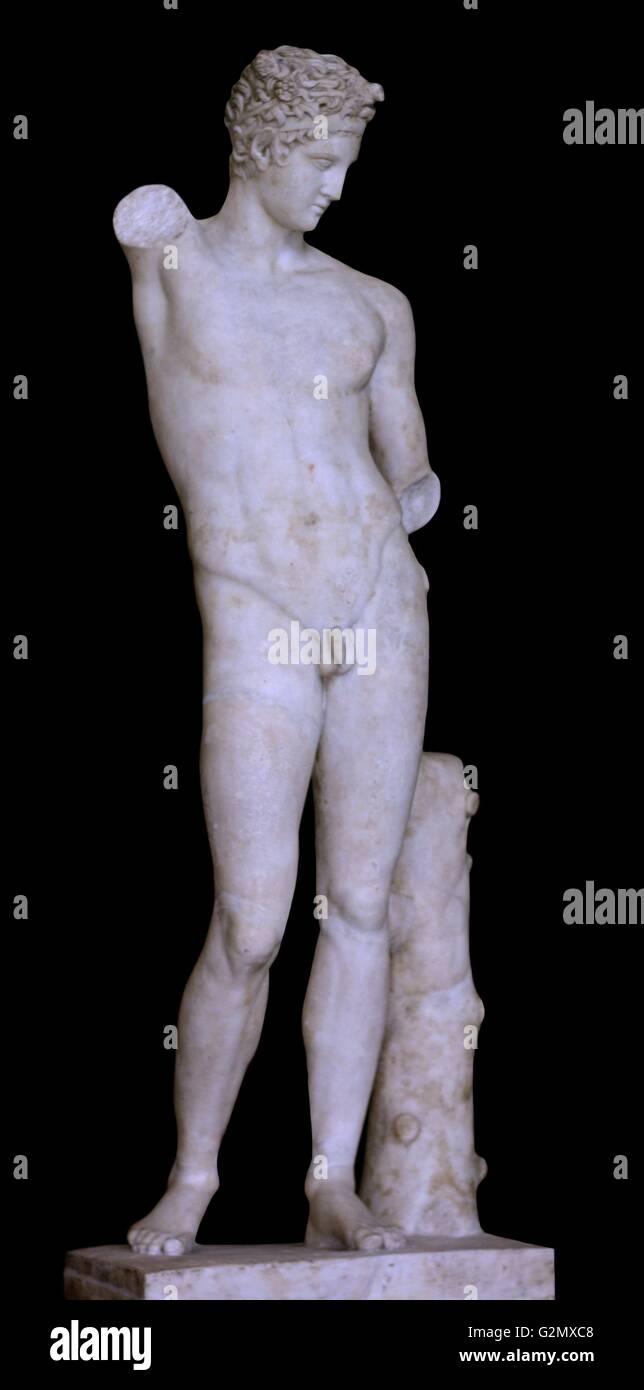 Satyr. Roman copy of a Greek original by the sculptor Praxiteles of about 360 BC Stock Photohttps://www.alamy.com/image-license-details/?v=1https://www.alamy.com/stock-photo-satyr-roman-copy-of-a-greek-original-by-the-sculptor-praxiteles-of-104951288.html
Satyr. Roman copy of a Greek original by the sculptor Praxiteles of about 360 BC Stock Photohttps://www.alamy.com/image-license-details/?v=1https://www.alamy.com/stock-photo-satyr-roman-copy-of-a-greek-original-by-the-sculptor-praxiteles-of-104951288.htmlRMG2MXC8–Satyr. Roman copy of a Greek original by the sculptor Praxiteles of about 360 BC
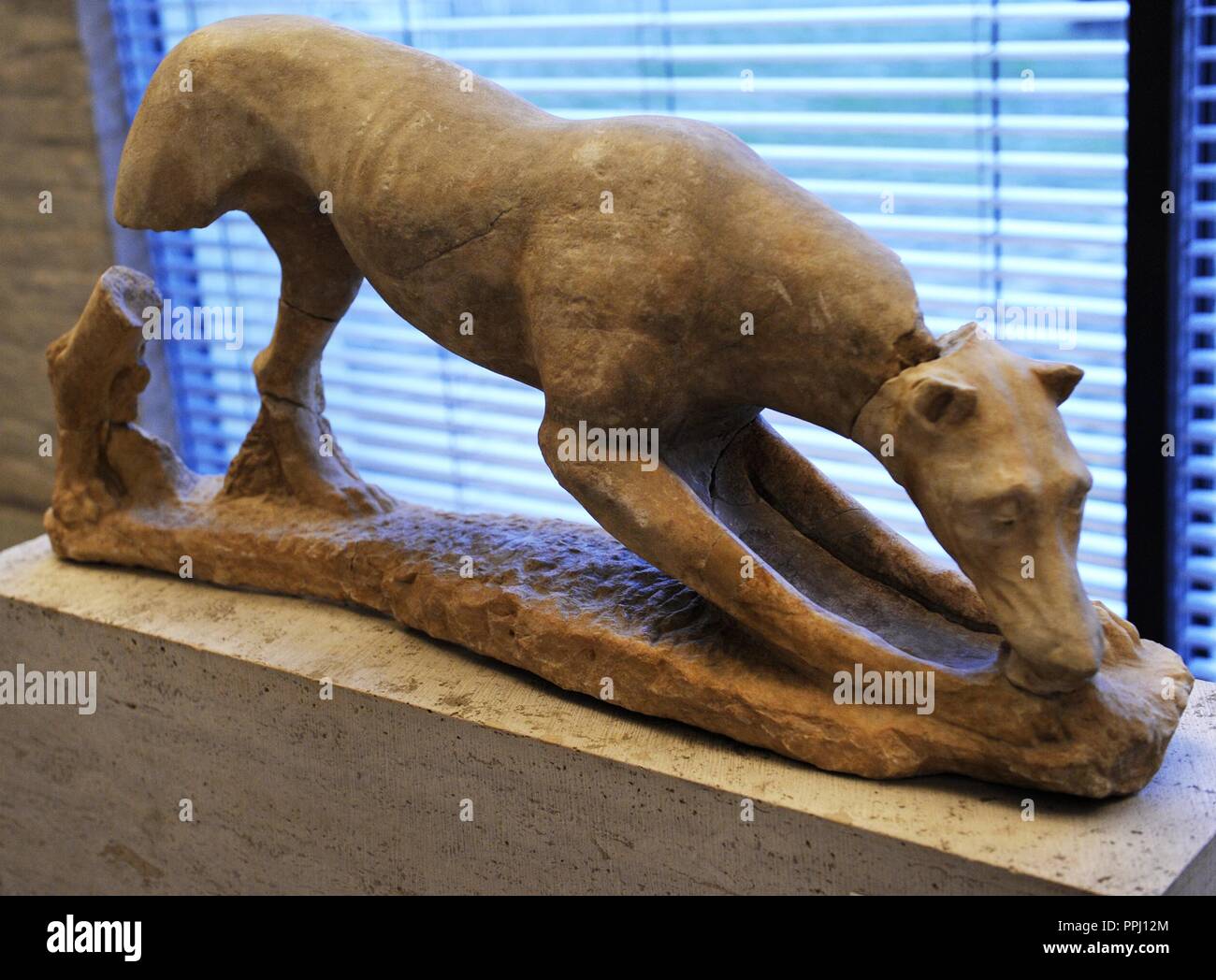 Greek art. Hunting dog. About 360 BC. Probably a grave adornment. Glyptothek. Munich. Germany. Stock Photohttps://www.alamy.com/image-license-details/?v=1https://www.alamy.com/greek-art-hunting-dog-about-360-bc-probably-a-grave-adornment-glyptothek-munich-germany-image220442844.html
Greek art. Hunting dog. About 360 BC. Probably a grave adornment. Glyptothek. Munich. Germany. Stock Photohttps://www.alamy.com/image-license-details/?v=1https://www.alamy.com/greek-art-hunting-dog-about-360-bc-probably-a-grave-adornment-glyptothek-munich-germany-image220442844.htmlRMPPJ12M–Greek art. Hunting dog. About 360 BC. Probably a grave adornment. Glyptothek. Munich. Germany.
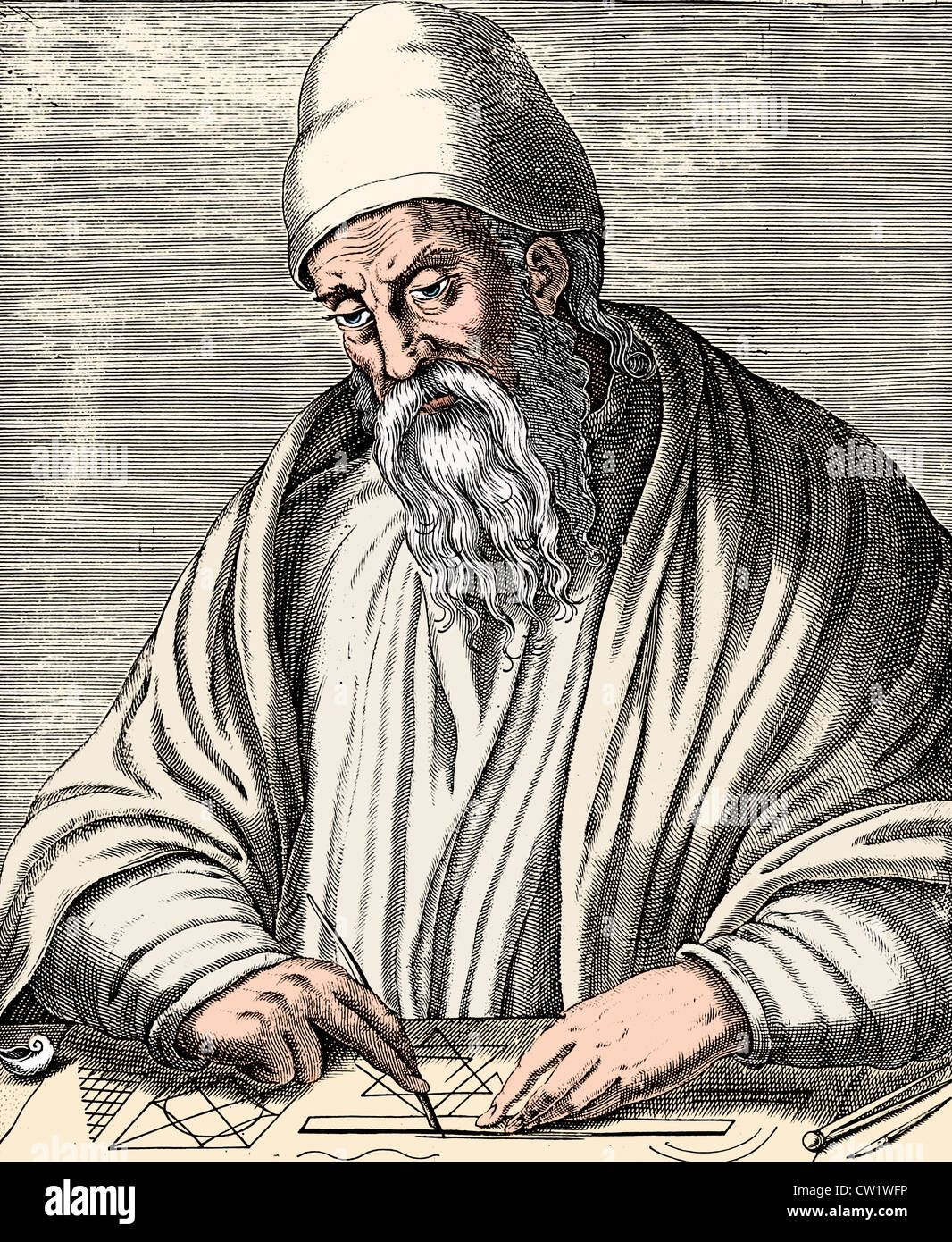 Euclid of Alexandria Stock Photohttps://www.alamy.com/image-license-details/?v=1https://www.alamy.com/stock-photo-euclid-of-alexandria-49829130.html
Euclid of Alexandria Stock Photohttps://www.alamy.com/image-license-details/?v=1https://www.alamy.com/stock-photo-euclid-of-alexandria-49829130.htmlRMCW1WFP–Euclid of Alexandria
 Greek art. Hunting dog. About 360 BC. Probably a grave adornment. Glyptothek. Munich. Germany. Stock Photohttps://www.alamy.com/image-license-details/?v=1https://www.alamy.com/stock-photo-greek-art-hunting-dog-about-360-bc-probably-a-grave-adornment-glyptothek-56031804.html
Greek art. Hunting dog. About 360 BC. Probably a grave adornment. Glyptothek. Munich. Germany. Stock Photohttps://www.alamy.com/image-license-details/?v=1https://www.alamy.com/stock-photo-greek-art-hunting-dog-about-360-bc-probably-a-grave-adornment-glyptothek-56031804.htmlRMD74D3T–Greek art. Hunting dog. About 360 BC. Probably a grave adornment. Glyptothek. Munich. Germany.
 Archidamus III king of Sparta from 360 BC to 338 BC.The founder of the ,Attalid, dynasty ,Pergamon, Anatolia. Greek, Greece, Sculpture,( 18th century Plasters of the Herculanense Museum for Carlos III ) Stock Photohttps://www.alamy.com/image-license-details/?v=1https://www.alamy.com/archidamus-iii-king-of-sparta-from-360-bc-to-338-bcthe-founder-of-the-attalid-dynasty-pergamon-anatolia-greek-greece-sculpture-18th-century-plasters-of-the-herculanense-museum-for-carlos-iii-image384466772.html
Archidamus III king of Sparta from 360 BC to 338 BC.The founder of the ,Attalid, dynasty ,Pergamon, Anatolia. Greek, Greece, Sculpture,( 18th century Plasters of the Herculanense Museum for Carlos III ) Stock Photohttps://www.alamy.com/image-license-details/?v=1https://www.alamy.com/archidamus-iii-king-of-sparta-from-360-bc-to-338-bcthe-founder-of-the-attalid-dynasty-pergamon-anatolia-greek-greece-sculpture-18th-century-plasters-of-the-herculanense-museum-for-carlos-iii-image384466772.htmlRM2D9DY84–Archidamus III king of Sparta from 360 BC to 338 BC.The founder of the ,Attalid, dynasty ,Pergamon, Anatolia. Greek, Greece, Sculpture,( 18th century Plasters of the Herculanense Museum for Carlos III )
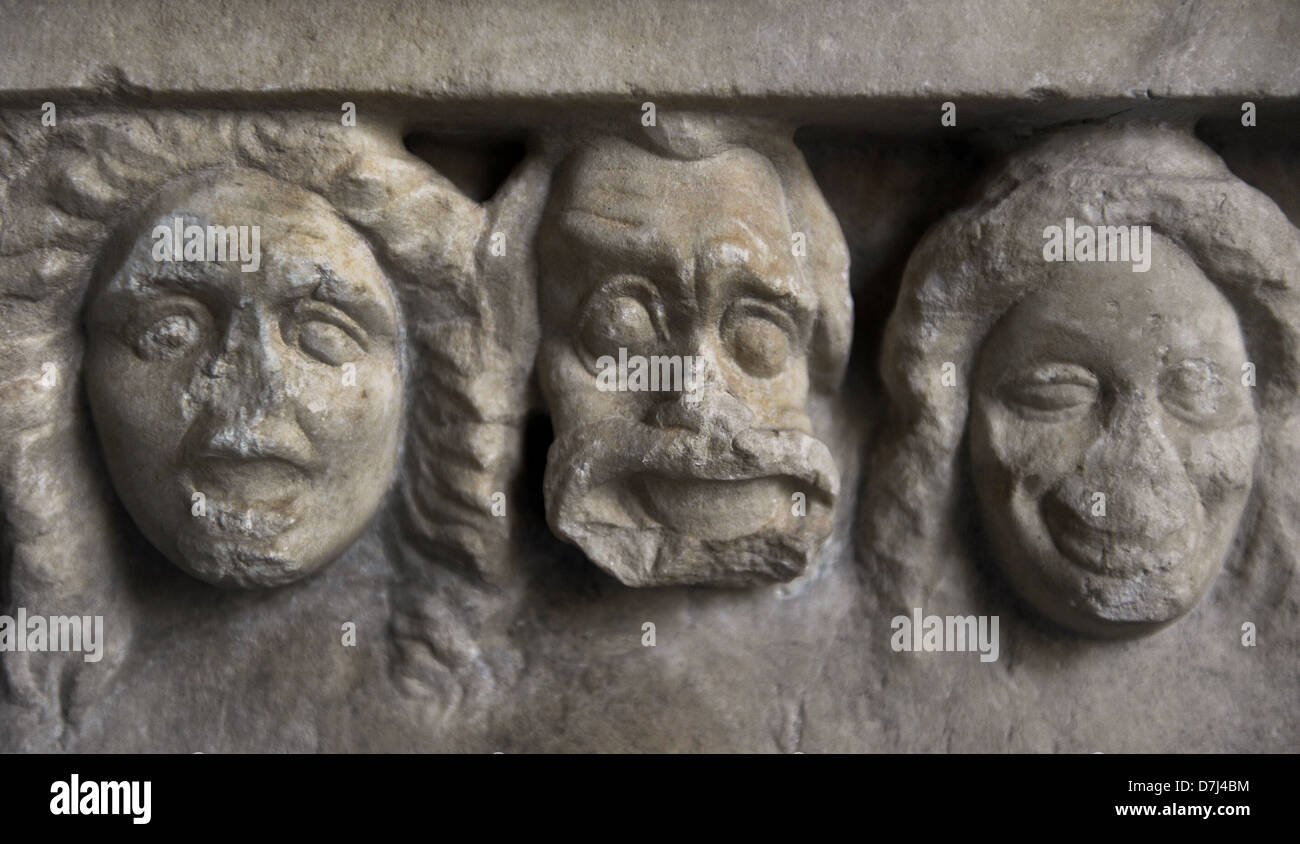 Votive stele depicting a sacrificial procession to Dionysus and Artemis. Votive offering, ca. 360 BC. Detail of the masks. Stock Photohttps://www.alamy.com/image-license-details/?v=1https://www.alamy.com/stock-photo-votive-stele-depicting-a-sacrificial-procession-to-dionysus-and-artemis-56332296.html
Votive stele depicting a sacrificial procession to Dionysus and Artemis. Votive offering, ca. 360 BC. Detail of the masks. Stock Photohttps://www.alamy.com/image-license-details/?v=1https://www.alamy.com/stock-photo-votive-stele-depicting-a-sacrificial-procession-to-dionysus-and-artemis-56332296.htmlRMD7J4BM–Votive stele depicting a sacrificial procession to Dionysus and Artemis. Votive offering, ca. 360 BC. Detail of the masks.
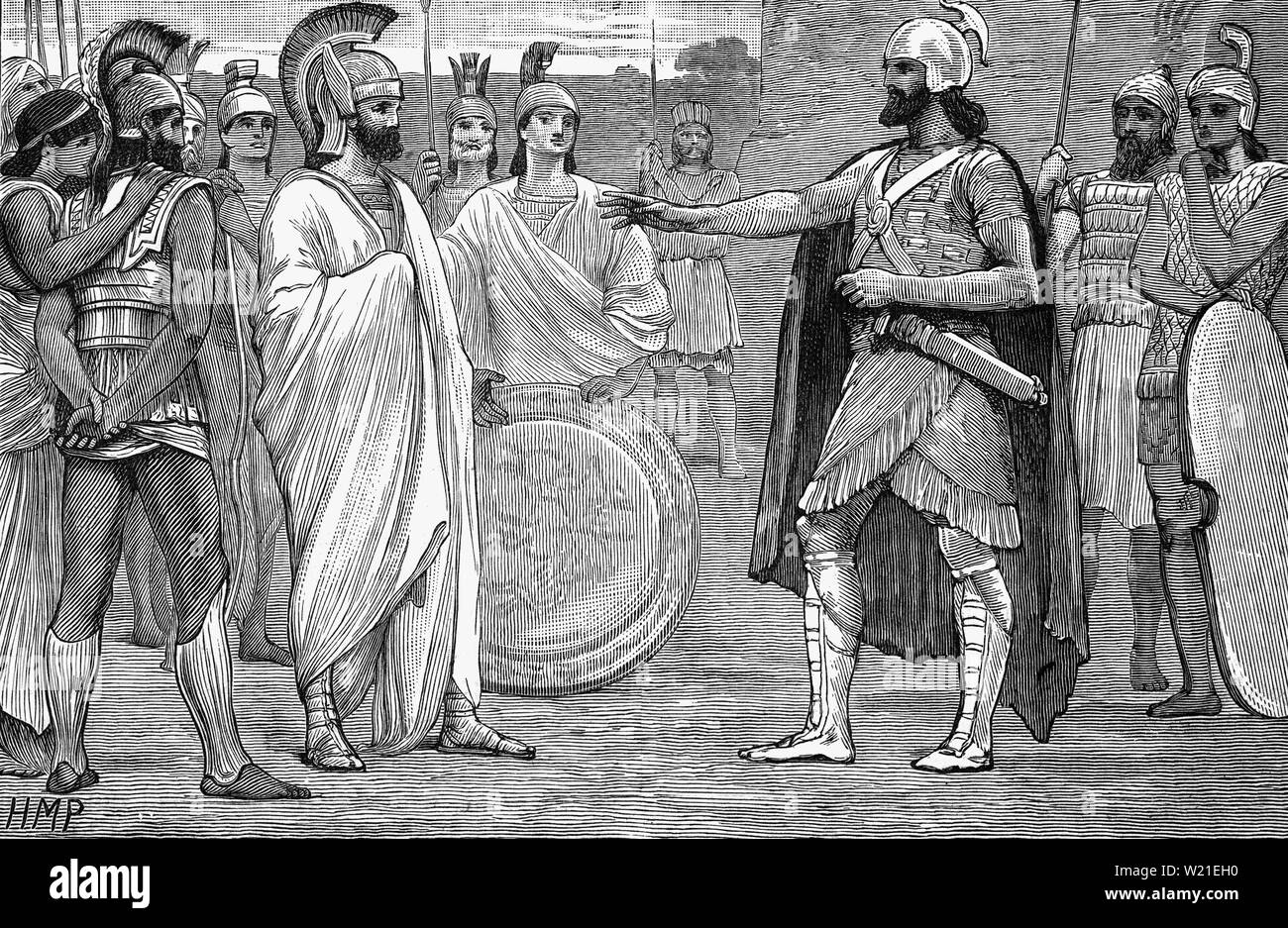 A meeting of Agesilaus and Pharnabazus. After victory in the Peloponnesian War, Agesilaus II (443 – 360 BCE), became king of the Greek city-state of Sparta ruling from 398 to about 360 BC, during which time he was commander and king of all Greece and became a threat for the Achaemenid Empire. Pharnabazus, a Persian soldier and statesman, and Satrap of Hellespontine Phrygia was involved in trying to stop defeated Greeks from entering and plundering Hellespontine Phrygia as they were returning from their failed campaign in the center of the Achaemenid Empire. Stock Photohttps://www.alamy.com/image-license-details/?v=1https://www.alamy.com/a-meeting-of-agesilaus-and-pharnabazus-after-victory-in-the-peloponnesian-war-agesilaus-ii-443-360-bce-became-king-of-the-greek-city-state-of-sparta-ruling-from-398-to-about-360-bc-during-which-time-he-was-commander-and-king-of-all-greece-and-became-a-threat-for-the-achaemenid-empire-pharnabazus-a-persian-soldier-and-statesman-and-satrap-of-hellespontine-phrygia-was-involved-in-trying-to-stop-defeated-greeks-from-entering-and-plundering-hellespontine-phrygia-as-they-were-returning-from-their-failed-campaign-in-the-center-of-the-achaemenid-empire-image259418236.html
A meeting of Agesilaus and Pharnabazus. After victory in the Peloponnesian War, Agesilaus II (443 – 360 BCE), became king of the Greek city-state of Sparta ruling from 398 to about 360 BC, during which time he was commander and king of all Greece and became a threat for the Achaemenid Empire. Pharnabazus, a Persian soldier and statesman, and Satrap of Hellespontine Phrygia was involved in trying to stop defeated Greeks from entering and plundering Hellespontine Phrygia as they were returning from their failed campaign in the center of the Achaemenid Empire. Stock Photohttps://www.alamy.com/image-license-details/?v=1https://www.alamy.com/a-meeting-of-agesilaus-and-pharnabazus-after-victory-in-the-peloponnesian-war-agesilaus-ii-443-360-bce-became-king-of-the-greek-city-state-of-sparta-ruling-from-398-to-about-360-bc-during-which-time-he-was-commander-and-king-of-all-greece-and-became-a-threat-for-the-achaemenid-empire-pharnabazus-a-persian-soldier-and-statesman-and-satrap-of-hellespontine-phrygia-was-involved-in-trying-to-stop-defeated-greeks-from-entering-and-plundering-hellespontine-phrygia-as-they-were-returning-from-their-failed-campaign-in-the-center-of-the-achaemenid-empire-image259418236.htmlRMW21EH0–A meeting of Agesilaus and Pharnabazus. After victory in the Peloponnesian War, Agesilaus II (443 – 360 BCE), became king of the Greek city-state of Sparta ruling from 398 to about 360 BC, during which time he was commander and king of all Greece and became a threat for the Achaemenid Empire. Pharnabazus, a Persian soldier and statesman, and Satrap of Hellespontine Phrygia was involved in trying to stop defeated Greeks from entering and plundering Hellespontine Phrygia as they were returning from their failed campaign in the center of the Achaemenid Empire.
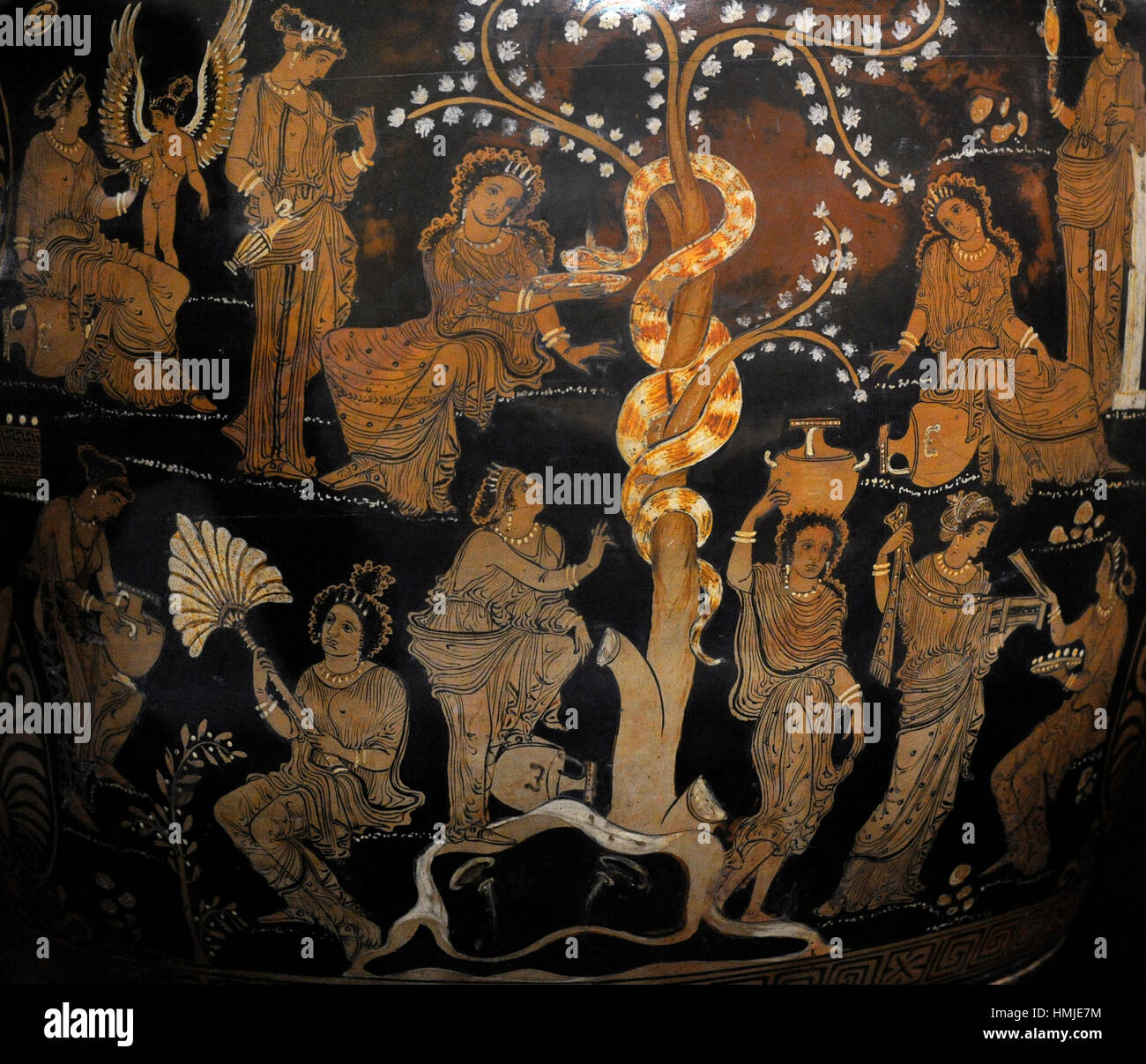 Krater with decoration depicting the Garden of the Hesperides. 360 BC. Detail. Lycurgus Painter. Made in Puglia. From Ruvo di Puglia. Jatta National Archaeological Museum. Ruvo di Puglia. Italy. Stock Photohttps://www.alamy.com/image-license-details/?v=1https://www.alamy.com/stock-photo-krater-with-decoration-depicting-the-garden-of-the-hesperides-360-133172024.html
Krater with decoration depicting the Garden of the Hesperides. 360 BC. Detail. Lycurgus Painter. Made in Puglia. From Ruvo di Puglia. Jatta National Archaeological Museum. Ruvo di Puglia. Italy. Stock Photohttps://www.alamy.com/image-license-details/?v=1https://www.alamy.com/stock-photo-krater-with-decoration-depicting-the-garden-of-the-hesperides-360-133172024.htmlRMHMJE7M–Krater with decoration depicting the Garden of the Hesperides. 360 BC. Detail. Lycurgus Painter. Made in Puglia. From Ruvo di Puglia. Jatta National Archaeological Museum. Ruvo di Puglia. Italy.
 Greece, East Macedonia and Thrace Region, Philippi, ruins of ancient city founded in 360 BC, view of the Forum Stock Photohttps://www.alamy.com/image-license-details/?v=1https://www.alamy.com/stock-photo-greece-east-macedonia-and-thrace-region-philippi-ruins-of-ancient-149612599.html
Greece, East Macedonia and Thrace Region, Philippi, ruins of ancient city founded in 360 BC, view of the Forum Stock Photohttps://www.alamy.com/image-license-details/?v=1https://www.alamy.com/stock-photo-greece-east-macedonia-and-thrace-region-philippi-ruins-of-ancient-149612599.htmlRMJKBCB3–Greece, East Macedonia and Thrace Region, Philippi, ruins of ancient city founded in 360 BC, view of the Forum
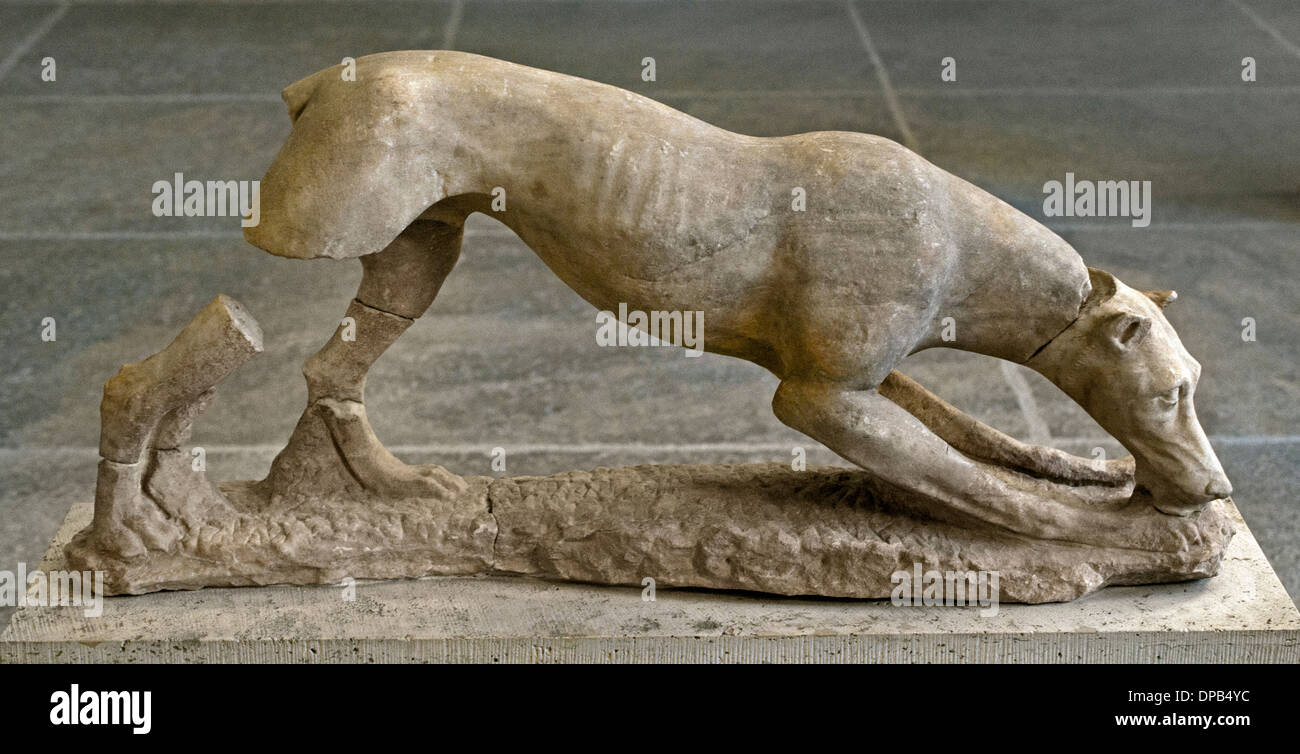 Hunting dog. About 360 BC. Greek Probably a grave adornment Greece Stock Photohttps://www.alamy.com/image-license-details/?v=1https://www.alamy.com/hunting-dog-about-360-bc-greek-probably-a-grave-adornment-greece-image65398912.html
Hunting dog. About 360 BC. Greek Probably a grave adornment Greece Stock Photohttps://www.alamy.com/image-license-details/?v=1https://www.alamy.com/hunting-dog-about-360-bc-greek-probably-a-grave-adornment-greece-image65398912.htmlRMDPB4YC–Hunting dog. About 360 BC. Greek Probably a grave adornment Greece
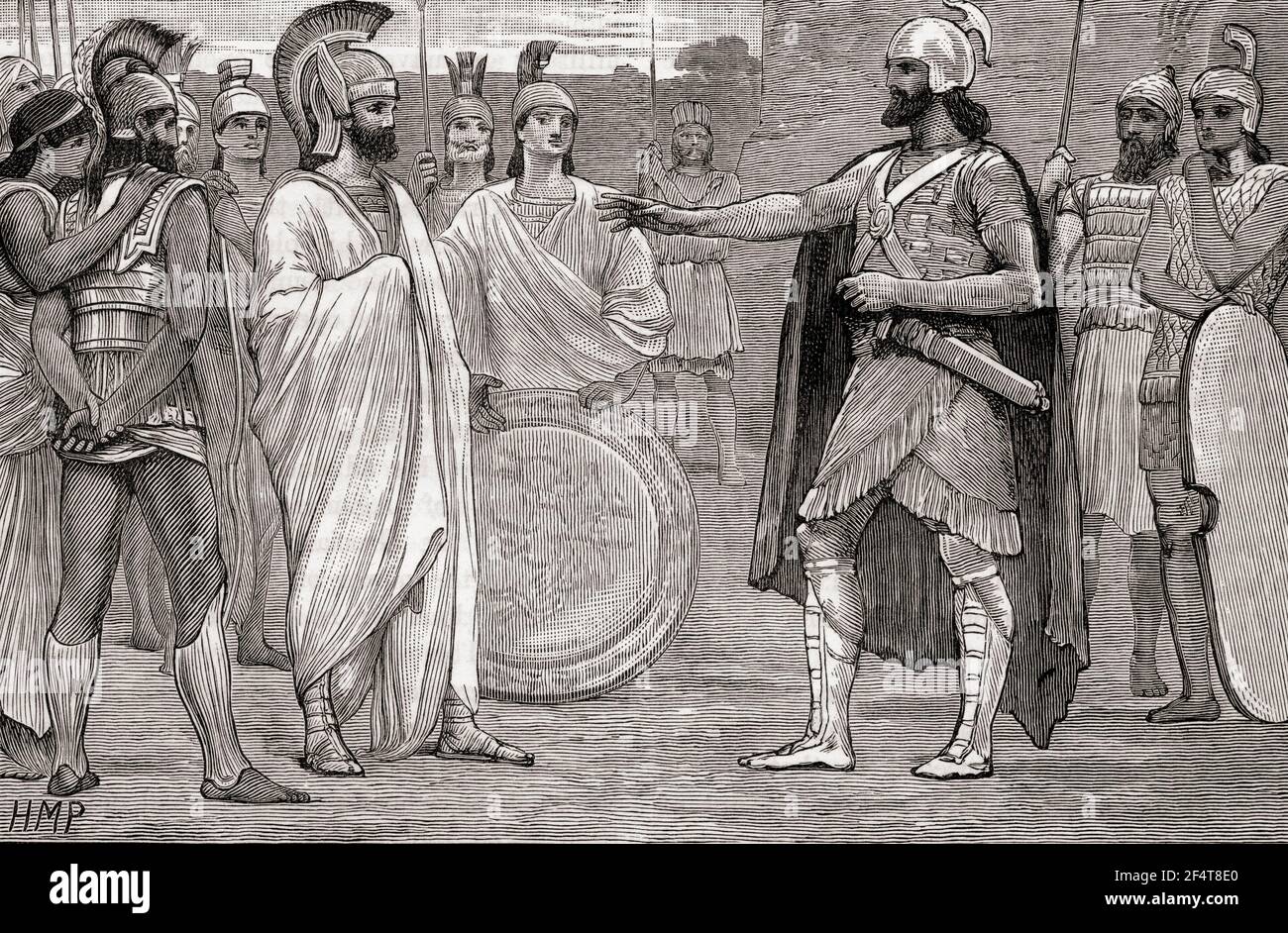 Meeting between Agesilaus (left) and Pharnabazus II (right) in 395 BC, when Agesilaus agreed to remove himself from Hellespontine Phrygia. Agesilaus II, c. 444/443 – c. 360 BC. King of the ancient Greek city-state of Sparta and a member of the Eurypontid dynasty. Pharnabazus II, Persian soldier and statesman, and Satrap of Hellespontine Phrygia. From Cassell's Universal History, published 1888. Stock Photohttps://www.alamy.com/image-license-details/?v=1https://www.alamy.com/meeting-between-agesilaus-left-and-pharnabazus-ii-right-in-395-bc-when-agesilaus-agreed-to-remove-himself-from-hellespontine-phrygia-agesilaus-ii-c-444443-c-360-bc-king-of-the-ancient-greek-city-state-of-sparta-and-a-member-of-the-eurypontid-dynasty-pharnabazus-ii-persian-soldier-and-statesman-and-satrap-of-hellespontine-phrygia-from-cassells-universal-history-published-1888-image416040968.html
Meeting between Agesilaus (left) and Pharnabazus II (right) in 395 BC, when Agesilaus agreed to remove himself from Hellespontine Phrygia. Agesilaus II, c. 444/443 – c. 360 BC. King of the ancient Greek city-state of Sparta and a member of the Eurypontid dynasty. Pharnabazus II, Persian soldier and statesman, and Satrap of Hellespontine Phrygia. From Cassell's Universal History, published 1888. Stock Photohttps://www.alamy.com/image-license-details/?v=1https://www.alamy.com/meeting-between-agesilaus-left-and-pharnabazus-ii-right-in-395-bc-when-agesilaus-agreed-to-remove-himself-from-hellespontine-phrygia-agesilaus-ii-c-444443-c-360-bc-king-of-the-ancient-greek-city-state-of-sparta-and-a-member-of-the-eurypontid-dynasty-pharnabazus-ii-persian-soldier-and-statesman-and-satrap-of-hellespontine-phrygia-from-cassells-universal-history-published-1888-image416040968.htmlRM2F4T8E0–Meeting between Agesilaus (left) and Pharnabazus II (right) in 395 BC, when Agesilaus agreed to remove himself from Hellespontine Phrygia. Agesilaus II, c. 444/443 – c. 360 BC. King of the ancient Greek city-state of Sparta and a member of the Eurypontid dynasty. Pharnabazus II, Persian soldier and statesman, and Satrap of Hellespontine Phrygia. From Cassell's Universal History, published 1888.
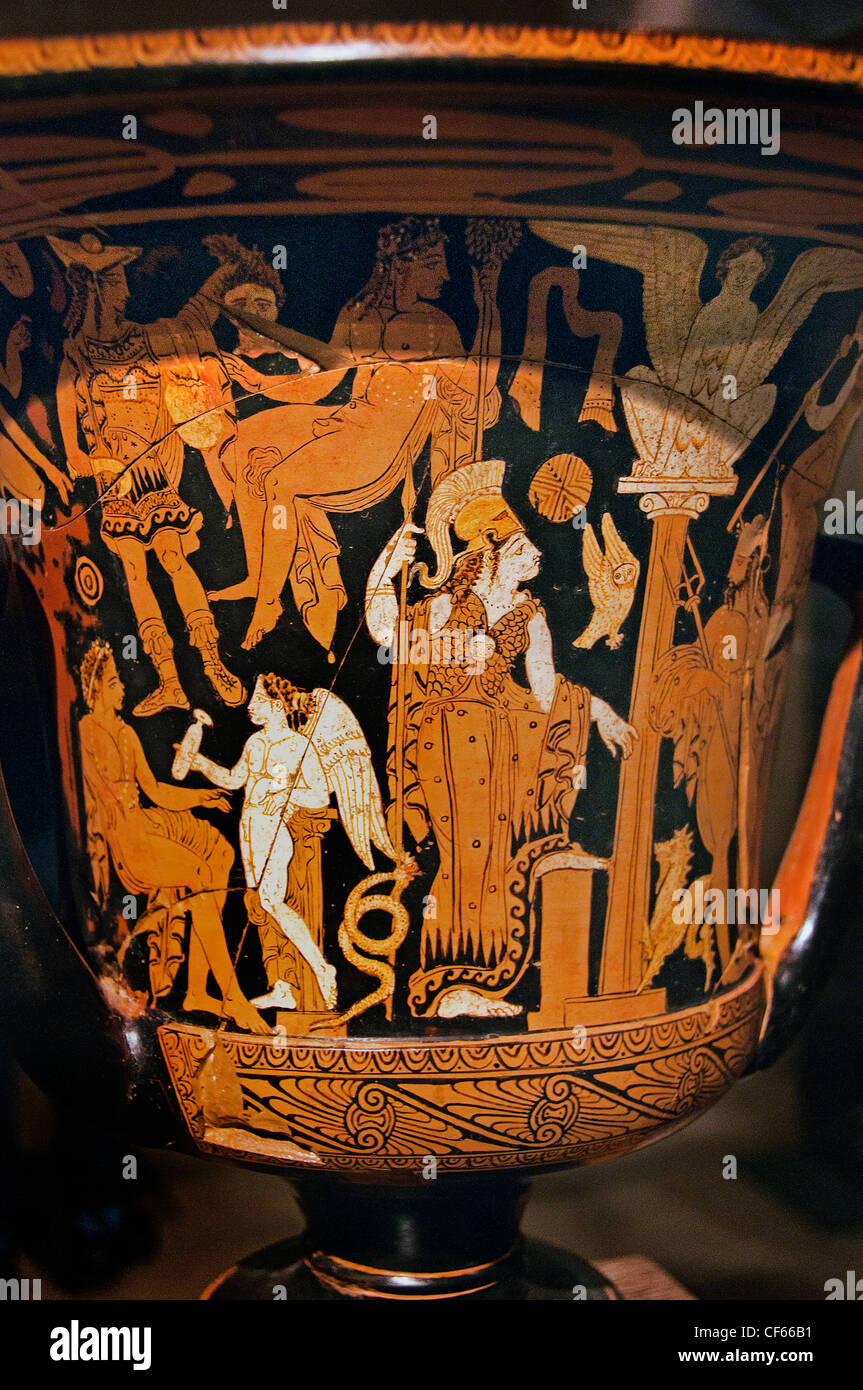 Athena Poseidon gods Chalice krater 360 BC Faliscan Etruscan Italy Italian Stock Photohttps://www.alamy.com/image-license-details/?v=1https://www.alamy.com/stock-photo-athena-poseidon-gods-chalice-krater-360-bc-faliscan-etruscan-italy-43777301.html
Athena Poseidon gods Chalice krater 360 BC Faliscan Etruscan Italy Italian Stock Photohttps://www.alamy.com/image-license-details/?v=1https://www.alamy.com/stock-photo-athena-poseidon-gods-chalice-krater-360-bc-faliscan-etruscan-italy-43777301.htmlRMCF66B1–Athena Poseidon gods Chalice krater 360 BC Faliscan Etruscan Italy Italian
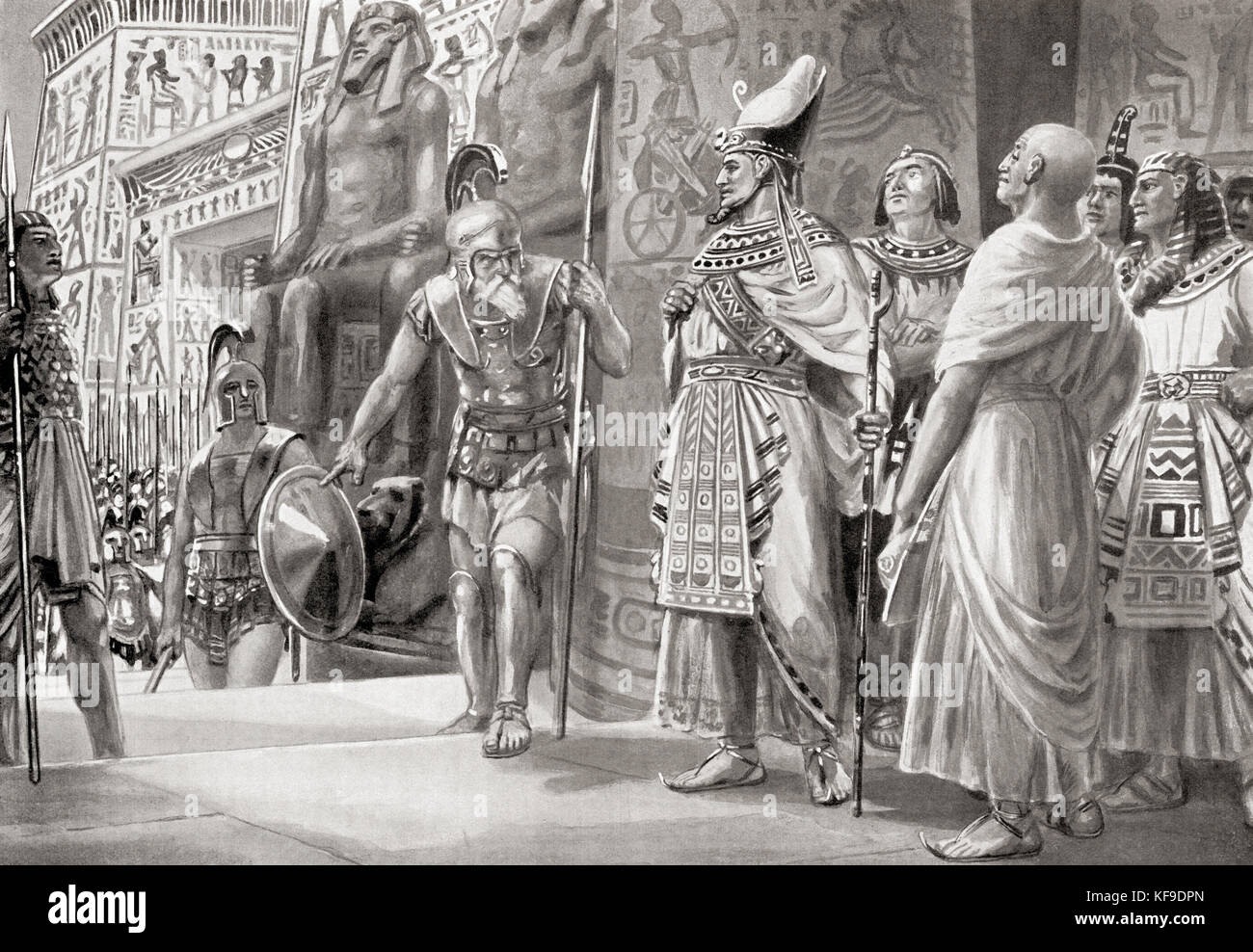 Agesilaus in Egypt in 361 BC at the head of a mercenary force to aid king Nectanebo I and his regent Teos against Persia. Agesilaus II, c. 444 – c. 360 BC. Eurypontid king of the Ancient Greek city-state of Sparta, ruling from approximately 400 BC to 360 BC. After the painting by Ambrose Dudley, (1867-1951). From Hutchinson's History of the Nations, published 1915. Stock Photohttps://www.alamy.com/image-license-details/?v=1https://www.alamy.com/stock-image-agesilaus-in-egypt-in-361-bc-at-the-head-of-a-mercenary-force-to-aid-164321549.html
Agesilaus in Egypt in 361 BC at the head of a mercenary force to aid king Nectanebo I and his regent Teos against Persia. Agesilaus II, c. 444 – c. 360 BC. Eurypontid king of the Ancient Greek city-state of Sparta, ruling from approximately 400 BC to 360 BC. After the painting by Ambrose Dudley, (1867-1951). From Hutchinson's History of the Nations, published 1915. Stock Photohttps://www.alamy.com/image-license-details/?v=1https://www.alamy.com/stock-image-agesilaus-in-egypt-in-361-bc-at-the-head-of-a-mercenary-force-to-aid-164321549.htmlRMKF9DPN–Agesilaus in Egypt in 361 BC at the head of a mercenary force to aid king Nectanebo I and his regent Teos against Persia. Agesilaus II, c. 444 – c. 360 BC. Eurypontid king of the Ancient Greek city-state of Sparta, ruling from approximately 400 BC to 360 BC. After the painting by Ambrose Dudley, (1867-1951). From Hutchinson's History of the Nations, published 1915.
 Greece, East Macedonia and Thrace Region, Philippi, ruins of ancient city founded in 360 BC, Basilica B Stock Photohttps://www.alamy.com/image-license-details/?v=1https://www.alamy.com/greece-east-macedonia-and-thrace-region-philippi-ruins-of-ancient-city-founded-in-360-bc-basilica-b-image259649661.html
Greece, East Macedonia and Thrace Region, Philippi, ruins of ancient city founded in 360 BC, Basilica B Stock Photohttps://www.alamy.com/image-license-details/?v=1https://www.alamy.com/greece-east-macedonia-and-thrace-region-philippi-ruins-of-ancient-city-founded-in-360-bc-basilica-b-image259649661.htmlRMW2C1P5–Greece, East Macedonia and Thrace Region, Philippi, ruins of ancient city founded in 360 BC, Basilica B
 The Garden of the Hesperides (Apulian Krater), ca 360 BC. Found in the Collection of Palazzo Jatta, Ruvo di Puglia. Stock Photohttps://www.alamy.com/image-license-details/?v=1https://www.alamy.com/the-garden-of-the-hesperides-apulian-krater-ca-360-bc-found-in-the-collection-of-palazzo-jatta-ruvo-di-puglia-image273937672.html
The Garden of the Hesperides (Apulian Krater), ca 360 BC. Found in the Collection of Palazzo Jatta, Ruvo di Puglia. Stock Photohttps://www.alamy.com/image-license-details/?v=1https://www.alamy.com/the-garden-of-the-hesperides-apulian-krater-ca-360-bc-found-in-the-collection-of-palazzo-jatta-ruvo-di-puglia-image273937672.htmlRMWWJX88–The Garden of the Hesperides (Apulian Krater), ca 360 BC. Found in the Collection of Palazzo Jatta, Ruvo di Puglia.
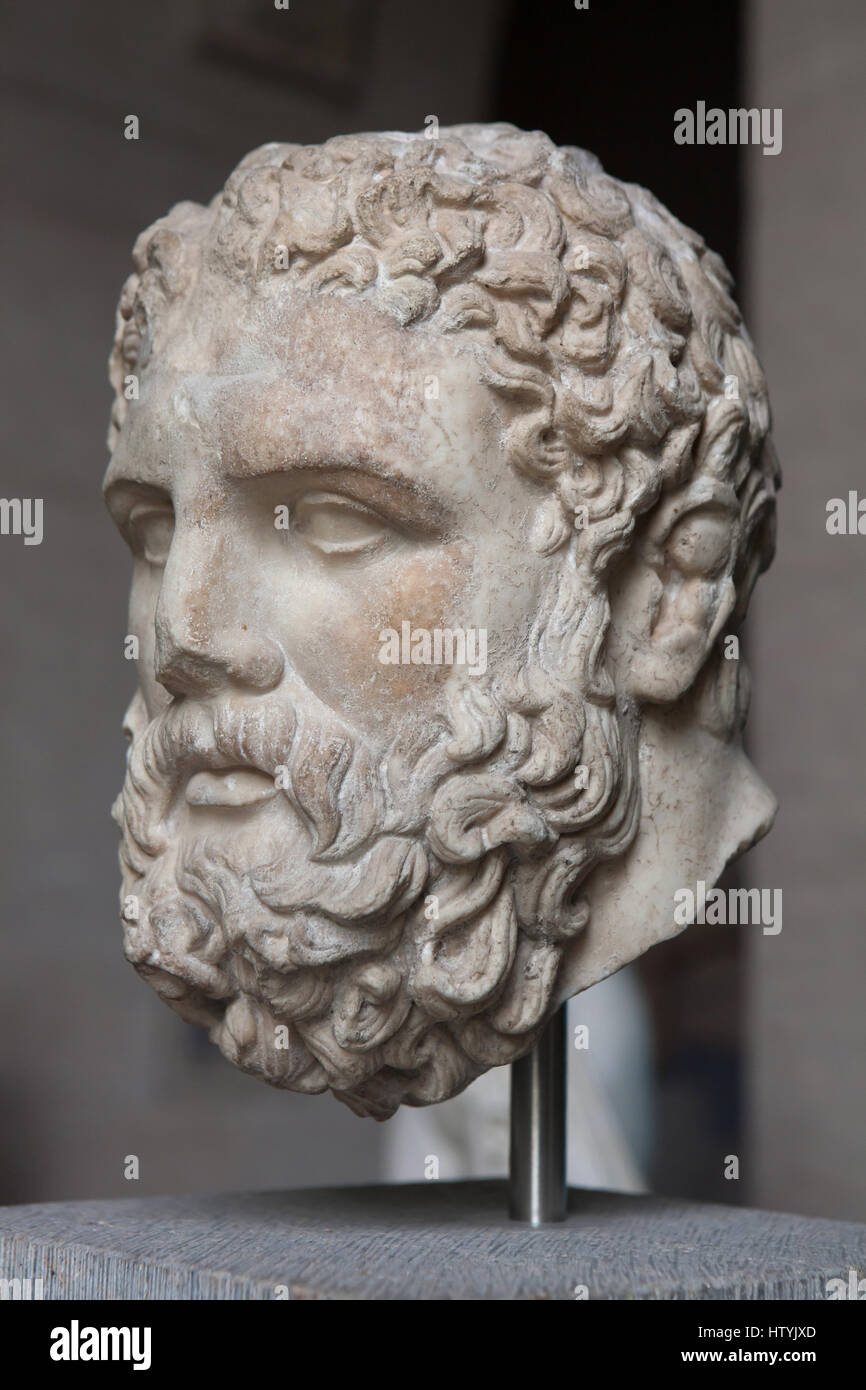 Head of Heracles. Roman copy after a Greek original from about 360 BC on display in the Glyptothek Museum in Munich, Bavaria, Germany. Stock Photohttps://www.alamy.com/image-license-details/?v=1https://www.alamy.com/stock-photo-head-of-heracles-roman-copy-after-a-greek-original-from-about-360-135831877.html
Head of Heracles. Roman copy after a Greek original from about 360 BC on display in the Glyptothek Museum in Munich, Bavaria, Germany. Stock Photohttps://www.alamy.com/image-license-details/?v=1https://www.alamy.com/stock-photo-head-of-heracles-roman-copy-after-a-greek-original-from-about-360-135831877.htmlRMHTYJXD–Head of Heracles. Roman copy after a Greek original from about 360 BC on display in the Glyptothek Museum in Munich, Bavaria, Germany.
 View of the Tomb of Payava drawn by George Scharf. The tomb is a Lycian tall rectangular free-standing barrel-vaulted stone sarcophagus built for Payava, ruler of Xanthos. Dated 360 BC Stock Photohttps://www.alamy.com/image-license-details/?v=1https://www.alamy.com/view-of-the-tomb-of-payava-drawn-by-george-scharf-the-tomb-is-a-lycian-tall-rectangular-free-standing-barrel-vaulted-stone-sarcophagus-built-for-payava-ruler-of-xanthos-dated-360-bc-image330687571.html
View of the Tomb of Payava drawn by George Scharf. The tomb is a Lycian tall rectangular free-standing barrel-vaulted stone sarcophagus built for Payava, ruler of Xanthos. Dated 360 BC Stock Photohttps://www.alamy.com/image-license-details/?v=1https://www.alamy.com/view-of-the-tomb-of-payava-drawn-by-george-scharf-the-tomb-is-a-lycian-tall-rectangular-free-standing-barrel-vaulted-stone-sarcophagus-built-for-payava-ruler-of-xanthos-dated-360-bc-image330687571.htmlRM2A603AB–View of the Tomb of Payava drawn by George Scharf. The tomb is a Lycian tall rectangular free-standing barrel-vaulted stone sarcophagus built for Payava, ruler of Xanthos. Dated 360 BC
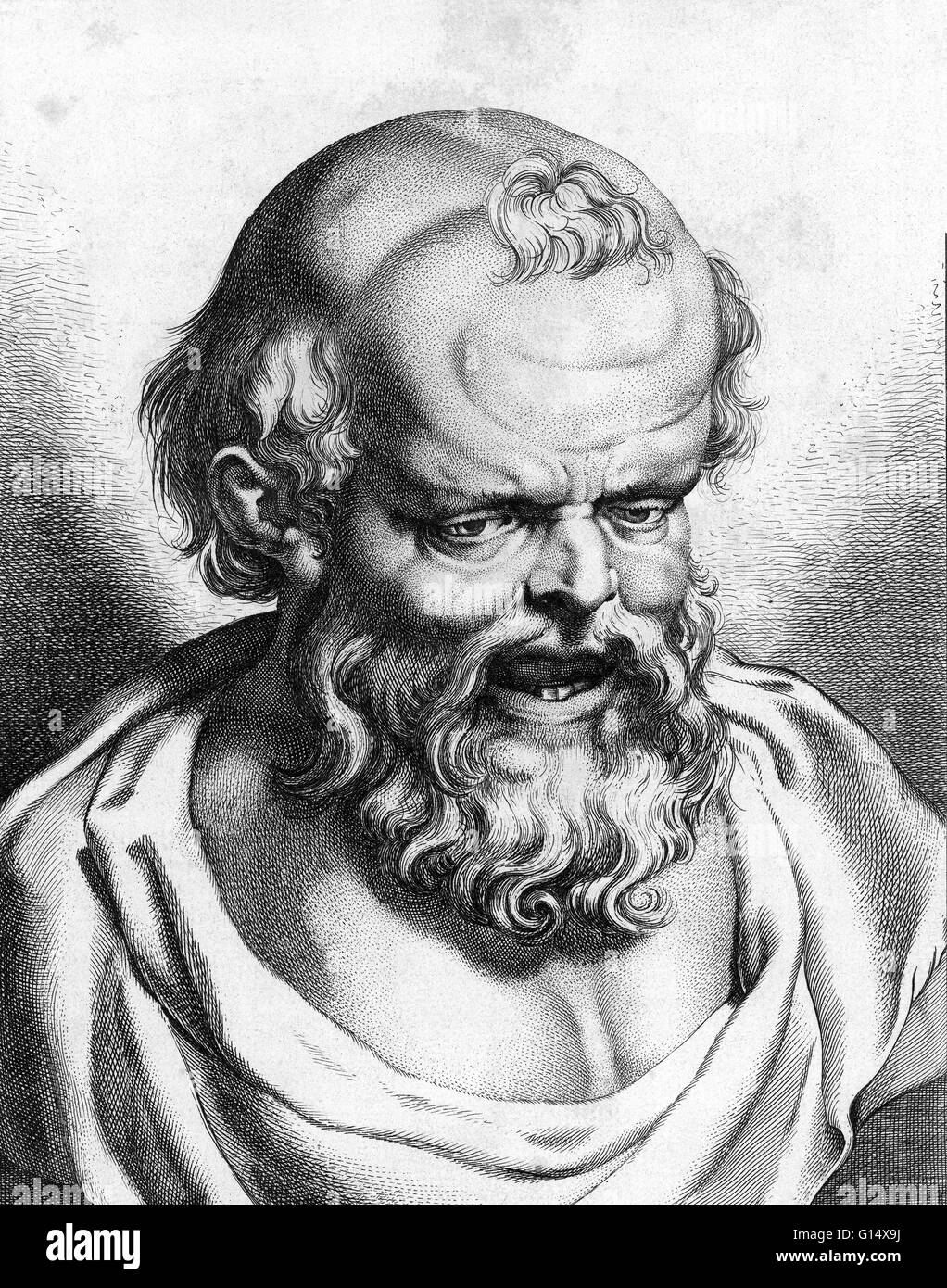 Democritus of Abdera (472/457-370/360 BC) pre-Socratic Greek philosopher and the father of atomic theory. Democritus published works on ethics, physics, mathematics, cosmology and music. Very little has survived but his theories are known through commenta Stock Photohttps://www.alamy.com/image-license-details/?v=1https://www.alamy.com/stock-photo-democritus-of-abdera-472457-370360-bc-pre-socratic-greek-philosopher-103985326.html
Democritus of Abdera (472/457-370/360 BC) pre-Socratic Greek philosopher and the father of atomic theory. Democritus published works on ethics, physics, mathematics, cosmology and music. Very little has survived but his theories are known through commenta Stock Photohttps://www.alamy.com/image-license-details/?v=1https://www.alamy.com/stock-photo-democritus-of-abdera-472457-370360-bc-pre-socratic-greek-philosopher-103985326.htmlRMG14X9J–Democritus of Abdera (472/457-370/360 BC) pre-Socratic Greek philosopher and the father of atomic theory. Democritus published works on ethics, physics, mathematics, cosmology and music. Very little has survived but his theories are known through commenta
 Deer hunting depicted in the Lucanian fresco from 370-360 BC from the Tomb 18 of the Andriuolo Necropolis on display in the Paestum Archaeological Museum (Museo archeologico di Paestum) in Paestum, Campania, Italy. Stock Photohttps://www.alamy.com/image-license-details/?v=1https://www.alamy.com/deer-hunting-depicted-in-the-lucanian-fresco-from-370-360-bc-from-the-tomb-18-of-the-andriuolo-necropolis-on-display-in-the-paestum-archaeological-museum-museo-archeologico-di-paestum-in-paestum-campania-italy-image179711759.html
Deer hunting depicted in the Lucanian fresco from 370-360 BC from the Tomb 18 of the Andriuolo Necropolis on display in the Paestum Archaeological Museum (Museo archeologico di Paestum) in Paestum, Campania, Italy. Stock Photohttps://www.alamy.com/image-license-details/?v=1https://www.alamy.com/deer-hunting-depicted-in-the-lucanian-fresco-from-370-360-bc-from-the-tomb-18-of-the-andriuolo-necropolis-on-display-in-the-paestum-archaeological-museum-museo-archeologico-di-paestum-in-paestum-campania-italy-image179711759.htmlRMMCAG53–Deer hunting depicted in the Lucanian fresco from 370-360 BC from the Tomb 18 of the Andriuolo Necropolis on display in the Paestum Archaeological Museum (Museo archeologico di Paestum) in Paestum, Campania, Italy.
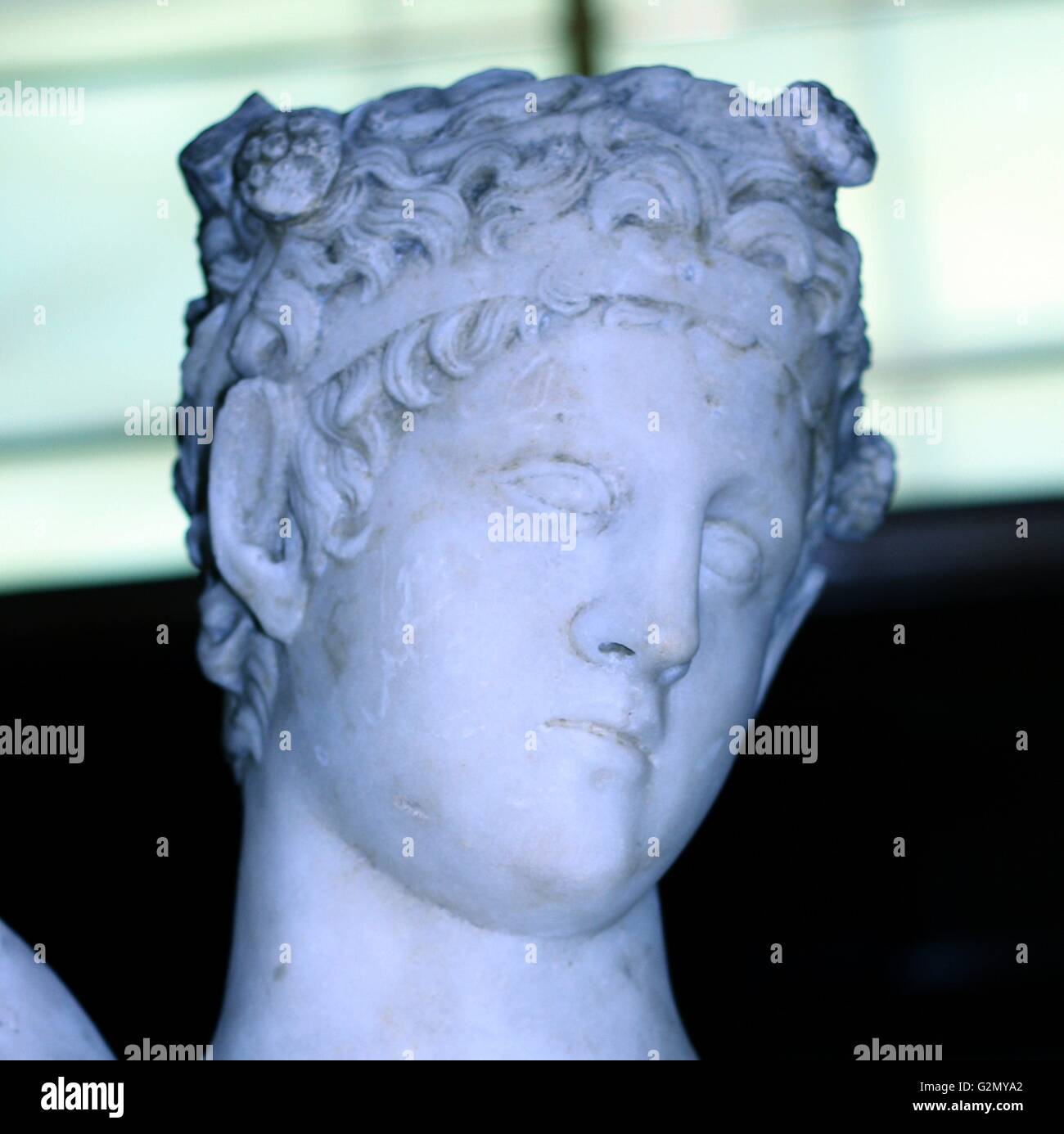 Satyr. Roman copy of a Greek original by the sculptor Praxiteles of about 360 BC Stock Photohttps://www.alamy.com/image-license-details/?v=1https://www.alamy.com/stock-photo-satyr-roman-copy-of-a-greek-original-by-the-sculptor-praxiteles-of-104952010.html
Satyr. Roman copy of a Greek original by the sculptor Praxiteles of about 360 BC Stock Photohttps://www.alamy.com/image-license-details/?v=1https://www.alamy.com/stock-photo-satyr-roman-copy-of-a-greek-original-by-the-sculptor-praxiteles-of-104952010.htmlRMG2MYA2–Satyr. Roman copy of a Greek original by the sculptor Praxiteles of about 360 BC
 Votive stele depicting a sacrificial procession to Dionysus and Artemis for the win in a contest of theater. Votive offering, ca. 360 BC. Glyptothek. Munich. Germany. Stock Photohttps://www.alamy.com/image-license-details/?v=1https://www.alamy.com/votive-stele-depicting-a-sacrificial-procession-to-dionysus-and-artemis-for-the-win-in-a-contest-of-theater-votive-offering-ca-360-bc-glyptothek-munich-germany-image220442095.html
Votive stele depicting a sacrificial procession to Dionysus and Artemis for the win in a contest of theater. Votive offering, ca. 360 BC. Glyptothek. Munich. Germany. Stock Photohttps://www.alamy.com/image-license-details/?v=1https://www.alamy.com/votive-stele-depicting-a-sacrificial-procession-to-dionysus-and-artemis-for-the-win-in-a-contest-of-theater-votive-offering-ca-360-bc-glyptothek-munich-germany-image220442095.htmlRMPPJ03Y–Votive stele depicting a sacrificial procession to Dionysus and Artemis for the win in a contest of theater. Votive offering, ca. 360 BC. Glyptothek. Munich. Germany.
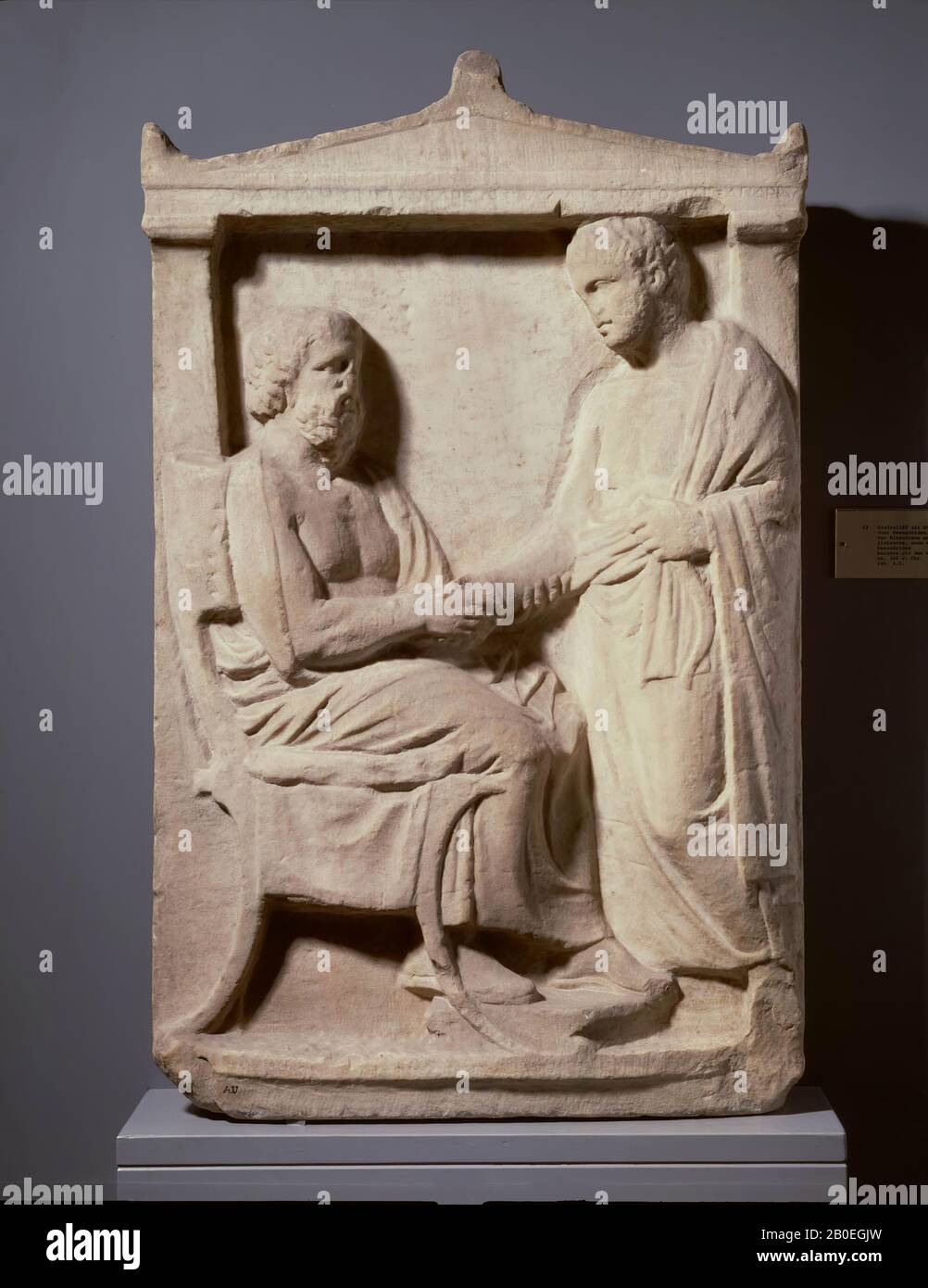 Attic grave relief with representation of a seated, old man and a standing, younger man. The standing man wears a strigilis. Inscription gives both names: Dexandrides and Kallistratos., Sculpture, grave relief, naïsos, marble, 104 x 65 cm, 192 kg, c. 360 BC, Greece Stock Photohttps://www.alamy.com/image-license-details/?v=1https://www.alamy.com/attic-grave-relief-with-representation-of-a-seated-old-man-and-a-standing-younger-man-the-standing-man-wears-a-strigilis-inscription-gives-both-names-dexandrides-and-kallistratos-sculpture-grave-relief-nasos-marble-104-x-65-cm-192-kg-c-360-bc-greece-image344527761.html
Attic grave relief with representation of a seated, old man and a standing, younger man. The standing man wears a strigilis. Inscription gives both names: Dexandrides and Kallistratos., Sculpture, grave relief, naïsos, marble, 104 x 65 cm, 192 kg, c. 360 BC, Greece Stock Photohttps://www.alamy.com/image-license-details/?v=1https://www.alamy.com/attic-grave-relief-with-representation-of-a-seated-old-man-and-a-standing-younger-man-the-standing-man-wears-a-strigilis-inscription-gives-both-names-dexandrides-and-kallistratos-sculpture-grave-relief-nasos-marble-104-x-65-cm-192-kg-c-360-bc-greece-image344527761.htmlRM2B0EGJW–Attic grave relief with representation of a seated, old man and a standing, younger man. The standing man wears a strigilis. Inscription gives both names: Dexandrides and Kallistratos., Sculpture, grave relief, naïsos, marble, 104 x 65 cm, 192 kg, c. 360 BC, Greece
 Naples. Italy. Archidamus III, King of Sparta (360 BC-338 BC) Roman bust (late 1st C AD), from Villa of the Papyri, Herculaneum. Stock Photohttps://www.alamy.com/image-license-details/?v=1https://www.alamy.com/stock-photo-naples-italy-archidamus-iii-king-of-sparta-360-bc-338-bc-roman-bust-124493727.html
Naples. Italy. Archidamus III, King of Sparta (360 BC-338 BC) Roman bust (late 1st C AD), from Villa of the Papyri, Herculaneum. Stock Photohttps://www.alamy.com/image-license-details/?v=1https://www.alamy.com/stock-photo-naples-italy-archidamus-iii-king-of-sparta-360-bc-338-bc-roman-bust-124493727.htmlRMH6F50F–Naples. Italy. Archidamus III, King of Sparta (360 BC-338 BC) Roman bust (late 1st C AD), from Villa of the Papyri, Herculaneum.
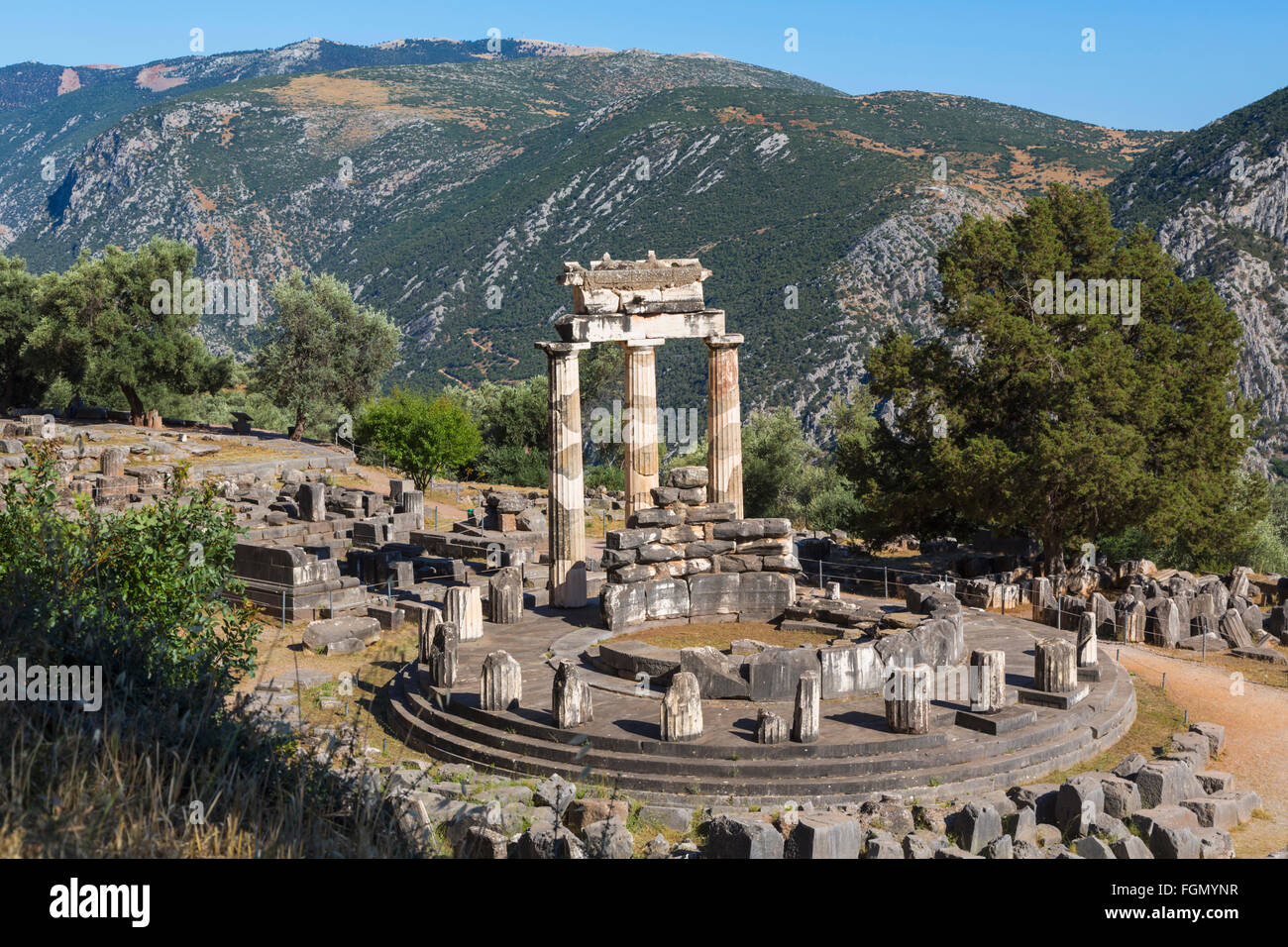 Delphi, Phocis, Greece. The tholos, dating from around 380-360 BC, beside the Sanctuary of Athena Pronaia. Stock Photohttps://www.alamy.com/image-license-details/?v=1https://www.alamy.com/stock-photo-delphi-phocis-greece-the-tholos-dating-from-around-380-360-bc-beside-96347155.html
Delphi, Phocis, Greece. The tholos, dating from around 380-360 BC, beside the Sanctuary of Athena Pronaia. Stock Photohttps://www.alamy.com/image-license-details/?v=1https://www.alamy.com/stock-photo-delphi-phocis-greece-the-tholos-dating-from-around-380-360-bc-beside-96347155.htmlRMFGMYNR–Delphi, Phocis, Greece. The tholos, dating from around 380-360 BC, beside the Sanctuary of Athena Pronaia.
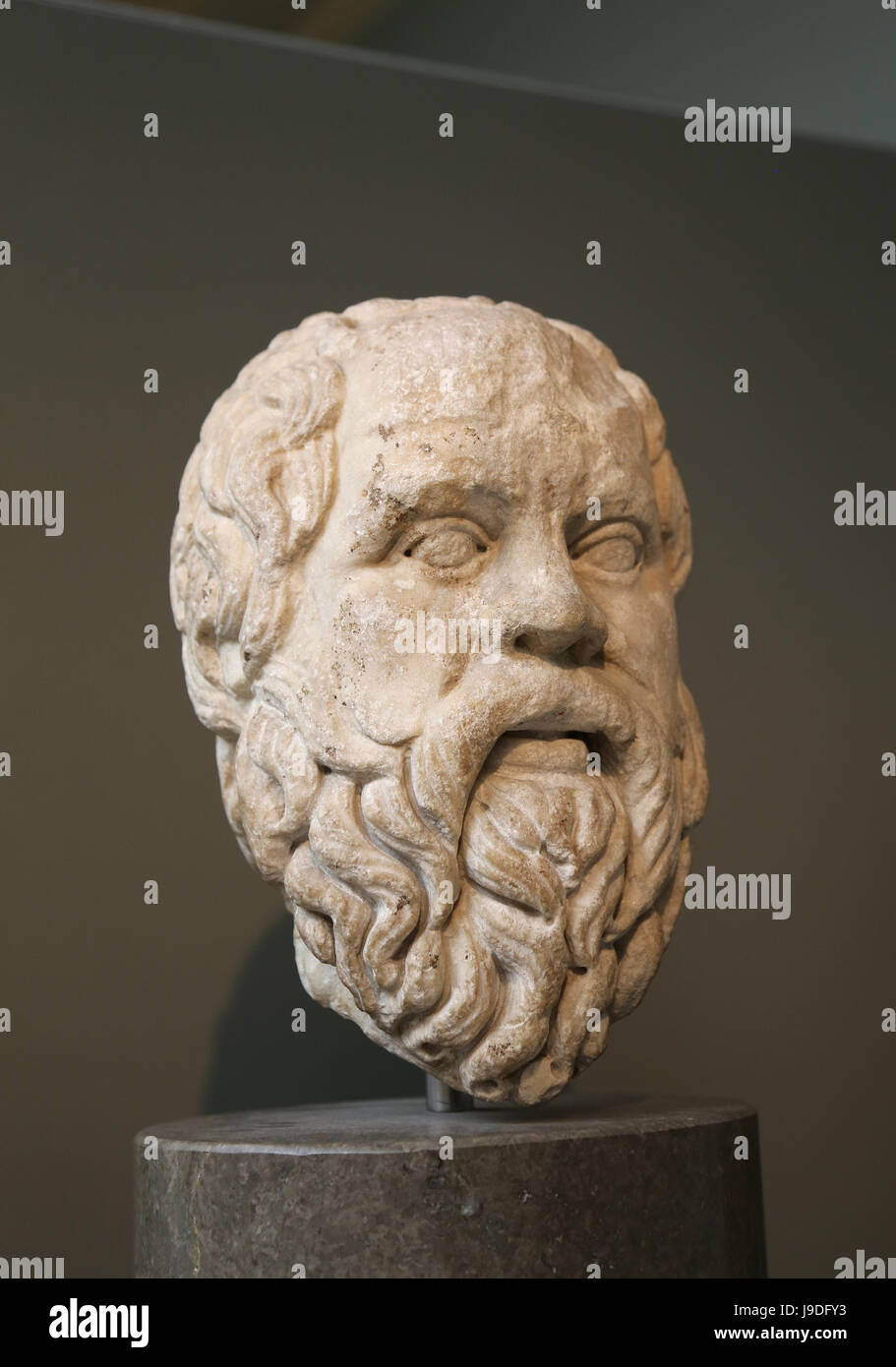 Socrates (469-399 BC). Classical Greek philosopher. Roman copy of Greek original, 380-360 BC. British Museum. London. United Kingdom. Stock Photohttps://www.alamy.com/image-license-details/?v=1https://www.alamy.com/stock-photo-socrates-469-399-bc-classical-greek-philosopher-roman-copy-of-greek-143512743.html
Socrates (469-399 BC). Classical Greek philosopher. Roman copy of Greek original, 380-360 BC. British Museum. London. United Kingdom. Stock Photohttps://www.alamy.com/image-license-details/?v=1https://www.alamy.com/stock-photo-socrates-469-399-bc-classical-greek-philosopher-roman-copy-of-greek-143512743.htmlRMJ9DFY3–Socrates (469-399 BC). Classical Greek philosopher. Roman copy of Greek original, 380-360 BC. British Museum. London. United Kingdom.
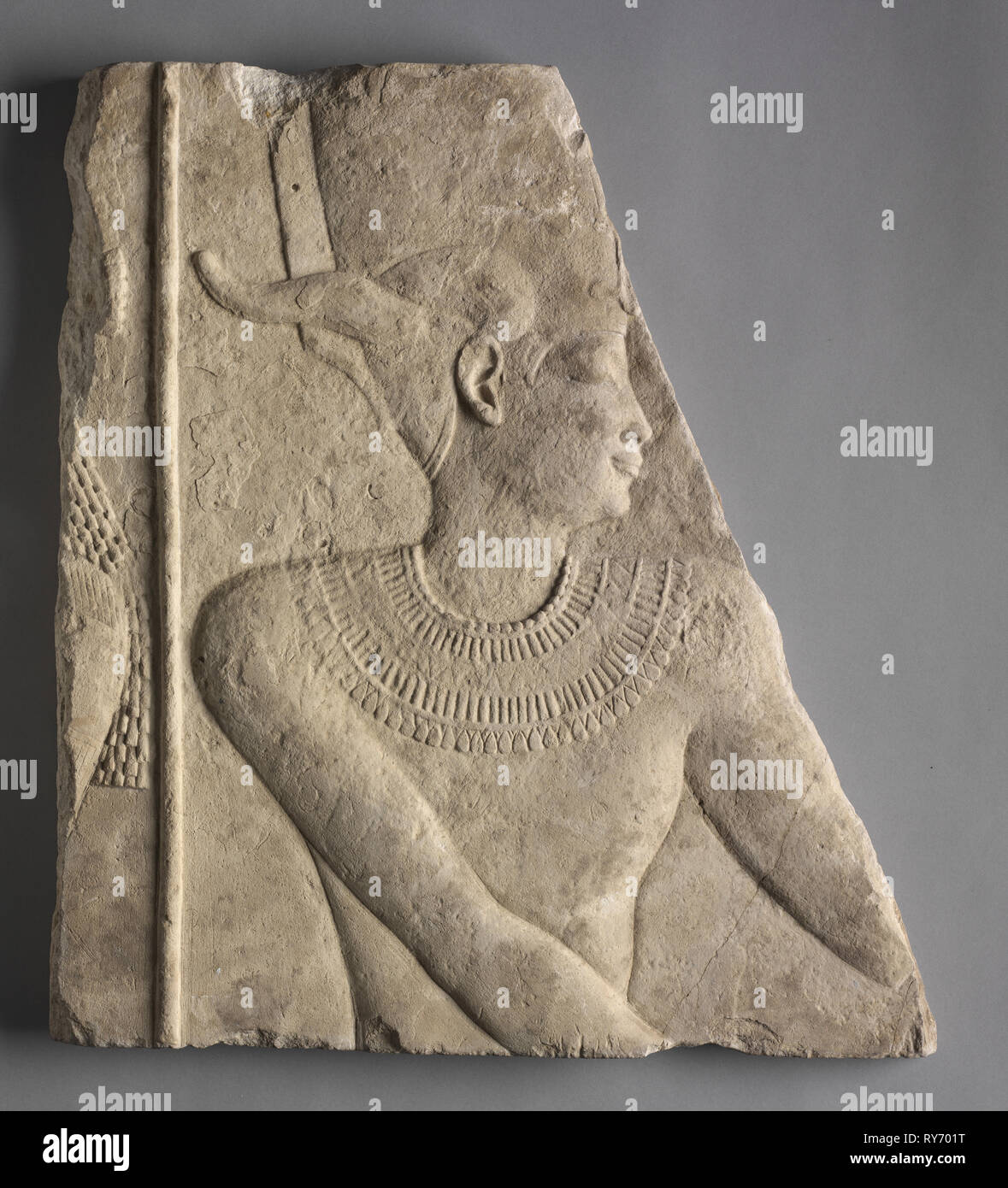 Temple Relief of a Deity, 360-246 BC. Egypt, Greco-Roman Period, Late Dynasty30 to early Ptolemaic Dynasty. Limestone; overall: 47.3 x 41 cm (18 5/8 x 16 1/8 in Stock Photohttps://www.alamy.com/image-license-details/?v=1https://www.alamy.com/temple-relief-of-a-deity-360-246-bc-egypt-greco-roman-period-late-dynasty30-to-early-ptolemaic-dynasty-limestone-overall-473-x-41-cm-18-58-x-16-18-in-image240484212.html
Temple Relief of a Deity, 360-246 BC. Egypt, Greco-Roman Period, Late Dynasty30 to early Ptolemaic Dynasty. Limestone; overall: 47.3 x 41 cm (18 5/8 x 16 1/8 in Stock Photohttps://www.alamy.com/image-license-details/?v=1https://www.alamy.com/temple-relief-of-a-deity-360-246-bc-egypt-greco-roman-period-late-dynasty30-to-early-ptolemaic-dynasty-limestone-overall-473-x-41-cm-18-58-x-16-18-in-image240484212.htmlRMRY701T–Temple Relief of a Deity, 360-246 BC. Egypt, Greco-Roman Period, Late Dynasty30 to early Ptolemaic Dynasty. Limestone; overall: 47.3 x 41 cm (18 5/8 x 16 1/8 in
 Young people next to a rock and a tree. Krater made in Puglia, from Ruvo di Puglia. By York Painter, 380-360 BC. Jatta National Archaeological Museum. Ruvo di Puglia. Italy. Stock Photohttps://www.alamy.com/image-license-details/?v=1https://www.alamy.com/stock-photo-young-people-next-to-a-rock-and-a-tree-krater-made-in-puglia-from-133593046.html
Young people next to a rock and a tree. Krater made in Puglia, from Ruvo di Puglia. By York Painter, 380-360 BC. Jatta National Archaeological Museum. Ruvo di Puglia. Italy. Stock Photohttps://www.alamy.com/image-license-details/?v=1https://www.alamy.com/stock-photo-young-people-next-to-a-rock-and-a-tree-krater-made-in-puglia-from-133593046.htmlRMHN9K86–Young people next to a rock and a tree. Krater made in Puglia, from Ruvo di Puglia. By York Painter, 380-360 BC. Jatta National Archaeological Museum. Ruvo di Puglia. Italy.
 Greece, East Macedonia and Thrace Region, Philippi, ruins of ancient city founded in 360 BC, view of the Forum Stock Photohttps://www.alamy.com/image-license-details/?v=1https://www.alamy.com/stock-photo-greece-east-macedonia-and-thrace-region-philippi-ruins-of-ancient-149612721.html
Greece, East Macedonia and Thrace Region, Philippi, ruins of ancient city founded in 360 BC, view of the Forum Stock Photohttps://www.alamy.com/image-license-details/?v=1https://www.alamy.com/stock-photo-greece-east-macedonia-and-thrace-region-philippi-ruins-of-ancient-149612721.htmlRMJKBCFD–Greece, East Macedonia and Thrace Region, Philippi, ruins of ancient city founded in 360 BC, view of the Forum
 Socrates (470-399 BC). Classical Greek philosopher. Roman copy from a Greek original bust, 380-360 BC. British Museum. London, England. Stock Photohttps://www.alamy.com/image-license-details/?v=1https://www.alamy.com/socrates-470-399-bc-classical-greek-philosopher-roman-copy-from-a-greek-original-bust-380-360-bc-british-museum-london-england-image178452986.html
Socrates (470-399 BC). Classical Greek philosopher. Roman copy from a Greek original bust, 380-360 BC. British Museum. London, England. Stock Photohttps://www.alamy.com/image-license-details/?v=1https://www.alamy.com/socrates-470-399-bc-classical-greek-philosopher-roman-copy-from-a-greek-original-bust-380-360-bc-british-museum-london-england-image178452986.htmlRMMA96GX–Socrates (470-399 BC). Classical Greek philosopher. Roman copy from a Greek original bust, 380-360 BC. British Museum. London, England.
 attributed to Thyrsus Painter, Greek, Red-figure Trefoil Oinochoe, 360/340 BC, Red-figure ware, 5 1/4 x 3 7/8 x 3 3/4 in. (13.3 x 9.8 x 9.5 cm Stock Photohttps://www.alamy.com/image-license-details/?v=1https://www.alamy.com/attributed-to-thyrsus-painter-greek-red-figure-trefoil-oinochoe-360340-bc-red-figure-ware-5-14-x-3-78-x-3-34-in-133-x-98-x-95-cm-image328731348.html
attributed to Thyrsus Painter, Greek, Red-figure Trefoil Oinochoe, 360/340 BC, Red-figure ware, 5 1/4 x 3 7/8 x 3 3/4 in. (13.3 x 9.8 x 9.5 cm Stock Photohttps://www.alamy.com/image-license-details/?v=1https://www.alamy.com/attributed-to-thyrsus-painter-greek-red-figure-trefoil-oinochoe-360340-bc-red-figure-ware-5-14-x-3-78-x-3-34-in-133-x-98-x-95-cm-image328731348.htmlRM2A2R058–attributed to Thyrsus Painter, Greek, Red-figure Trefoil Oinochoe, 360/340 BC, Red-figure ware, 5 1/4 x 3 7/8 x 3 3/4 in. (13.3 x 9.8 x 9.5 cm
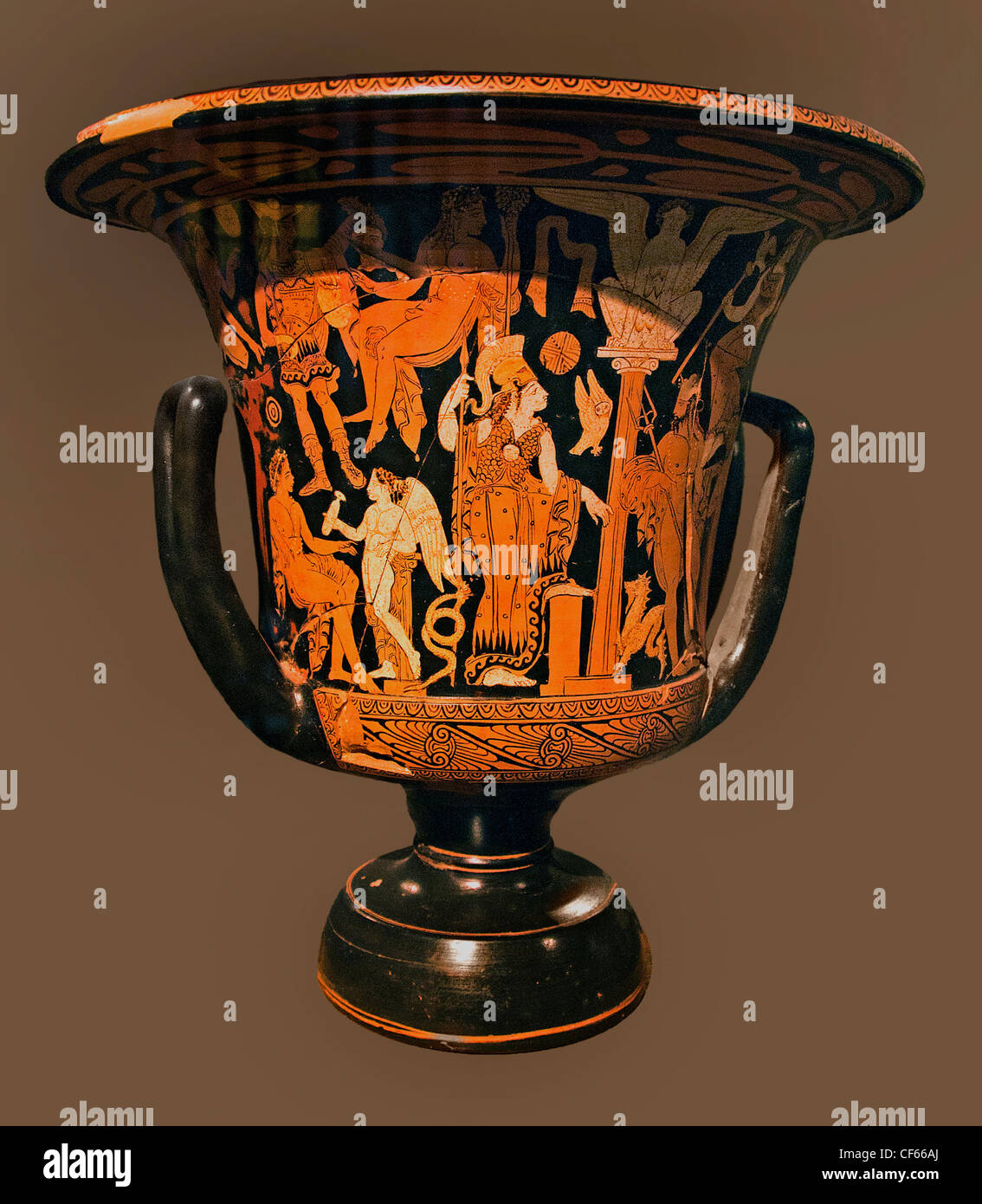 Athena Poseidon gods Chalice krater 360 BC Faliscan Etruscan Italy Italian Stock Photohttps://www.alamy.com/image-license-details/?v=1https://www.alamy.com/stock-photo-athena-poseidon-gods-chalice-krater-360-bc-faliscan-etruscan-italy-43777290.html
Athena Poseidon gods Chalice krater 360 BC Faliscan Etruscan Italy Italian Stock Photohttps://www.alamy.com/image-license-details/?v=1https://www.alamy.com/stock-photo-athena-poseidon-gods-chalice-krater-360-bc-faliscan-etruscan-italy-43777290.htmlRMCF66AJ–Athena Poseidon gods Chalice krater 360 BC Faliscan Etruscan Italy Italian
 Shawabty of Nectanebo II, 360-342 BC. Egypt, Late Period, Dynasty 30, reign of Nectanebo II. Pale turquoise faience; overall: 19 x 6.1 x 3.8 cm (7 1/2 x 2 3/8 x 1 1/2 in Stock Photohttps://www.alamy.com/image-license-details/?v=1https://www.alamy.com/shawabty-of-nectanebo-ii-360-342-bc-egypt-late-period-dynasty-30-reign-of-nectanebo-ii-pale-turquoise-faience-overall-19-x-61-x-38-cm-7-12-x-2-38-x-1-12-in-image240367481.html
Shawabty of Nectanebo II, 360-342 BC. Egypt, Late Period, Dynasty 30, reign of Nectanebo II. Pale turquoise faience; overall: 19 x 6.1 x 3.8 cm (7 1/2 x 2 3/8 x 1 1/2 in Stock Photohttps://www.alamy.com/image-license-details/?v=1https://www.alamy.com/shawabty-of-nectanebo-ii-360-342-bc-egypt-late-period-dynasty-30-reign-of-nectanebo-ii-pale-turquoise-faience-overall-19-x-61-x-38-cm-7-12-x-2-38-x-1-12-in-image240367481.htmlRMRY1K4W–Shawabty of Nectanebo II, 360-342 BC. Egypt, Late Period, Dynasty 30, reign of Nectanebo II. Pale turquoise faience; overall: 19 x 6.1 x 3.8 cm (7 1/2 x 2 3/8 x 1 1/2 in
 Funerary relief young man hunter holding a throwing weapon for hare hunting, his dog next to him. Attica 360 BC. Greek Greece Stock Photohttps://www.alamy.com/image-license-details/?v=1https://www.alamy.com/funerary-relief-young-man-hunter-holding-a-throwing-weapon-for-hare-image65398915.html
Funerary relief young man hunter holding a throwing weapon for hare hunting, his dog next to him. Attica 360 BC. Greek Greece Stock Photohttps://www.alamy.com/image-license-details/?v=1https://www.alamy.com/funerary-relief-young-man-hunter-holding-a-throwing-weapon-for-hare-image65398915.htmlRMDPB4YF–Funerary relief young man hunter holding a throwing weapon for hare hunting, his dog next to him. Attica 360 BC. Greek Greece
 Greece, East Macedonia and Thrace Region, Philippi, ruins of ancient city founded in 360 BC, Basilica B Stock Photohttps://www.alamy.com/image-license-details/?v=1https://www.alamy.com/greece-east-macedonia-and-thrace-region-philippi-ruins-of-ancient-city-founded-in-360-bc-basilica-b-image259649662.html
Greece, East Macedonia and Thrace Region, Philippi, ruins of ancient city founded in 360 BC, Basilica B Stock Photohttps://www.alamy.com/image-license-details/?v=1https://www.alamy.com/greece-east-macedonia-and-thrace-region-philippi-ruins-of-ancient-city-founded-in-360-bc-basilica-b-image259649662.htmlRMW2C1P6–Greece, East Macedonia and Thrace Region, Philippi, ruins of ancient city founded in 360 BC, Basilica B
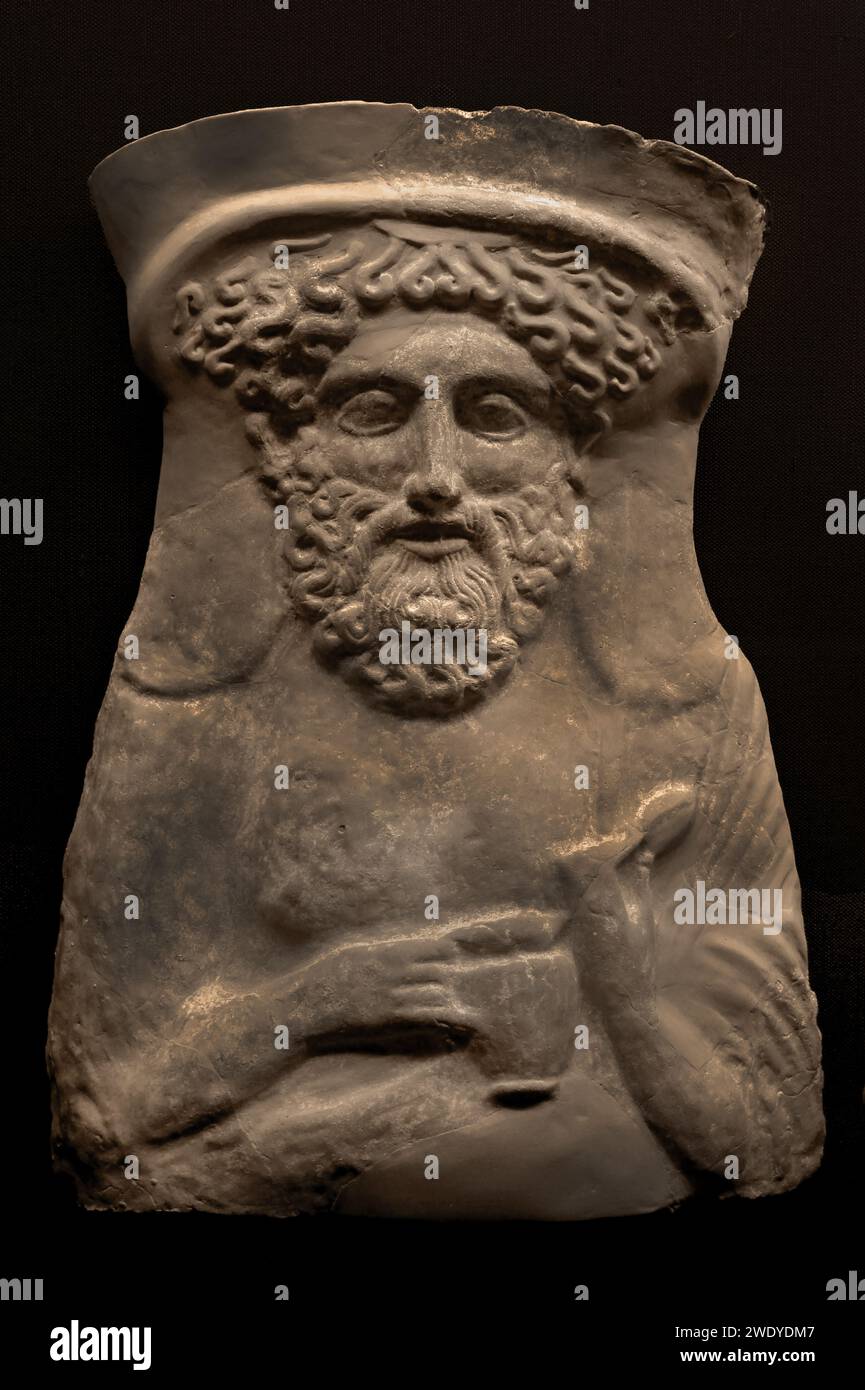 Benaki MuseumThis terracotta bust of the Greek God Dionysos dates to 380-360 BC. He is wearing a stephane (a type of metal upturned hairband) in his hair and is holding an egg in his left hand, and wine jug on his right. Athens Greece. Stock Photohttps://www.alamy.com/image-license-details/?v=1https://www.alamy.com/benaki-museumthis-terracotta-bust-of-the-greek-god-dionysos-dates-to-380-360-bc-he-is-wearing-a-stephane-a-type-of-metal-upturned-hairband-in-his-hair-and-is-holding-an-egg-in-his-left-hand-and-wine-jug-on-his-right-athens-greece-image593746503.html
Benaki MuseumThis terracotta bust of the Greek God Dionysos dates to 380-360 BC. He is wearing a stephane (a type of metal upturned hairband) in his hair and is holding an egg in his left hand, and wine jug on his right. Athens Greece. Stock Photohttps://www.alamy.com/image-license-details/?v=1https://www.alamy.com/benaki-museumthis-terracotta-bust-of-the-greek-god-dionysos-dates-to-380-360-bc-he-is-wearing-a-stephane-a-type-of-metal-upturned-hairband-in-his-hair-and-is-holding-an-egg-in-his-left-hand-and-wine-jug-on-his-right-athens-greece-image593746503.htmlRM2WDYDM7–Benaki MuseumThis terracotta bust of the Greek God Dionysos dates to 380-360 BC. He is wearing a stephane (a type of metal upturned hairband) in his hair and is holding an egg in his left hand, and wine jug on his right. Athens Greece.
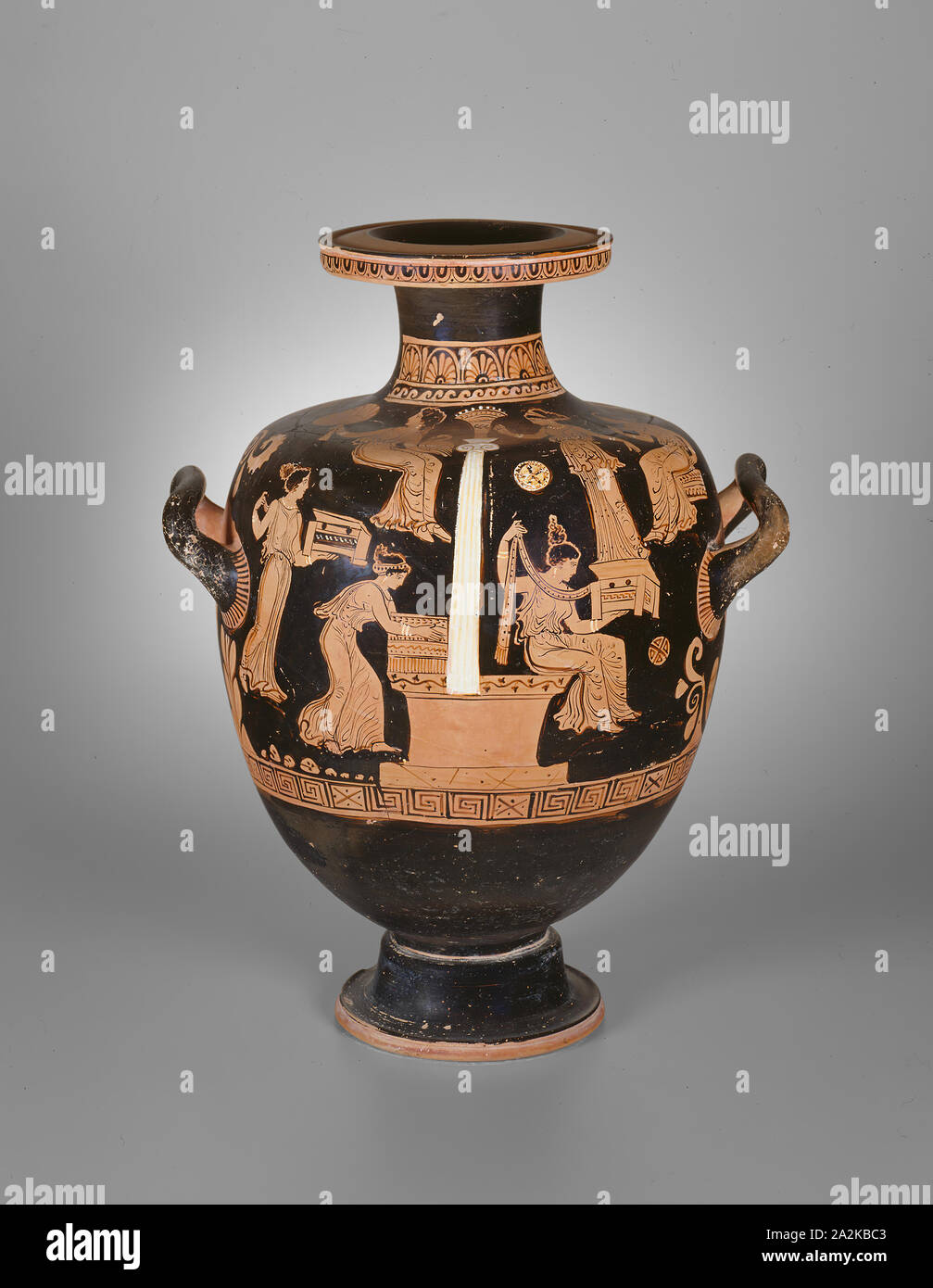 Hydria (Water Jar), 360/350 BC, Attributed to the Iliupersis Painter, Greek, Apulia, Italy, Puglia, terracotta, decorated in the red-figure technique, 53 × 41.2 × 34.2 cm (20 7/8 × 16 1/4 × 13 1/2 in Stock Photohttps://www.alamy.com/image-license-details/?v=1https://www.alamy.com/hydria-water-jar-360350-bc-attributed-to-the-iliupersis-painter-greek-apulia-italy-puglia-terracotta-decorated-in-the-red-figure-technique-53-412-342-cm-20-78-16-14-13-12-in-image328652355.html
Hydria (Water Jar), 360/350 BC, Attributed to the Iliupersis Painter, Greek, Apulia, Italy, Puglia, terracotta, decorated in the red-figure technique, 53 × 41.2 × 34.2 cm (20 7/8 × 16 1/4 × 13 1/2 in Stock Photohttps://www.alamy.com/image-license-details/?v=1https://www.alamy.com/hydria-water-jar-360350-bc-attributed-to-the-iliupersis-painter-greek-apulia-italy-puglia-terracotta-decorated-in-the-red-figure-technique-53-412-342-cm-20-78-16-14-13-12-in-image328652355.htmlRM2A2KBC3–Hydria (Water Jar), 360/350 BC, Attributed to the Iliupersis Painter, Greek, Apulia, Italy, Puglia, terracotta, decorated in the red-figure technique, 53 × 41.2 × 34.2 cm (20 7/8 × 16 1/4 × 13 1/2 in
 Democritus of Abdera (472/457-370/360 BC) pre-Socratic Greek philosopher and the father of atomic theory. Democritus published works on ethics, physics, mathematics, cosmology and music. Very little has survived but his theories are known through commenta Stock Photohttps://www.alamy.com/image-license-details/?v=1https://www.alamy.com/stock-photo-democritus-of-abdera-472457-370360-bc-pre-socratic-greek-philosopher-103985828.html
Democritus of Abdera (472/457-370/360 BC) pre-Socratic Greek philosopher and the father of atomic theory. Democritus published works on ethics, physics, mathematics, cosmology and music. Very little has survived but his theories are known through commenta Stock Photohttps://www.alamy.com/image-license-details/?v=1https://www.alamy.com/stock-photo-democritus-of-abdera-472457-370360-bc-pre-socratic-greek-philosopher-103985828.htmlRMG14XYG–Democritus of Abdera (472/457-370/360 BC) pre-Socratic Greek philosopher and the father of atomic theory. Democritus published works on ethics, physics, mathematics, cosmology and music. Very little has survived but his theories are known through commenta
 Deer hunting depicted in the Lucanian fresco from 370-360 BC from the Tomb 18 of the Andriuolo Necropolis on display in the Paestum Archaeological Museum (Museo archeologico di Paestum) in Paestum, Campania, Italy. Stock Photohttps://www.alamy.com/image-license-details/?v=1https://www.alamy.com/deer-hunting-depicted-in-the-lucanian-fresco-from-370-360-bc-from-the-tomb-18-of-the-andriuolo-necropolis-on-display-in-the-paestum-archaeological-museum-museo-archeologico-di-paestum-in-paestum-campania-italy-image179688808.html
Deer hunting depicted in the Lucanian fresco from 370-360 BC from the Tomb 18 of the Andriuolo Necropolis on display in the Paestum Archaeological Museum (Museo archeologico di Paestum) in Paestum, Campania, Italy. Stock Photohttps://www.alamy.com/image-license-details/?v=1https://www.alamy.com/deer-hunting-depicted-in-the-lucanian-fresco-from-370-360-bc-from-the-tomb-18-of-the-andriuolo-necropolis-on-display-in-the-paestum-archaeological-museum-museo-archeologico-di-paestum-in-paestum-campania-italy-image179688808.htmlRMMC9EWC–Deer hunting depicted in the Lucanian fresco from 370-360 BC from the Tomb 18 of the Andriuolo Necropolis on display in the Paestum Archaeological Museum (Museo archeologico di Paestum) in Paestum, Campania, Italy.
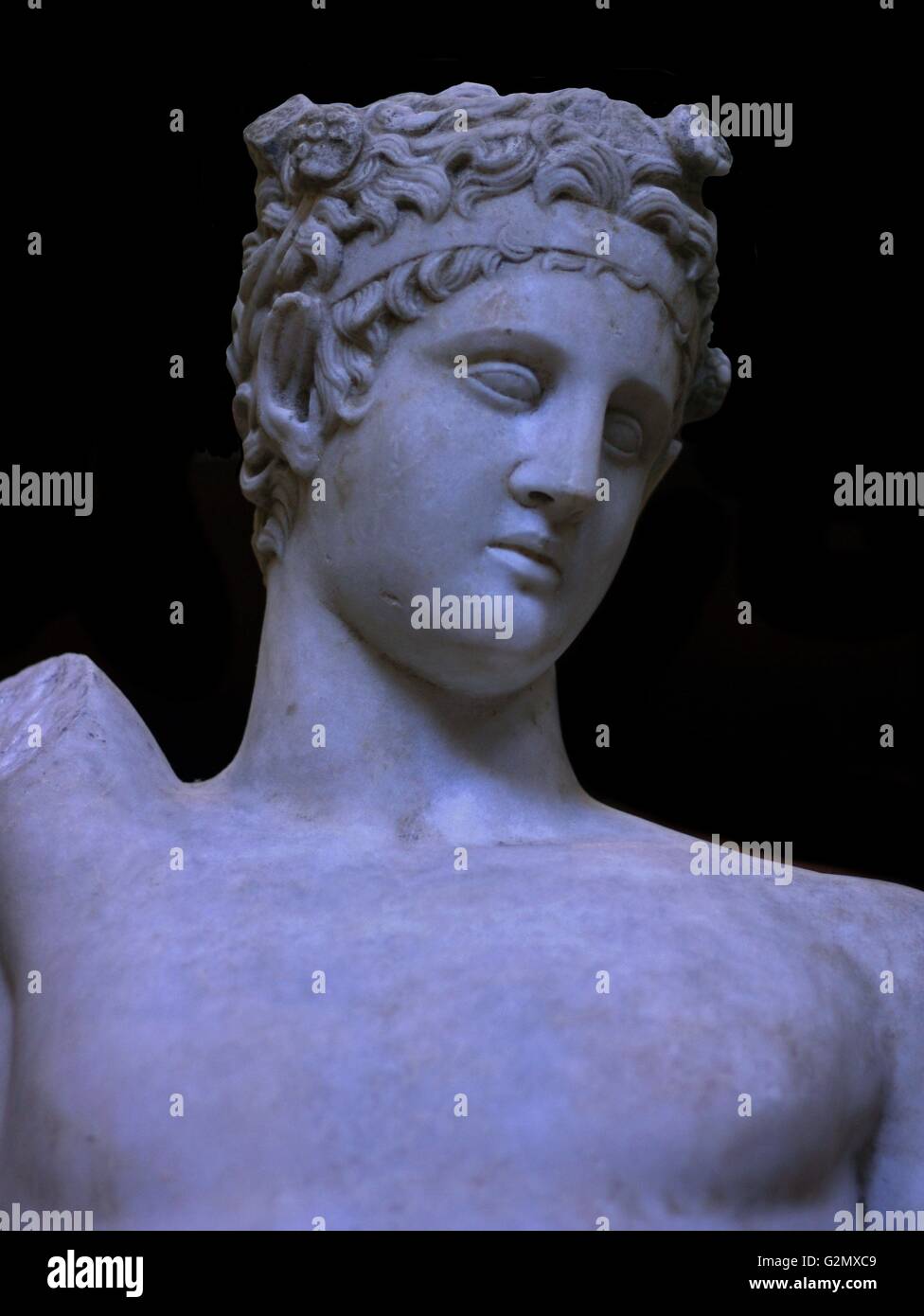 Satyr. Roman copy of a Greek original by the sculptor Praxiteles of about 360 BC Stock Photohttps://www.alamy.com/image-license-details/?v=1https://www.alamy.com/stock-photo-satyr-roman-copy-of-a-greek-original-by-the-sculptor-praxiteles-of-104951289.html
Satyr. Roman copy of a Greek original by the sculptor Praxiteles of about 360 BC Stock Photohttps://www.alamy.com/image-license-details/?v=1https://www.alamy.com/stock-photo-satyr-roman-copy-of-a-greek-original-by-the-sculptor-praxiteles-of-104951289.htmlRMG2MXC9–Satyr. Roman copy of a Greek original by the sculptor Praxiteles of about 360 BC
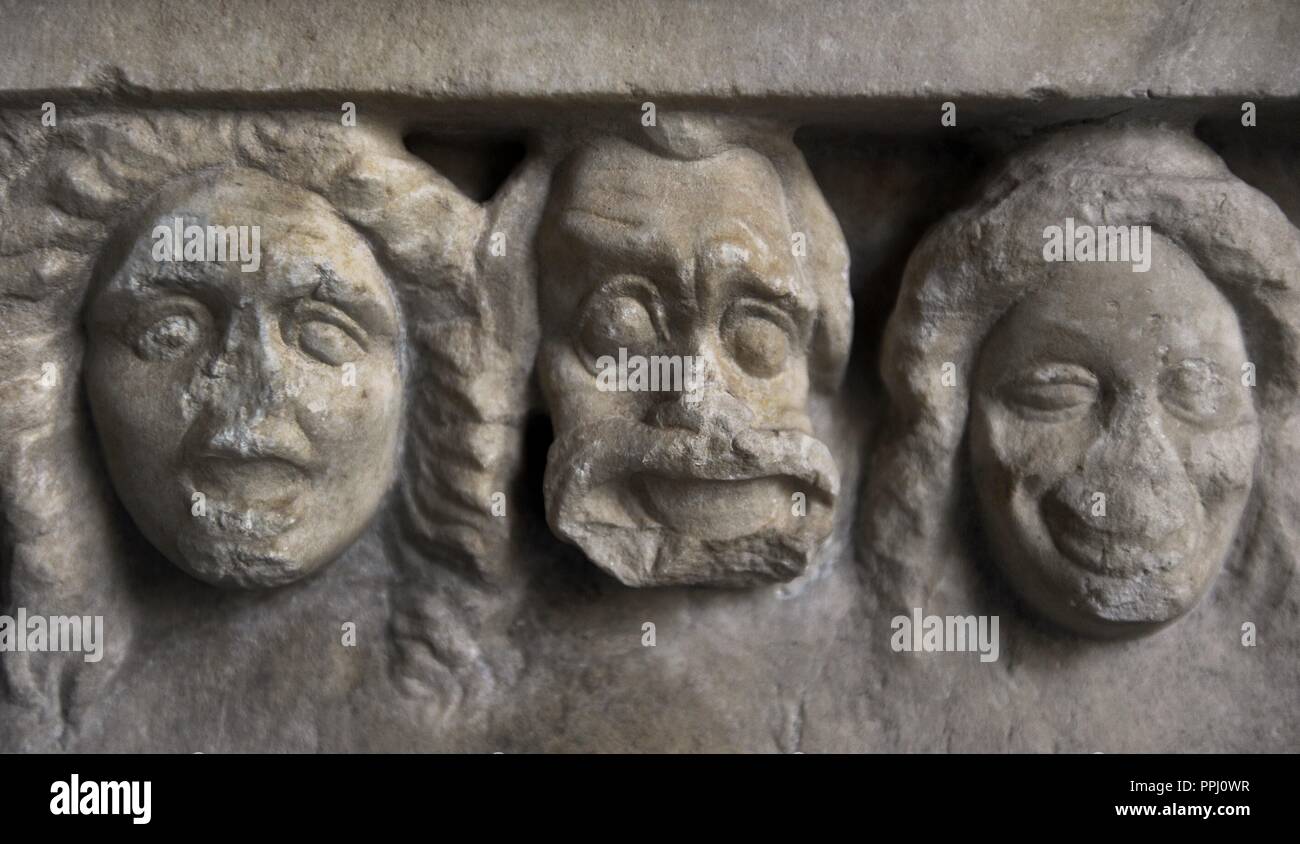 Votive stele depicting a sacrificial procession to Dionysus and Artemis for the win in a contest of theater. Votive offering, ca. 360 BC. Detail of the masks. Glyptothek. Munich. Germany. Stock Photohttps://www.alamy.com/image-license-details/?v=1https://www.alamy.com/votive-stele-depicting-a-sacrificial-procession-to-dionysus-and-artemis-for-the-win-in-a-contest-of-theater-votive-offering-ca-360-bc-detail-of-the-masks-glyptothek-munich-germany-image220442707.html
Votive stele depicting a sacrificial procession to Dionysus and Artemis for the win in a contest of theater. Votive offering, ca. 360 BC. Detail of the masks. Glyptothek. Munich. Germany. Stock Photohttps://www.alamy.com/image-license-details/?v=1https://www.alamy.com/votive-stele-depicting-a-sacrificial-procession-to-dionysus-and-artemis-for-the-win-in-a-contest-of-theater-votive-offering-ca-360-bc-detail-of-the-masks-glyptothek-munich-germany-image220442707.htmlRMPPJ0WR–Votive stele depicting a sacrificial procession to Dionysus and Artemis for the win in a contest of theater. Votive offering, ca. 360 BC. Detail of the masks. Glyptothek. Munich. Germany.
 Terracotta proteome or bust of the god Dionysus Greek 380-360 BC. The god holds an egg and a wine jug. Stock Photohttps://www.alamy.com/image-license-details/?v=1https://www.alamy.com/stock-photo-terracotta-proteome-or-bust-of-the-god-dionysus-greek-380-360-bc-the-57434850.html
Terracotta proteome or bust of the god Dionysus Greek 380-360 BC. The god holds an egg and a wine jug. Stock Photohttps://www.alamy.com/image-license-details/?v=1https://www.alamy.com/stock-photo-terracotta-proteome-or-bust-of-the-god-dionysus-greek-380-360-bc-the-57434850.htmlRMD9CAMJ–Terracotta proteome or bust of the god Dionysus Greek 380-360 BC. The god holds an egg and a wine jug.
 Archidamus III, 360 B.C. - 338 B.C., King of Sparta from 360 BC to 338 BC, portrait, bust, copy after Meta 4th century BC, National Museum of Archaeology Naples, Stock Photohttps://www.alamy.com/image-license-details/?v=1https://www.alamy.com/stock-photo-archidamus-iii-360-bc-338-bc-king-of-sparta-from-360-bc-to-338-bc-23617638.html
Archidamus III, 360 B.C. - 338 B.C., King of Sparta from 360 BC to 338 BC, portrait, bust, copy after Meta 4th century BC, National Museum of Archaeology Naples, Stock Photohttps://www.alamy.com/image-license-details/?v=1https://www.alamy.com/stock-photo-archidamus-iii-360-bc-338-bc-king-of-sparta-from-360-bc-to-338-bc-23617638.htmlRMBABTF2–Archidamus III, 360 B.C. - 338 B.C., King of Sparta from 360 BC to 338 BC, portrait, bust, copy after Meta 4th century BC, National Museum of Archaeology Naples,
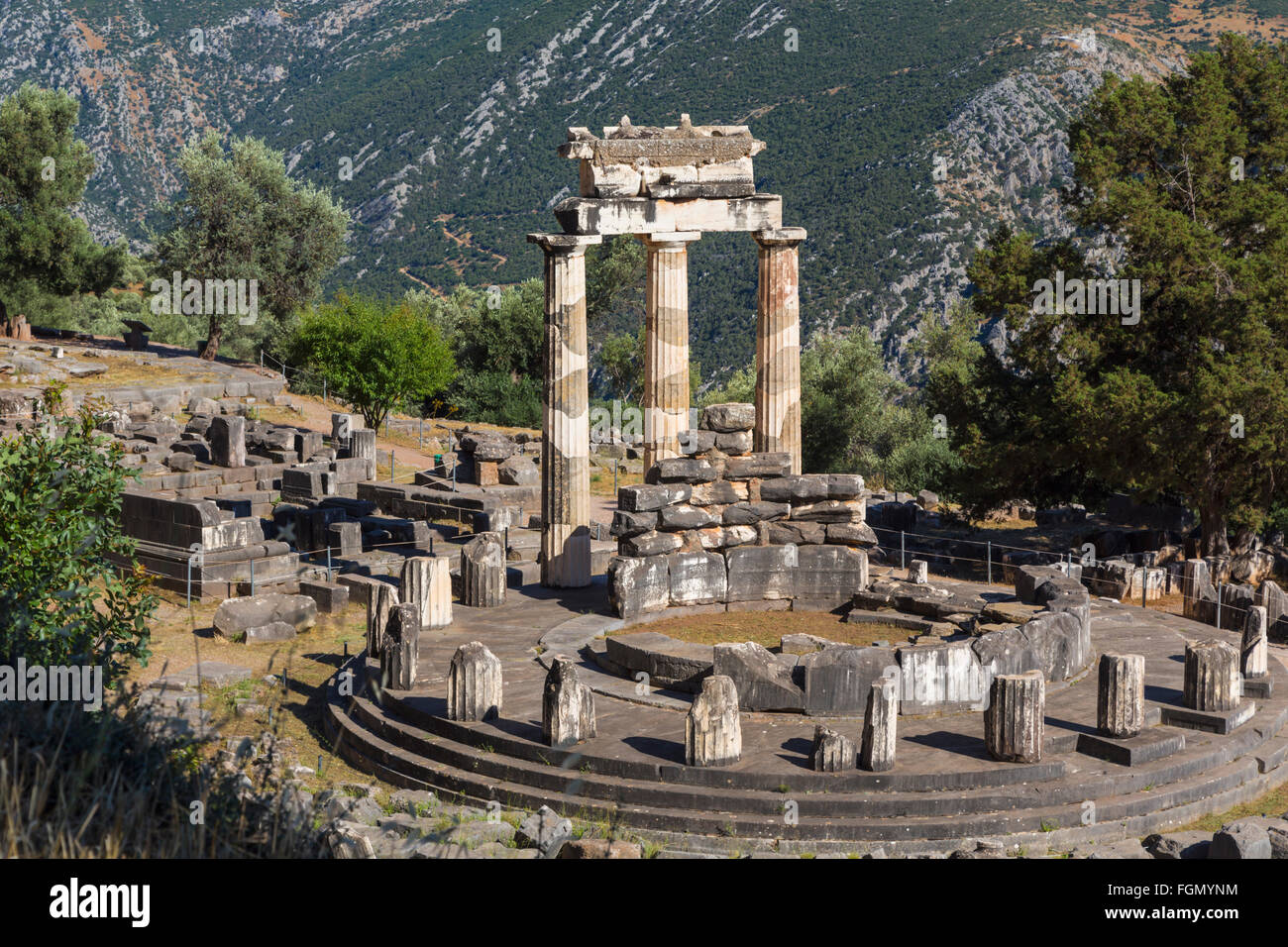 Delphi, Phocis, Greece. The tholos, dating from around 380-360 BC, beside the Sanctuary of Athena Pronaia. Stock Photohttps://www.alamy.com/image-license-details/?v=1https://www.alamy.com/stock-photo-delphi-phocis-greece-the-tholos-dating-from-around-380-360-bc-beside-96347152.html
Delphi, Phocis, Greece. The tholos, dating from around 380-360 BC, beside the Sanctuary of Athena Pronaia. Stock Photohttps://www.alamy.com/image-license-details/?v=1https://www.alamy.com/stock-photo-delphi-phocis-greece-the-tholos-dating-from-around-380-360-bc-beside-96347152.htmlRMFGMYNM–Delphi, Phocis, Greece. The tholos, dating from around 380-360 BC, beside the Sanctuary of Athena Pronaia.
 Socrates (469-399 BC). Classical Greek philosopher. Roman copy of Greek original, 380-360 BC. British Museum. London. United Kingdom. Stock Photohttps://www.alamy.com/image-license-details/?v=1https://www.alamy.com/stock-photo-socrates-469-399-bc-classical-greek-philosopher-roman-copy-of-greek-143512797.html
Socrates (469-399 BC). Classical Greek philosopher. Roman copy of Greek original, 380-360 BC. British Museum. London. United Kingdom. Stock Photohttps://www.alamy.com/image-license-details/?v=1https://www.alamy.com/stock-photo-socrates-469-399-bc-classical-greek-philosopher-roman-copy-of-greek-143512797.htmlRMJ9DG11–Socrates (469-399 BC). Classical Greek philosopher. Roman copy of Greek original, 380-360 BC. British Museum. London. United Kingdom.
 Bowl with a Scene of Preparation to the Wedding Painted on the Lid 360 BC by Ancient Greek Pottery Stock Photohttps://www.alamy.com/image-license-details/?v=1https://www.alamy.com/bowl-with-a-scene-of-preparation-to-the-wedding-painted-on-the-lid-360-bc-by-ancient-greek-pottery-image557217094.html
Bowl with a Scene of Preparation to the Wedding Painted on the Lid 360 BC by Ancient Greek Pottery Stock Photohttps://www.alamy.com/image-license-details/?v=1https://www.alamy.com/bowl-with-a-scene-of-preparation-to-the-wedding-painted-on-the-lid-360-bc-by-ancient-greek-pottery-image557217094.htmlRM2RAFC2E–Bowl with a Scene of Preparation to the Wedding Painted on the Lid 360 BC by Ancient Greek Pottery
 Ram-headed sphinx, Amun temple of Karnak (370-360 BC), Luxor, Egypt Stock Photohttps://www.alamy.com/image-license-details/?v=1https://www.alamy.com/stock-photo-ram-headed-sphinx-amun-temple-of-karnak-370-360-bc-luxor-egypt-37767959.html
Ram-headed sphinx, Amun temple of Karnak (370-360 BC), Luxor, Egypt Stock Photohttps://www.alamy.com/image-license-details/?v=1https://www.alamy.com/stock-photo-ram-headed-sphinx-amun-temple-of-karnak-370-360-bc-luxor-egypt-37767959.htmlRMC5CDBK–Ram-headed sphinx, Amun temple of Karnak (370-360 BC), Luxor, Egypt
 Greece, East Macedonia and Thrace Region, Philippi, ruins of ancient city founded in 360 BC, view of the Forum Stock Photohttps://www.alamy.com/image-license-details/?v=1https://www.alamy.com/stock-photo-greece-east-macedonia-and-thrace-region-philippi-ruins-of-ancient-149612473.html
Greece, East Macedonia and Thrace Region, Philippi, ruins of ancient city founded in 360 BC, view of the Forum Stock Photohttps://www.alamy.com/image-license-details/?v=1https://www.alamy.com/stock-photo-greece-east-macedonia-and-thrace-region-philippi-ruins-of-ancient-149612473.htmlRMJKBC6H–Greece, East Macedonia and Thrace Region, Philippi, ruins of ancient city founded in 360 BC, view of the Forum
 Two Amazons attack a Greek soldier - painting from 370-360 BC found on an underground tomb in Tarquinia, Italy. (Half-tone postcard image). Stock Photohttps://www.alamy.com/image-license-details/?v=1https://www.alamy.com/two-amazons-attack-a-greek-soldier-painting-from-370-360-bc-found-on-an-underground-tomb-in-tarquinia-italy-half-tone-postcard-image-image568543388.html
Two Amazons attack a Greek soldier - painting from 370-360 BC found on an underground tomb in Tarquinia, Italy. (Half-tone postcard image). Stock Photohttps://www.alamy.com/image-license-details/?v=1https://www.alamy.com/two-amazons-attack-a-greek-soldier-painting-from-370-360-bc-found-on-an-underground-tomb-in-tarquinia-italy-half-tone-postcard-image-image568543388.htmlRM2T0YAW0–Two Amazons attack a Greek soldier - painting from 370-360 BC found on an underground tomb in Tarquinia, Italy. (Half-tone postcard image).
 Paestrum, Andriuolo. Tomb 24. (370-360 BC ) Stock Photohttps://www.alamy.com/image-license-details/?v=1https://www.alamy.com/stock-photo-paestrum-andriuolo-tomb-24-370-360-bc-139216253.html
Paestrum, Andriuolo. Tomb 24. (370-360 BC ) Stock Photohttps://www.alamy.com/image-license-details/?v=1https://www.alamy.com/stock-photo-paestrum-andriuolo-tomb-24-370-360-bc-139216253.htmlRFJ2DRN1–Paestrum, Andriuolo. Tomb 24. (370-360 BC )
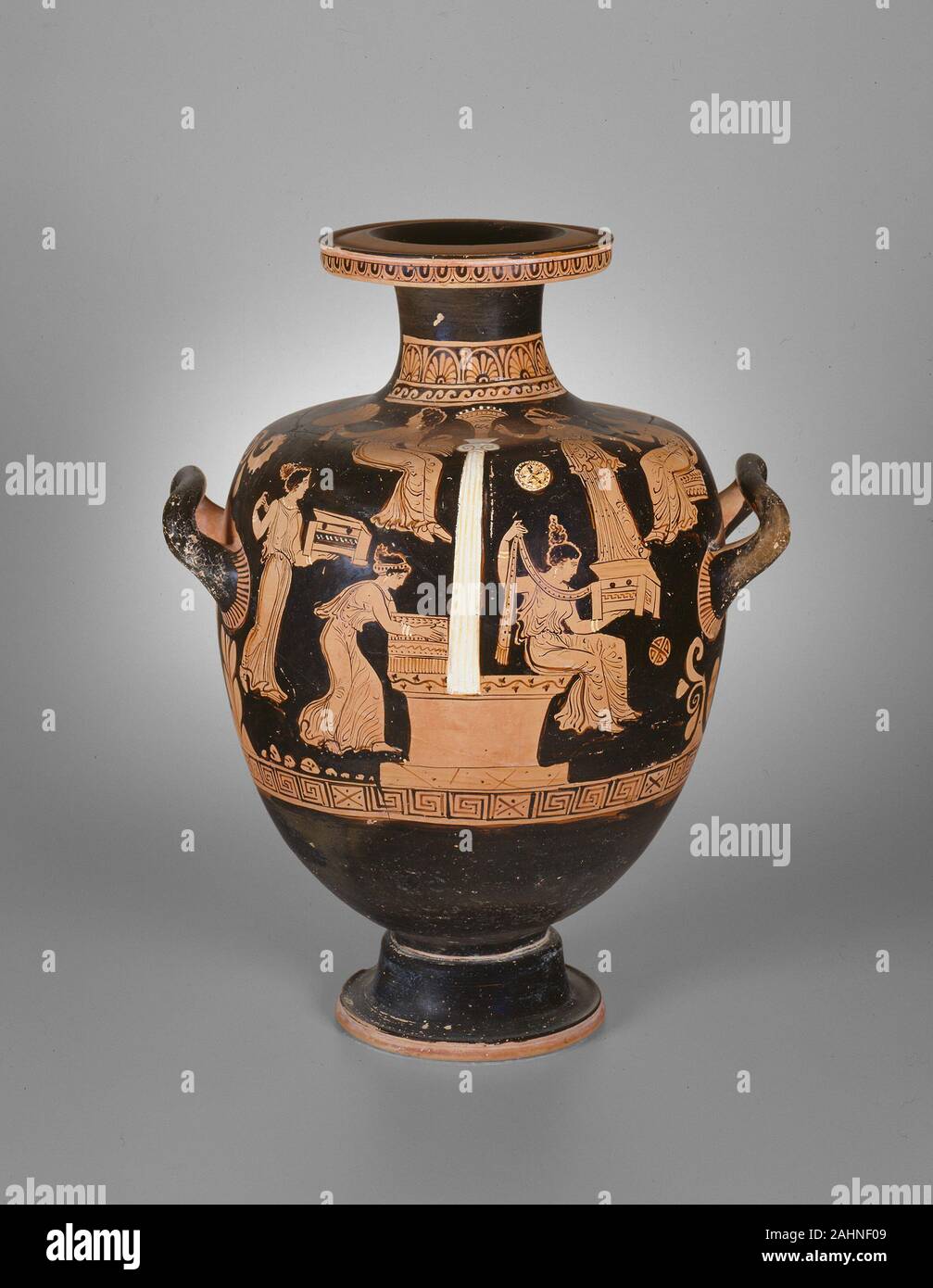 Ancient Greek. Hydria (Water Jar). 360 BC–350 BC. Puglia. terracotta, decorated in the red-figure technique In ancient Greece it was considered uncivilized for to consume undiluted wine, so water was fetched from a public fountain house in a large handled jar like this one and used to dilute large quantities of wine. The horizontal handles made it easier to carry, while the vertical handle at the back was used for pouring. On the front of the vessel, six female figures are arranged around a funeral momument, topped by a tall white pillar. Some of the women are standing while others are seated, Stock Photohttps://www.alamy.com/image-license-details/?v=1https://www.alamy.com/ancient-greek-hydria-water-jar-360-bc350-bc-puglia-terracotta-decorated-in-the-red-figure-technique-in-ancient-greece-it-was-considered-uncivilized-for-to-consume-undiluted-wine-so-water-was-fetched-from-a-public-fountain-house-in-a-large-handled-jar-like-this-one-and-used-to-dilute-large-quantities-of-wine-the-horizontal-handles-made-it-easier-to-carry-while-the-vertical-handle-at-the-back-was-used-for-pouring-on-the-front-of-the-vessel-six-female-figures-are-arranged-around-a-funeral-momument-topped-by-a-tall-white-pillar-some-of-the-women-are-standing-while-others-are-seated-image337918905.html
Ancient Greek. Hydria (Water Jar). 360 BC–350 BC. Puglia. terracotta, decorated in the red-figure technique In ancient Greece it was considered uncivilized for to consume undiluted wine, so water was fetched from a public fountain house in a large handled jar like this one and used to dilute large quantities of wine. The horizontal handles made it easier to carry, while the vertical handle at the back was used for pouring. On the front of the vessel, six female figures are arranged around a funeral momument, topped by a tall white pillar. Some of the women are standing while others are seated, Stock Photohttps://www.alamy.com/image-license-details/?v=1https://www.alamy.com/ancient-greek-hydria-water-jar-360-bc350-bc-puglia-terracotta-decorated-in-the-red-figure-technique-in-ancient-greece-it-was-considered-uncivilized-for-to-consume-undiluted-wine-so-water-was-fetched-from-a-public-fountain-house-in-a-large-handled-jar-like-this-one-and-used-to-dilute-large-quantities-of-wine-the-horizontal-handles-made-it-easier-to-carry-while-the-vertical-handle-at-the-back-was-used-for-pouring-on-the-front-of-the-vessel-six-female-figures-are-arranged-around-a-funeral-momument-topped-by-a-tall-white-pillar-some-of-the-women-are-standing-while-others-are-seated-image337918905.htmlRM2AHNF09–Ancient Greek. Hydria (Water Jar). 360 BC–350 BC. Puglia. terracotta, decorated in the red-figure technique In ancient Greece it was considered uncivilized for to consume undiluted wine, so water was fetched from a public fountain house in a large handled jar like this one and used to dilute large quantities of wine. The horizontal handles made it easier to carry, while the vertical handle at the back was used for pouring. On the front of the vessel, six female figures are arranged around a funeral momument, topped by a tall white pillar. Some of the women are standing while others are seated,
 Greece, East Macedonia and Thrace Region, Philippi, ruins of ancient city founded in 360 BC, view of the Forum Stock Photohttps://www.alamy.com/image-license-details/?v=1https://www.alamy.com/stock-photo-greece-east-macedonia-and-thrace-region-philippi-ruins-of-ancient-136128710.html
Greece, East Macedonia and Thrace Region, Philippi, ruins of ancient city founded in 360 BC, view of the Forum Stock Photohttps://www.alamy.com/image-license-details/?v=1https://www.alamy.com/stock-photo-greece-east-macedonia-and-thrace-region-philippi-ruins-of-ancient-136128710.htmlRMHWD5FJ–Greece, East Macedonia and Thrace Region, Philippi, ruins of ancient city founded in 360 BC, view of the Forum
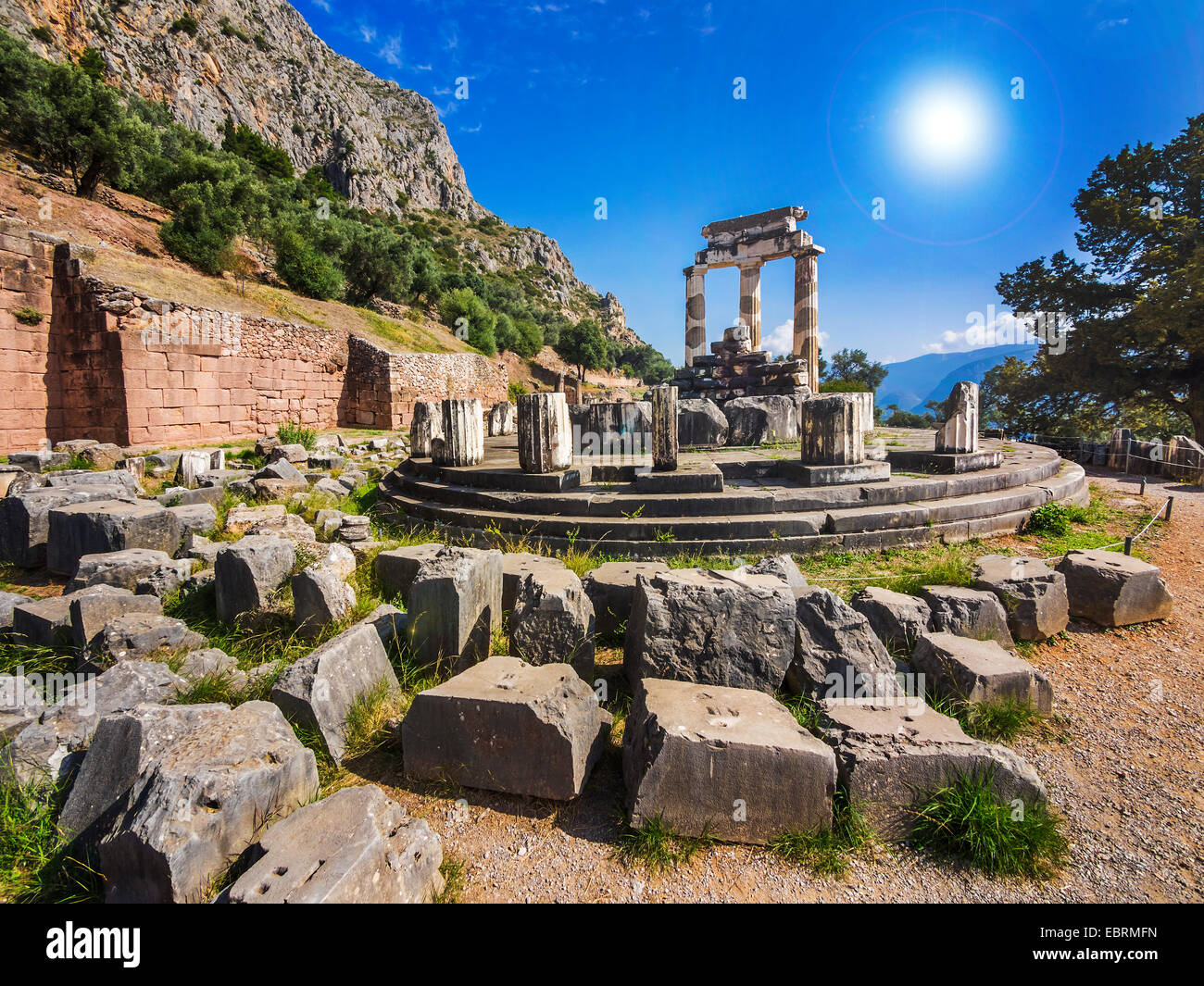 The Tholos at the sanctuary of Athena Pronoiat Delphi is a marble circular building that was constructed between 380 and 360 BC Stock Photohttps://www.alamy.com/image-license-details/?v=1https://www.alamy.com/stock-photo-the-tholos-at-the-sanctuary-of-athena-pronoiat-delphi-is-a-marble-76123705.html
The Tholos at the sanctuary of Athena Pronoiat Delphi is a marble circular building that was constructed between 380 and 360 BC Stock Photohttps://www.alamy.com/image-license-details/?v=1https://www.alamy.com/stock-photo-the-tholos-at-the-sanctuary-of-athena-pronoiat-delphi-is-a-marble-76123705.htmlRFEBRMFN–The Tholos at the sanctuary of Athena Pronoiat Delphi is a marble circular building that was constructed between 380 and 360 BC
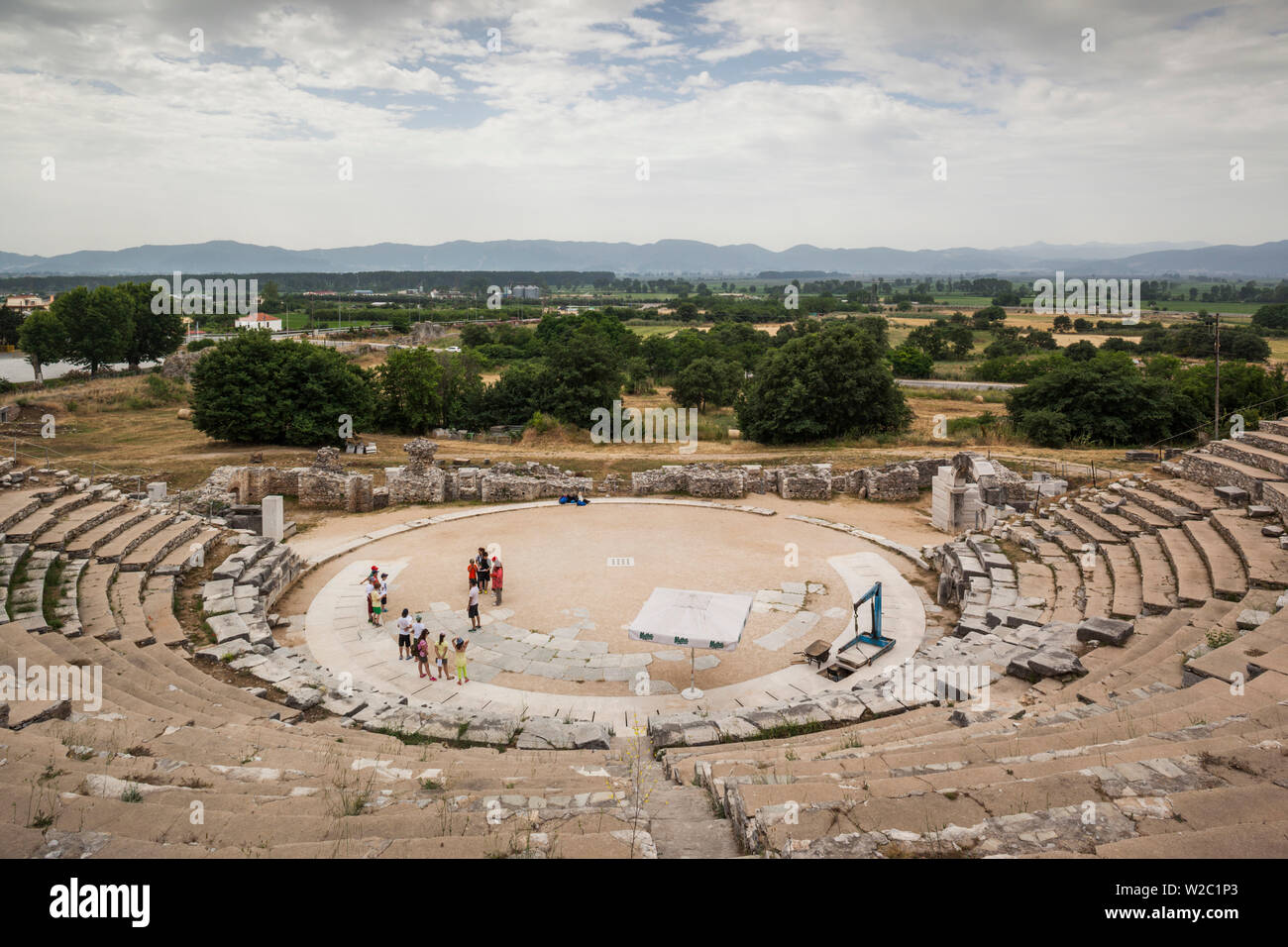 Greece, East Macedonia and Thrace Region, Philippi, ruins of ancient city founded in 360 BC, elevated view of the theater Stock Photohttps://www.alamy.com/image-license-details/?v=1https://www.alamy.com/greece-east-macedonia-and-thrace-region-philippi-ruins-of-ancient-city-founded-in-360-bc-elevated-view-of-the-theater-image259649659.html
Greece, East Macedonia and Thrace Region, Philippi, ruins of ancient city founded in 360 BC, elevated view of the theater Stock Photohttps://www.alamy.com/image-license-details/?v=1https://www.alamy.com/greece-east-macedonia-and-thrace-region-philippi-ruins-of-ancient-city-founded-in-360-bc-elevated-view-of-the-theater-image259649659.htmlRMW2C1P3–Greece, East Macedonia and Thrace Region, Philippi, ruins of ancient city founded in 360 BC, elevated view of the theater
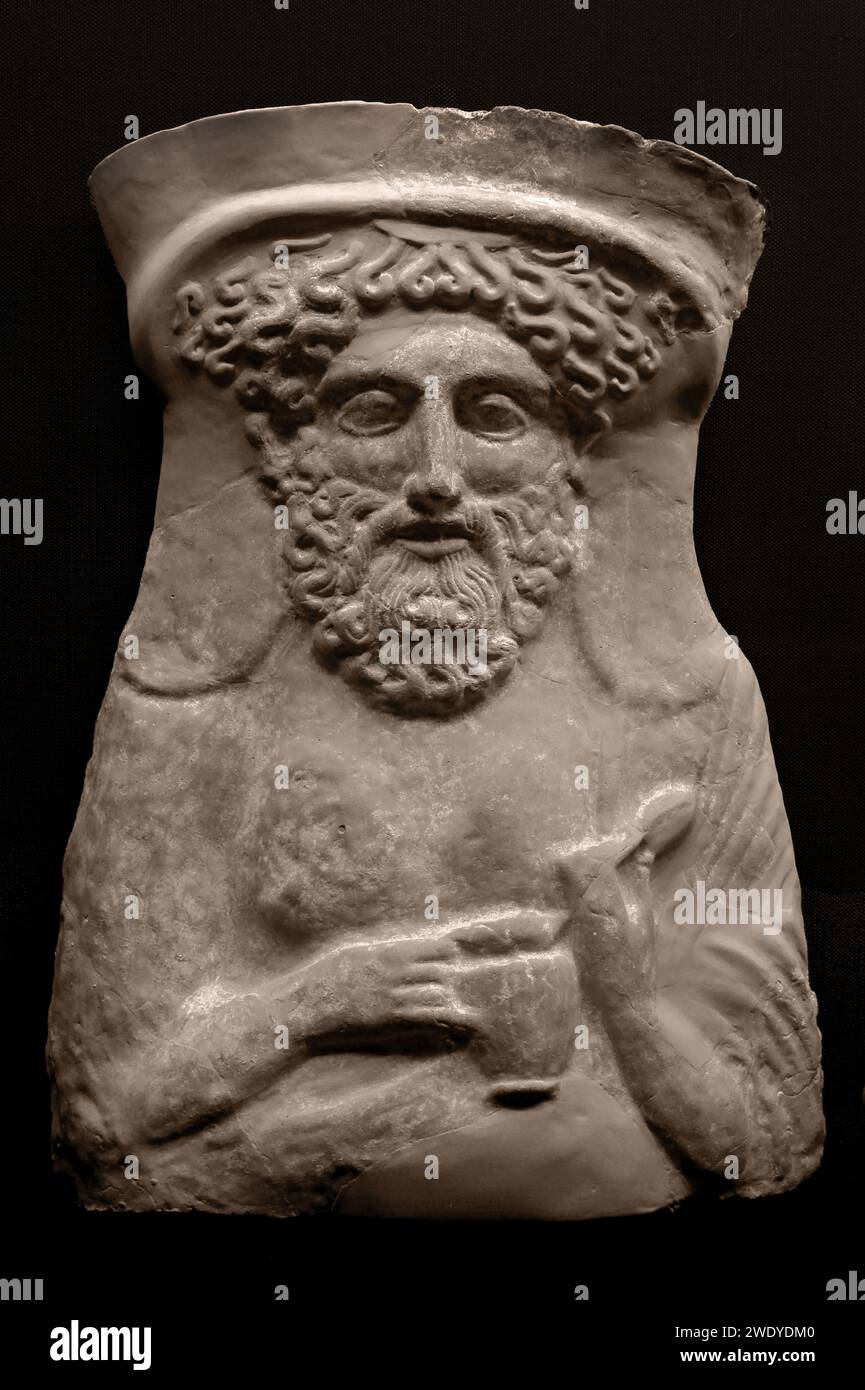 Benaki MuseumThis terracotta bust of the Greek God Dionysos dates to 380-360 BC. He is wearing a stephane (a type of metal upturned hairband) in his hair and is holding an egg in his left hand, and wine jug on his right. Athens Greece. Stock Photohttps://www.alamy.com/image-license-details/?v=1https://www.alamy.com/benaki-museumthis-terracotta-bust-of-the-greek-god-dionysos-dates-to-380-360-bc-he-is-wearing-a-stephane-a-type-of-metal-upturned-hairband-in-his-hair-and-is-holding-an-egg-in-his-left-hand-and-wine-jug-on-his-right-athens-greece-image593746496.html
Benaki MuseumThis terracotta bust of the Greek God Dionysos dates to 380-360 BC. He is wearing a stephane (a type of metal upturned hairband) in his hair and is holding an egg in his left hand, and wine jug on his right. Athens Greece. Stock Photohttps://www.alamy.com/image-license-details/?v=1https://www.alamy.com/benaki-museumthis-terracotta-bust-of-the-greek-god-dionysos-dates-to-380-360-bc-he-is-wearing-a-stephane-a-type-of-metal-upturned-hairband-in-his-hair-and-is-holding-an-egg-in-his-left-hand-and-wine-jug-on-his-right-athens-greece-image593746496.htmlRM2WDYDM0–Benaki MuseumThis terracotta bust of the Greek God Dionysos dates to 380-360 BC. He is wearing a stephane (a type of metal upturned hairband) in his hair and is holding an egg in his left hand, and wine jug on his right. Athens Greece.
 Marble head of Socrates (469-399 BC) Roman copy after a lost Greek original of about 380-360 BC Stock Photohttps://www.alamy.com/image-license-details/?v=1https://www.alamy.com/marble-head-of-socrates-469-399-bc-roman-copy-after-a-lost-greek-original-of-about-380-360-bc-image243945668.html
Marble head of Socrates (469-399 BC) Roman copy after a lost Greek original of about 380-360 BC Stock Photohttps://www.alamy.com/image-license-details/?v=1https://www.alamy.com/marble-head-of-socrates-469-399-bc-roman-copy-after-a-lost-greek-original-of-about-380-360-bc-image243945668.htmlRMT4TK58–Marble head of Socrates (469-399 BC) Roman copy after a lost Greek original of about 380-360 BC
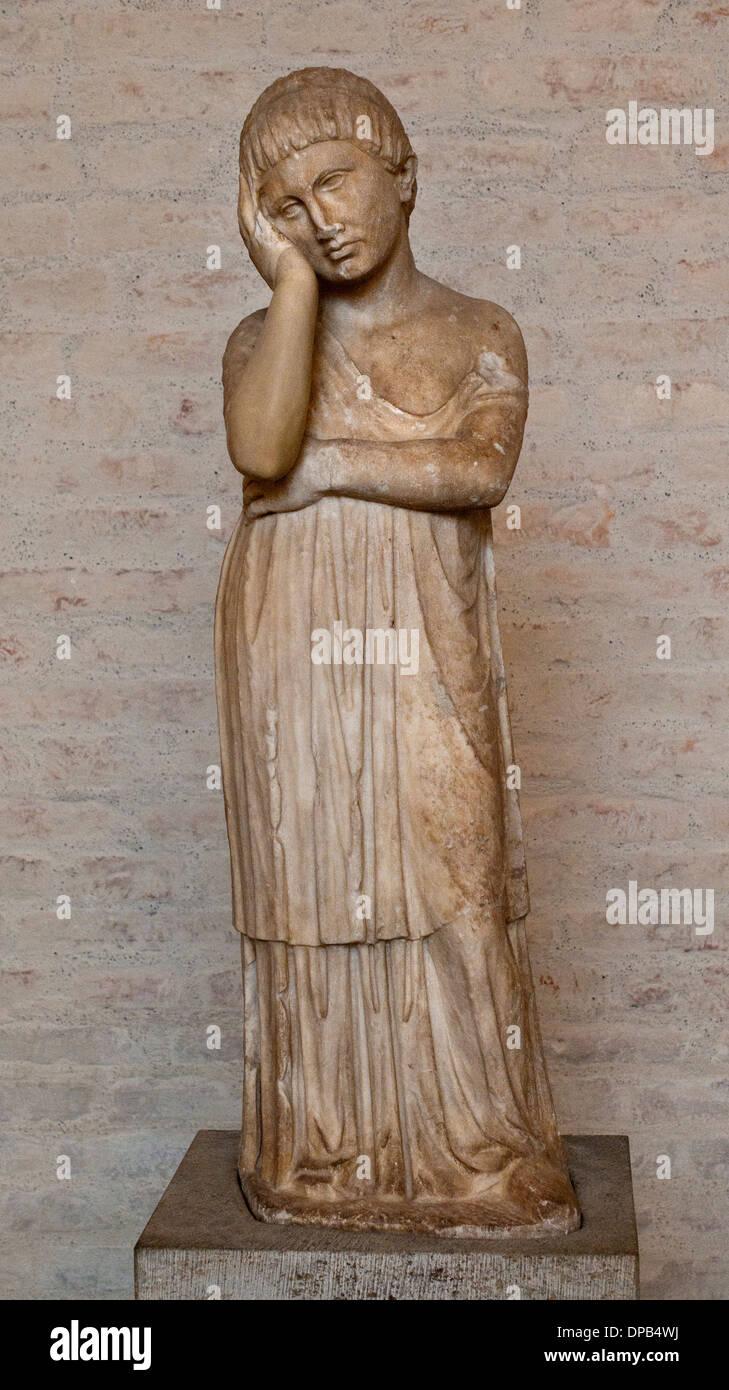 Statue of a dreamer girl ( from a tomb ) Attica 360 BC. reek Greece Stock Photohttps://www.alamy.com/image-license-details/?v=1https://www.alamy.com/statue-of-a-dreamer-girl-from-a-tomb-attica-360-bc-reek-greece-image65398862.html
Statue of a dreamer girl ( from a tomb ) Attica 360 BC. reek Greece Stock Photohttps://www.alamy.com/image-license-details/?v=1https://www.alamy.com/statue-of-a-dreamer-girl-from-a-tomb-attica-360-bc-reek-greece-image65398862.htmlRMDPB4WJ–Statue of a dreamer girl ( from a tomb ) Attica 360 BC. reek Greece
 Deer hunting depicted in the Lucanian fresco from 370-360 BC from the Tomb 1 of the Gaudo Necropolis on display in the Paestum Archaeological Museum (Museo archeologico di Paestum) in Paestum, Campania, Italy. Stock Photohttps://www.alamy.com/image-license-details/?v=1https://www.alamy.com/deer-hunting-depicted-in-the-lucanian-fresco-from-370-360-bc-from-the-tomb-1-of-the-gaudo-necropolis-on-display-in-the-paestum-archaeological-museum-museo-archeologico-di-paestum-in-paestum-campania-italy-image179711789.html
Deer hunting depicted in the Lucanian fresco from 370-360 BC from the Tomb 1 of the Gaudo Necropolis on display in the Paestum Archaeological Museum (Museo archeologico di Paestum) in Paestum, Campania, Italy. Stock Photohttps://www.alamy.com/image-license-details/?v=1https://www.alamy.com/deer-hunting-depicted-in-the-lucanian-fresco-from-370-360-bc-from-the-tomb-1-of-the-gaudo-necropolis-on-display-in-the-paestum-archaeological-museum-museo-archeologico-di-paestum-in-paestum-campania-italy-image179711789.htmlRMMCAG65–Deer hunting depicted in the Lucanian fresco from 370-360 BC from the Tomb 1 of the Gaudo Necropolis on display in the Paestum Archaeological Museum (Museo archeologico di Paestum) in Paestum, Campania, Italy.
 Fresco depicting deer hunt Andriuolo, Tomb 18 - Eastern slab (370-360 BC) - Archaeological Area of Paestum - Salerno, Italy Stock Photohttps://www.alamy.com/image-license-details/?v=1https://www.alamy.com/fresco-depicting-deer-hunt-andriuolo-tomb-18-eastern-slab-370-360-bc-archaeological-area-of-paestum-salerno-italy-image431082758.html
Fresco depicting deer hunt Andriuolo, Tomb 18 - Eastern slab (370-360 BC) - Archaeological Area of Paestum - Salerno, Italy Stock Photohttps://www.alamy.com/image-license-details/?v=1https://www.alamy.com/fresco-depicting-deer-hunt-andriuolo-tomb-18-eastern-slab-370-360-bc-archaeological-area-of-paestum-salerno-italy-image431082758.htmlRM2G19ECP–Fresco depicting deer hunt Andriuolo, Tomb 18 - Eastern slab (370-360 BC) - Archaeological Area of Paestum - Salerno, Italy
 Votive stele depicting a sacrificial procession to Dionysus and Artemis for the win in a contest of theater. Votive offering, ca. 360 BC. Glyptothek. Munich. Germany. Stock Photohttps://www.alamy.com/image-license-details/?v=1https://www.alamy.com/votive-stele-depicting-a-sacrificial-procession-to-dionysus-and-artemis-for-the-win-in-a-contest-of-theater-votive-offering-ca-360-bc-glyptothek-munich-germany-image220442025.html
Votive stele depicting a sacrificial procession to Dionysus and Artemis for the win in a contest of theater. Votive offering, ca. 360 BC. Glyptothek. Munich. Germany. Stock Photohttps://www.alamy.com/image-license-details/?v=1https://www.alamy.com/votive-stele-depicting-a-sacrificial-procession-to-dionysus-and-artemis-for-the-win-in-a-contest-of-theater-votive-offering-ca-360-bc-glyptothek-munich-germany-image220442025.htmlRMPPJ01D–Votive stele depicting a sacrificial procession to Dionysus and Artemis for the win in a contest of theater. Votive offering, ca. 360 BC. Glyptothek. Munich. Germany.
 Terracotta proteome or bust of the god Dionysus Greek 380-360 BC. The god holds an egg and a wine jug. Stock Photohttps://www.alamy.com/image-license-details/?v=1https://www.alamy.com/stock-photo-terracotta-proteome-or-bust-of-the-god-dionysus-greek-380-360-bc-the-57434840.html
Terracotta proteome or bust of the god Dionysus Greek 380-360 BC. The god holds an egg and a wine jug. Stock Photohttps://www.alamy.com/image-license-details/?v=1https://www.alamy.com/stock-photo-terracotta-proteome-or-bust-of-the-god-dionysus-greek-380-360-bc-the-57434840.htmlRMD9CAM8–Terracotta proteome or bust of the god Dionysus Greek 380-360 BC. The god holds an egg and a wine jug.
 Turkey, Aegean Region, Datça Peninsula, Knidos, ruins of ancient Carian city built for Aphrodite, dating from 360 BC, summer Stock Photohttps://www.alamy.com/image-license-details/?v=1https://www.alamy.com/turkey-aegean-region-data-peninsula-knidos-ruins-of-ancient-carian-image9473247.html
Turkey, Aegean Region, Datça Peninsula, Knidos, ruins of ancient Carian city built for Aphrodite, dating from 360 BC, summer Stock Photohttps://www.alamy.com/image-license-details/?v=1https://www.alamy.com/turkey-aegean-region-data-peninsula-knidos-ruins-of-ancient-carian-image9473247.htmlRMAWGPP0–Turkey, Aegean Region, Datça Peninsula, Knidos, ruins of ancient Carian city built for Aphrodite, dating from 360 BC, summer
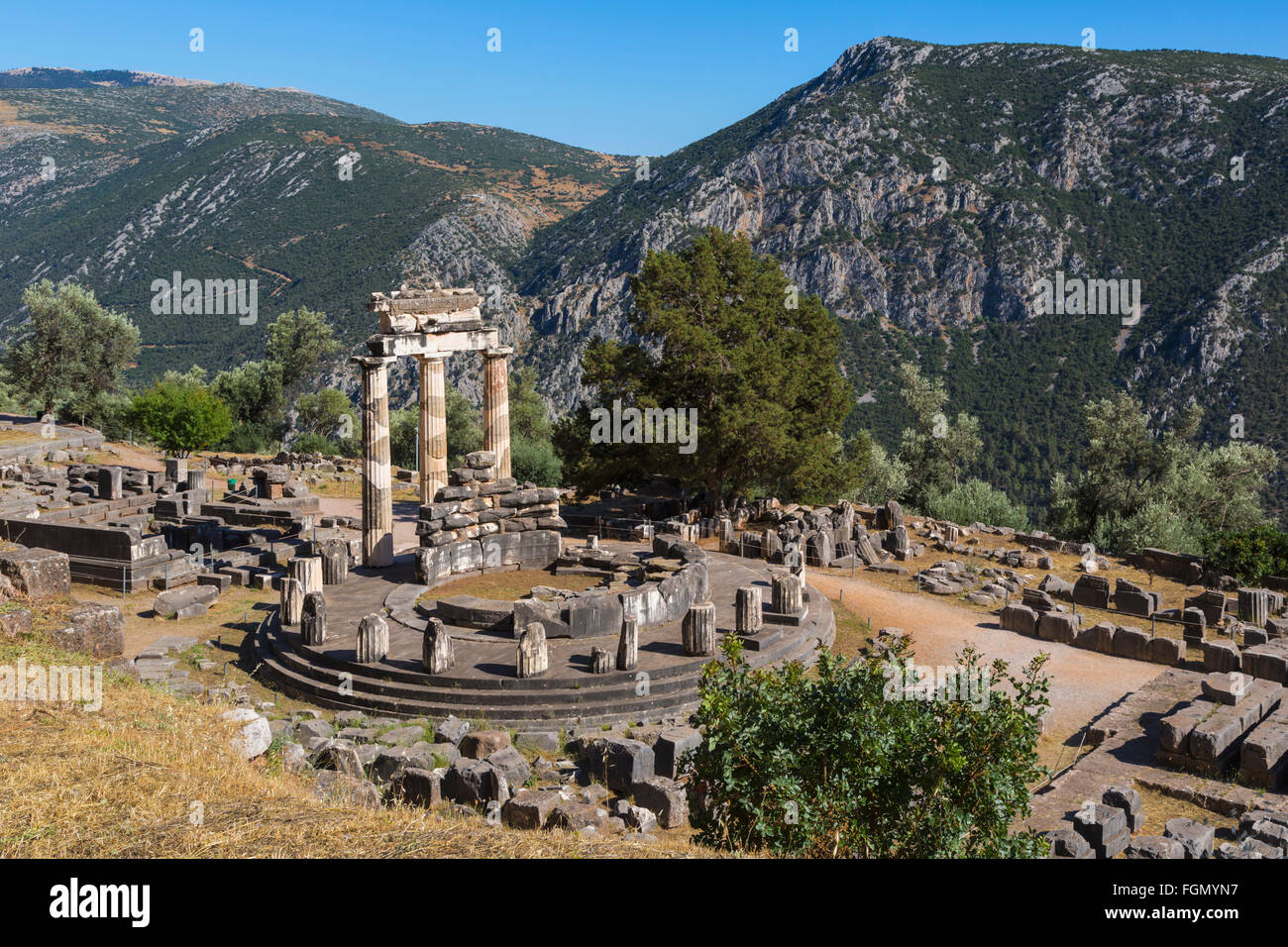 Delphi, Phocis, Greece. The tholos, dating from around 380-360 BC, beside the Sanctuary of Athena Pronaia. Stock Photohttps://www.alamy.com/image-license-details/?v=1https://www.alamy.com/stock-photo-delphi-phocis-greece-the-tholos-dating-from-around-380-360-bc-beside-96347139.html
Delphi, Phocis, Greece. The tholos, dating from around 380-360 BC, beside the Sanctuary of Athena Pronaia. Stock Photohttps://www.alamy.com/image-license-details/?v=1https://www.alamy.com/stock-photo-delphi-phocis-greece-the-tholos-dating-from-around-380-360-bc-beside-96347139.htmlRMFGMYN7–Delphi, Phocis, Greece. The tholos, dating from around 380-360 BC, beside the Sanctuary of Athena Pronaia.
 Socrates (469-399 BC). Classical Greek philosopher. Roman copy of Greek original, 380-360 BC. British Museum. London. United Kingdom. Stock Photohttps://www.alamy.com/image-license-details/?v=1https://www.alamy.com/stock-photo-socrates-469-399-bc-classical-greek-philosopher-roman-copy-of-greek-143512740.html
Socrates (469-399 BC). Classical Greek philosopher. Roman copy of Greek original, 380-360 BC. British Museum. London. United Kingdom. Stock Photohttps://www.alamy.com/image-license-details/?v=1https://www.alamy.com/stock-photo-socrates-469-399-bc-classical-greek-philosopher-roman-copy-of-greek-143512740.htmlRMJ9DFY0–Socrates (469-399 BC). Classical Greek philosopher. Roman copy of Greek original, 380-360 BC. British Museum. London. United Kingdom.
 Karlsruhe, Germany. 06th Aug, 2021. Eckart Köhne, Director of the Badisches Landesmuseum, photographed in Karlsruhe Palace at the 'Myrrhine tomb relief', which is dated around 360 BC. Credit: Uli Deck/dpa/Alamy Live News Stock Photohttps://www.alamy.com/image-license-details/?v=1https://www.alamy.com/karlsruhe-germany-06th-aug-2021-eckart-khne-director-of-the-badisches-landesmuseum-photographed-in-karlsruhe-palace-at-the-myrrhine-tomb-relief-which-is-dated-around-360-bc-credit-uli-deckdpaalamy-live-news-image438676592.html
Karlsruhe, Germany. 06th Aug, 2021. Eckart Köhne, Director of the Badisches Landesmuseum, photographed in Karlsruhe Palace at the 'Myrrhine tomb relief', which is dated around 360 BC. Credit: Uli Deck/dpa/Alamy Live News Stock Photohttps://www.alamy.com/image-license-details/?v=1https://www.alamy.com/karlsruhe-germany-06th-aug-2021-eckart-khne-director-of-the-badisches-landesmuseum-photographed-in-karlsruhe-palace-at-the-myrrhine-tomb-relief-which-is-dated-around-360-bc-credit-uli-deckdpaalamy-live-news-image438676592.htmlRM2GDKCD4–Karlsruhe, Germany. 06th Aug, 2021. Eckart Köhne, Director of the Badisches Landesmuseum, photographed in Karlsruhe Palace at the 'Myrrhine tomb relief', which is dated around 360 BC. Credit: Uli Deck/dpa/Alamy Live News
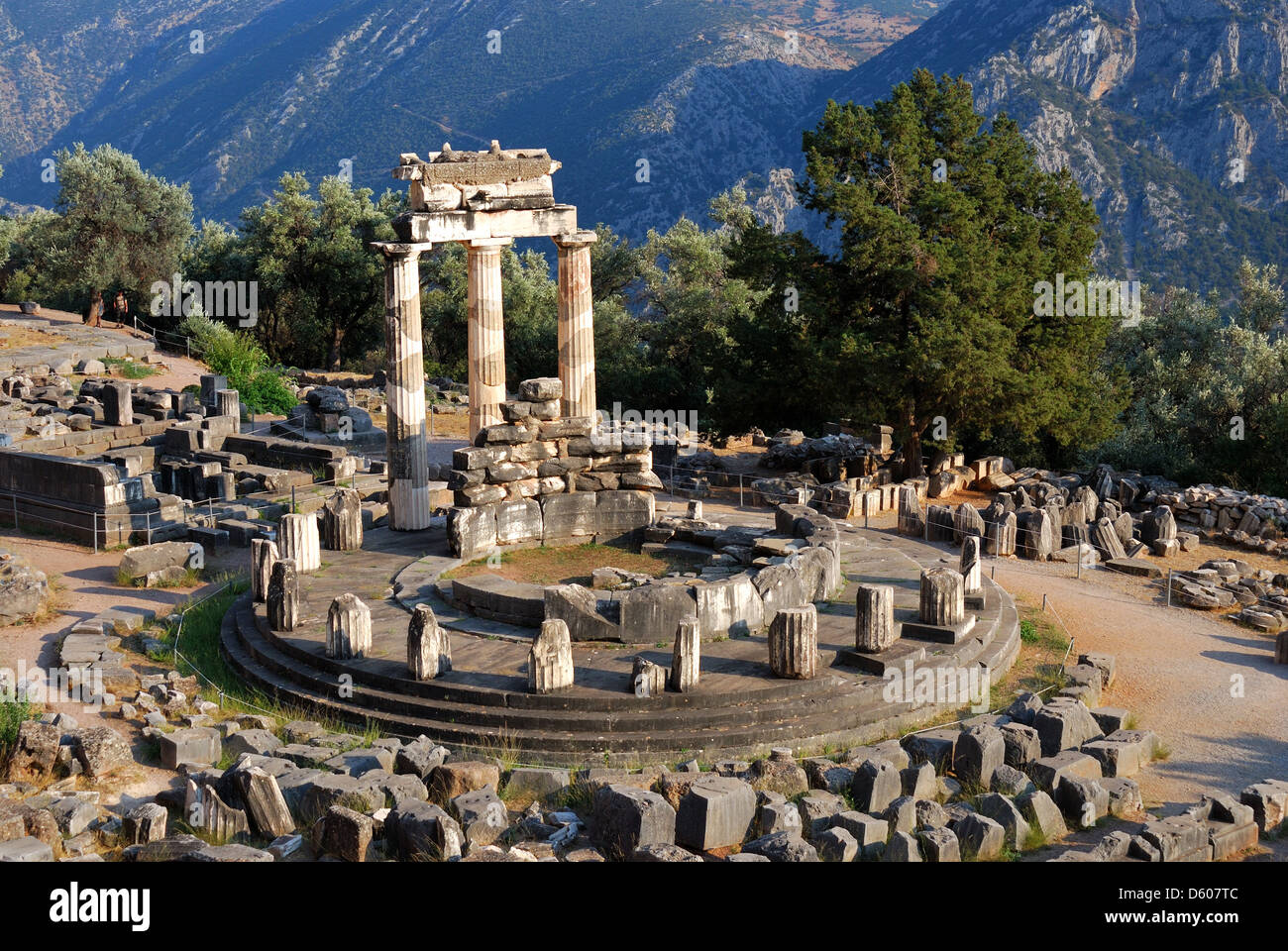 The Tholos at the sanctuary of Athena Pronaia is a circular building that was constructed between 380 and 360 BC. Stock Photohttps://www.alamy.com/image-license-details/?v=1https://www.alamy.com/stock-photo-the-tholos-at-the-sanctuary-of-athena-pronaia-is-a-circular-building-55325212.html
The Tholos at the sanctuary of Athena Pronaia is a circular building that was constructed between 380 and 360 BC. Stock Photohttps://www.alamy.com/image-license-details/?v=1https://www.alamy.com/stock-photo-the-tholos-at-the-sanctuary-of-athena-pronaia-is-a-circular-building-55325212.htmlRFD607TC–The Tholos at the sanctuary of Athena Pronaia is a circular building that was constructed between 380 and 360 BC.
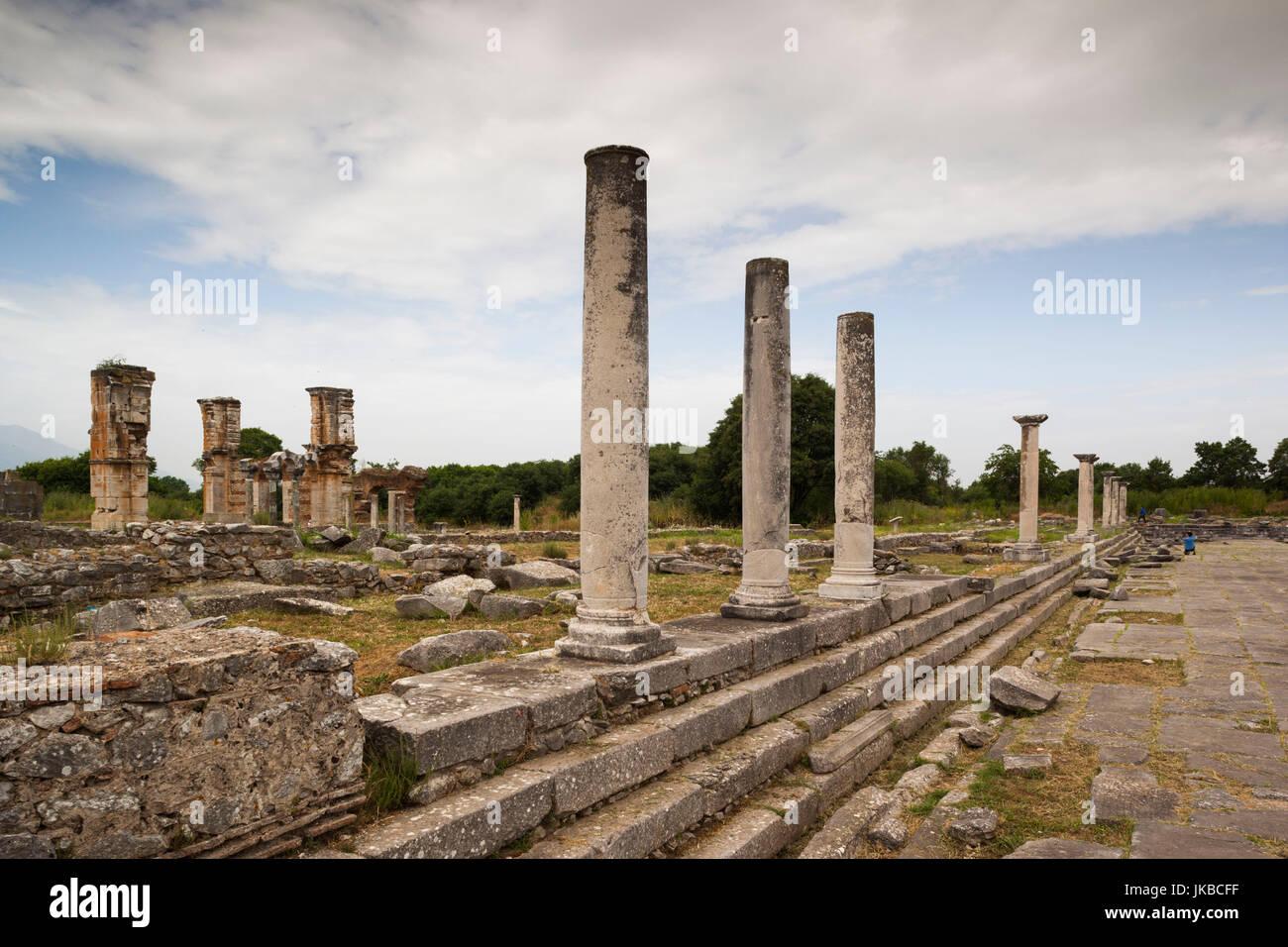 Greece, East Macedonia and Thrace Region, Philippi, ruins of ancient city founded in 360 BC, view of the Forum Stock Photohttps://www.alamy.com/image-license-details/?v=1https://www.alamy.com/stock-photo-greece-east-macedonia-and-thrace-region-philippi-ruins-of-ancient-149612723.html
Greece, East Macedonia and Thrace Region, Philippi, ruins of ancient city founded in 360 BC, view of the Forum Stock Photohttps://www.alamy.com/image-license-details/?v=1https://www.alamy.com/stock-photo-greece-east-macedonia-and-thrace-region-philippi-ruins-of-ancient-149612723.htmlRMJKBCFF–Greece, East Macedonia and Thrace Region, Philippi, ruins of ancient city founded in 360 BC, view of the Forum
 Berlin, Germany. 18th June, 2019. Ancient busts and an amphora (ca. 360 BC) can be seen in the exhibition 'Strong Types. Greek Portraits of Antiquity'. The exhibition in the Altes Museum focuses on the development of the Greek portrait in the field of tension between ideal and individualization, identity and staging. Credit: Paul Zinken/dpa/Alamy Live News Stock Photohttps://www.alamy.com/image-license-details/?v=1https://www.alamy.com/berlin-germany-18th-june-2019-ancient-busts-and-an-amphora-ca-360-bc-can-be-seen-in-the-exhibition-strong-types-greek-portraits-of-antiquity-the-exhibition-in-the-altes-museum-focuses-on-the-development-of-the-greek-portrait-in-the-field-of-tension-between-ideal-and-individualization-identity-and-staging-credit-paul-zinkendpaalamy-live-news-image249466705.html
Berlin, Germany. 18th June, 2019. Ancient busts and an amphora (ca. 360 BC) can be seen in the exhibition 'Strong Types. Greek Portraits of Antiquity'. The exhibition in the Altes Museum focuses on the development of the Greek portrait in the field of tension between ideal and individualization, identity and staging. Credit: Paul Zinken/dpa/Alamy Live News Stock Photohttps://www.alamy.com/image-license-details/?v=1https://www.alamy.com/berlin-germany-18th-june-2019-ancient-busts-and-an-amphora-ca-360-bc-can-be-seen-in-the-exhibition-strong-types-greek-portraits-of-antiquity-the-exhibition-in-the-altes-museum-focuses-on-the-development-of-the-greek-portrait-in-the-field-of-tension-between-ideal-and-individualization-identity-and-staging-credit-paul-zinkendpaalamy-live-news-image249466705.htmlRMTDT595–Berlin, Germany. 18th June, 2019. Ancient busts and an amphora (ca. 360 BC) can be seen in the exhibition 'Strong Types. Greek Portraits of Antiquity'. The exhibition in the Altes Museum focuses on the development of the Greek portrait in the field of tension between ideal and individualization, identity and staging. Credit: Paul Zinken/dpa/Alamy Live News
 Paestrum, Andriuolo. Tomb 24. (370-360 BC ) Stock Photohttps://www.alamy.com/image-license-details/?v=1https://www.alamy.com/stock-photo-paestrum-andriuolo-tomb-24-370-360-bc-139216263.html
Paestrum, Andriuolo. Tomb 24. (370-360 BC ) Stock Photohttps://www.alamy.com/image-license-details/?v=1https://www.alamy.com/stock-photo-paestrum-andriuolo-tomb-24-370-360-bc-139216263.htmlRFJ2DRNB–Paestrum, Andriuolo. Tomb 24. (370-360 BC )
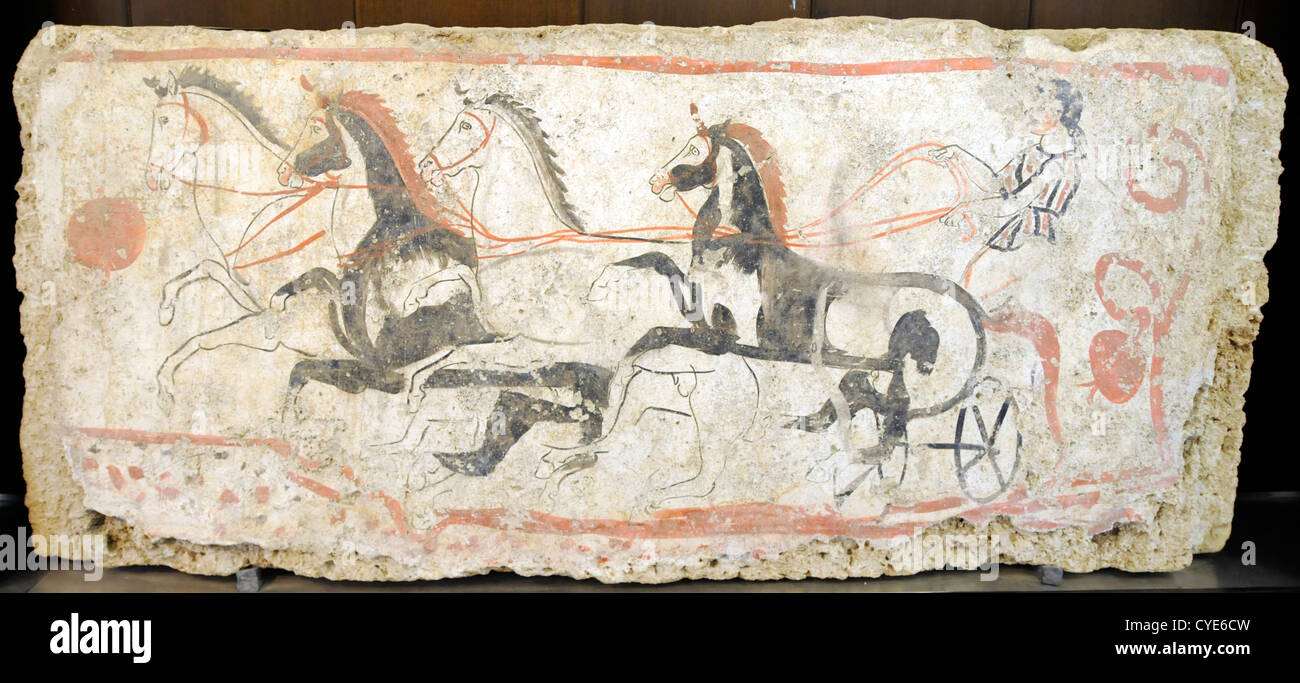 Race of the Bigae, Greek tomb slab c.370-360 BC, The museum at Paestum, site of Greek and Roman remains, Italy Stock Photohttps://www.alamy.com/image-license-details/?v=1https://www.alamy.com/stock-photo-race-of-the-bigae-greek-tomb-slab-c370-360-bc-the-museum-at-paestum-51328841.html
Race of the Bigae, Greek tomb slab c.370-360 BC, The museum at Paestum, site of Greek and Roman remains, Italy Stock Photohttps://www.alamy.com/image-license-details/?v=1https://www.alamy.com/stock-photo-race-of-the-bigae-greek-tomb-slab-c370-360-bc-the-museum-at-paestum-51328841.htmlRMCYE6CW–Race of the Bigae, Greek tomb slab c.370-360 BC, The museum at Paestum, site of Greek and Roman remains, Italy
 Greece, East Macedonia and Thrace Region, Philippi, ruins of ancient city founded in 360 BC, view of the Forum Stock Photohttps://www.alamy.com/image-license-details/?v=1https://www.alamy.com/stock-photo-greece-east-macedonia-and-thrace-region-philippi-ruins-of-ancient-136128711.html
Greece, East Macedonia and Thrace Region, Philippi, ruins of ancient city founded in 360 BC, view of the Forum Stock Photohttps://www.alamy.com/image-license-details/?v=1https://www.alamy.com/stock-photo-greece-east-macedonia-and-thrace-region-philippi-ruins-of-ancient-136128711.htmlRMHWD5FK–Greece, East Macedonia and Thrace Region, Philippi, ruins of ancient city founded in 360 BC, view of the Forum
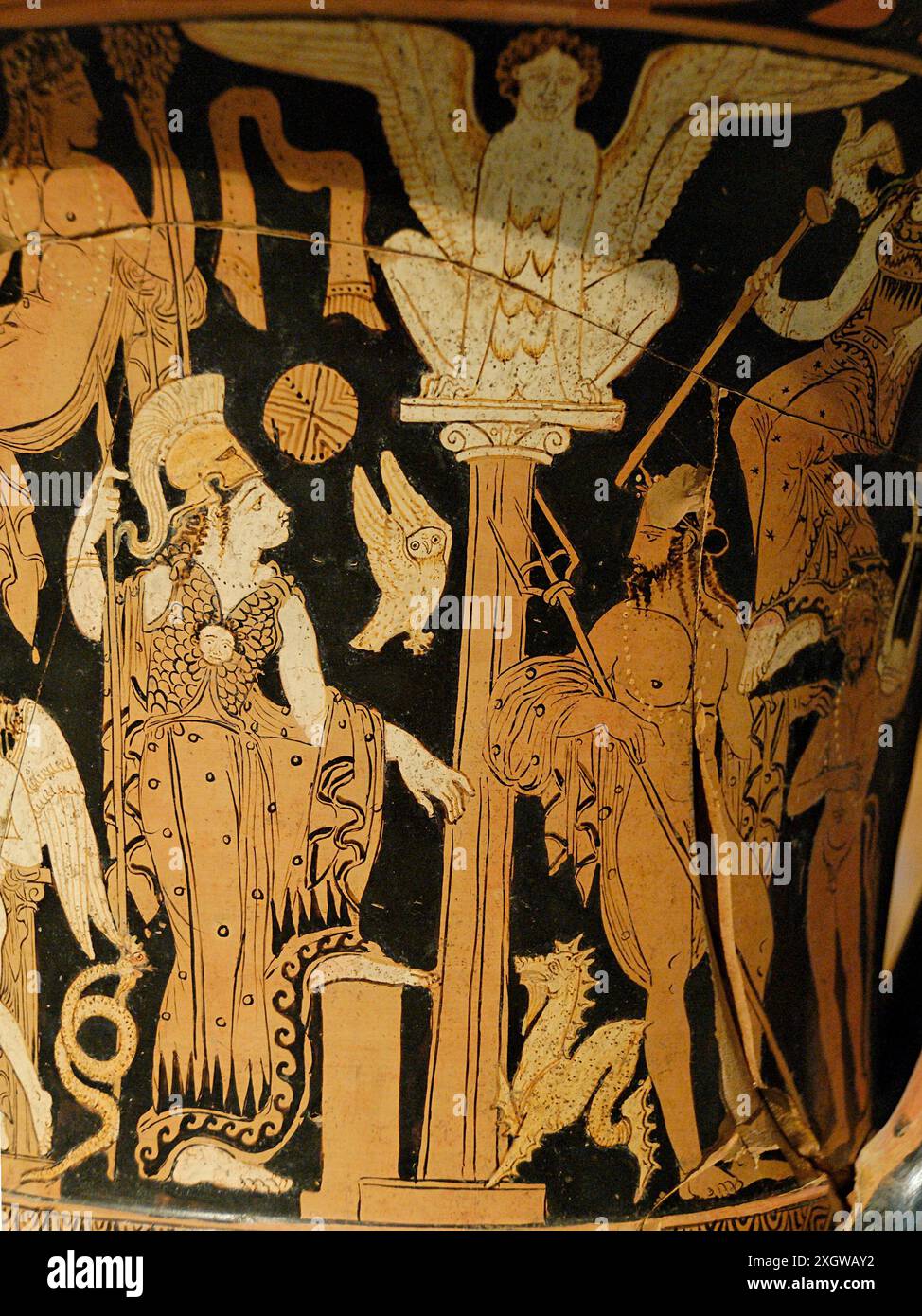 Athena and Poseidon, Faliscan red-figure volute-krater, by Nazzano Painter, 360 BC. Louvre, Paris. Stock Photohttps://www.alamy.com/image-license-details/?v=1https://www.alamy.com/athena-and-poseidon-faliscan-red-figure-volute-krater-by-nazzano-painter-360-bc-louvre-paris-image612754774.html
Athena and Poseidon, Faliscan red-figure volute-krater, by Nazzano Painter, 360 BC. Louvre, Paris. Stock Photohttps://www.alamy.com/image-license-details/?v=1https://www.alamy.com/athena-and-poseidon-faliscan-red-figure-volute-krater-by-nazzano-painter-360-bc-louvre-paris-image612754774.htmlRM2XGWAY2–Athena and Poseidon, Faliscan red-figure volute-krater, by Nazzano Painter, 360 BC. Louvre, Paris.
 Greece, East Macedonia and Thrace Region, Philippi, ruins of ancient city founded in 360 BC, elevated view of Basilica B Stock Photohttps://www.alamy.com/image-license-details/?v=1https://www.alamy.com/greece-east-macedonia-and-thrace-region-philippi-ruins-of-ancient-city-founded-in-360-bc-elevated-view-of-basilica-b-image259649667.html
Greece, East Macedonia and Thrace Region, Philippi, ruins of ancient city founded in 360 BC, elevated view of Basilica B Stock Photohttps://www.alamy.com/image-license-details/?v=1https://www.alamy.com/greece-east-macedonia-and-thrace-region-philippi-ruins-of-ancient-city-founded-in-360-bc-elevated-view-of-basilica-b-image259649667.htmlRMW2C1PB–Greece, East Macedonia and Thrace Region, Philippi, ruins of ancient city founded in 360 BC, elevated view of Basilica B
 Greece, East Macedonia and Thrace, Philippi, ruins of ancient city founded in 360 BC, Basilica B Stock Photohttps://www.alamy.com/image-license-details/?v=1https://www.alamy.com/stock-photo-greece-east-macedonia-and-thrace-philippi-ruins-of-ancient-city-founded-88805356.html
Greece, East Macedonia and Thrace, Philippi, ruins of ancient city founded in 360 BC, Basilica B Stock Photohttps://www.alamy.com/image-license-details/?v=1https://www.alamy.com/stock-photo-greece-east-macedonia-and-thrace-philippi-ruins-of-ancient-city-founded-88805356.htmlRMF4DC3T–Greece, East Macedonia and Thrace, Philippi, ruins of ancient city founded in 360 BC, Basilica B
 Chryses attempting to ransom his daughter Chryseis from Agamemnon. Side A of an Apulian red-figure volute-crater, ca. 360 BC–350 BC, found in Taranto. Stock Photohttps://www.alamy.com/image-license-details/?v=1https://www.alamy.com/chryses-attempting-to-ransom-his-daughter-chryseis-from-agamemnon-side-a-of-an-apulian-red-figure-volute-crater-ca-360-bc350-bc-found-in-taranto-image612725275.html
Chryses attempting to ransom his daughter Chryseis from Agamemnon. Side A of an Apulian red-figure volute-crater, ca. 360 BC–350 BC, found in Taranto. Stock Photohttps://www.alamy.com/image-license-details/?v=1https://www.alamy.com/chryses-attempting-to-ransom-his-daughter-chryseis-from-agamemnon-side-a-of-an-apulian-red-figure-volute-crater-ca-360-bc350-bc-found-in-taranto-image612725275.htmlRM2XGT19F–Chryses attempting to ransom his daughter Chryseis from Agamemnon. Side A of an Apulian red-figure volute-crater, ca. 360 BC–350 BC, found in Taranto.
 Zeus kidnapping a woman, Etruscan red-figure kylix, 380-360 BC Stock Photohttps://www.alamy.com/image-license-details/?v=1https://www.alamy.com/zeus-kidnapping-a-woman-etruscan-red-figure-kylix-380-360-bc-image591113173.html
Zeus kidnapping a woman, Etruscan red-figure kylix, 380-360 BC Stock Photohttps://www.alamy.com/image-license-details/?v=1https://www.alamy.com/zeus-kidnapping-a-woman-etruscan-red-figure-kylix-380-360-bc-image591113173.htmlRM2W9KETN–Zeus kidnapping a woman, Etruscan red-figure kylix, 380-360 BC
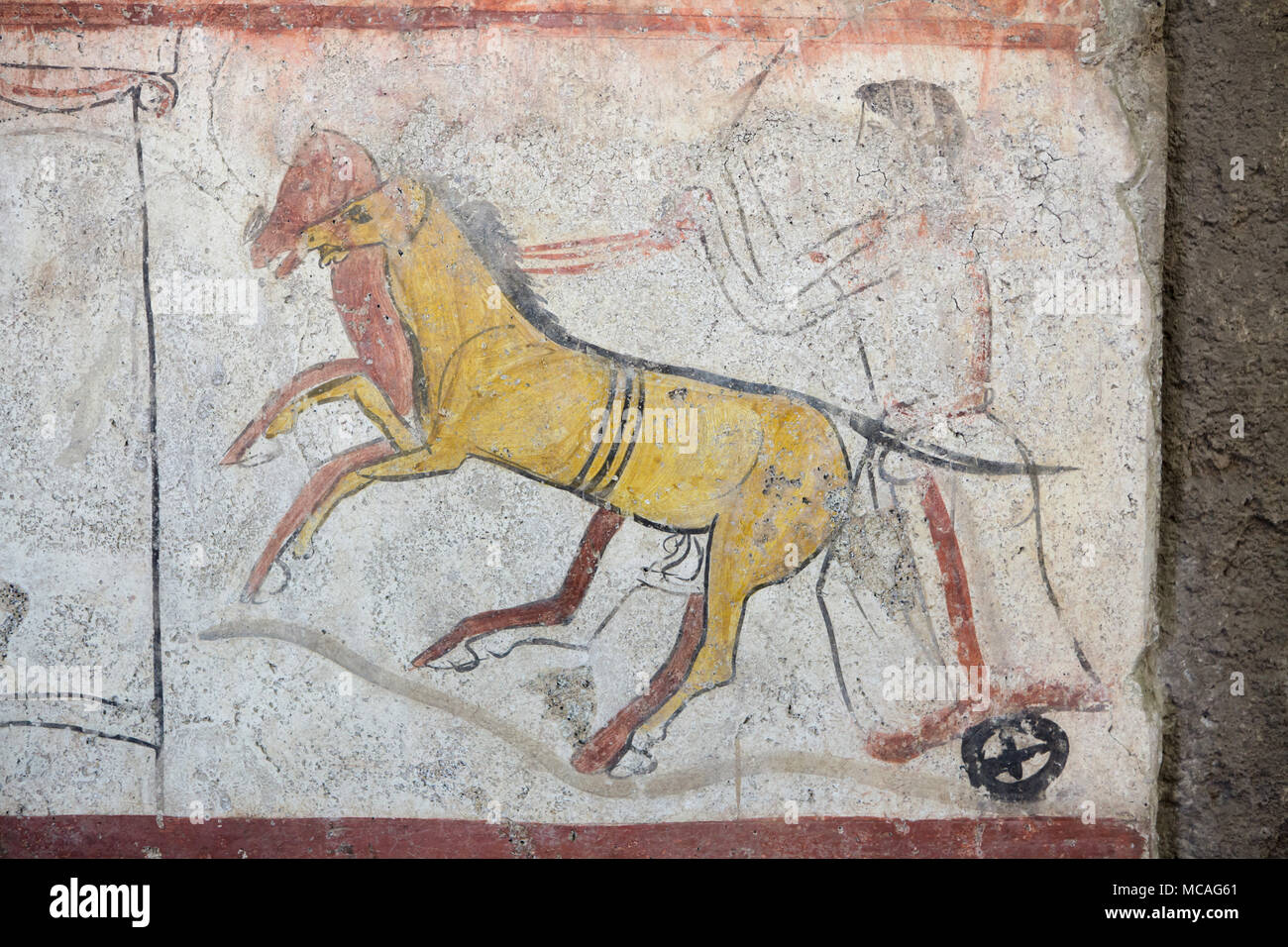 Biga race (chariot race) depicted in the Lucanian fresco from 370-360 BC from the Tomb 24 of the Andriuolo Necropolis on display in the Paestum Archaeological Museum (Museo archeologico di Paestum) in Paestum, Campania, Italy. Stock Photohttps://www.alamy.com/image-license-details/?v=1https://www.alamy.com/biga-race-chariot-race-depicted-in-the-lucanian-fresco-from-370-360-bc-from-the-tomb-24-of-the-andriuolo-necropolis-on-display-in-the-paestum-archaeological-museum-museo-archeologico-di-paestum-in-paestum-campania-italy-image179711785.html
Biga race (chariot race) depicted in the Lucanian fresco from 370-360 BC from the Tomb 24 of the Andriuolo Necropolis on display in the Paestum Archaeological Museum (Museo archeologico di Paestum) in Paestum, Campania, Italy. Stock Photohttps://www.alamy.com/image-license-details/?v=1https://www.alamy.com/biga-race-chariot-race-depicted-in-the-lucanian-fresco-from-370-360-bc-from-the-tomb-24-of-the-andriuolo-necropolis-on-display-in-the-paestum-archaeological-museum-museo-archeologico-di-paestum-in-paestum-campania-italy-image179711785.htmlRMMCAG61–Biga race (chariot race) depicted in the Lucanian fresco from 370-360 BC from the Tomb 24 of the Andriuolo Necropolis on display in the Paestum Archaeological Museum (Museo archeologico di Paestum) in Paestum, Campania, Italy.
 Fresco depicting boxing and duel Andriuolo, Tomb 24 - Western slab (370-360 BC) - Archaeological Area of Paestum - Salerno, Italy Stock Photohttps://www.alamy.com/image-license-details/?v=1https://www.alamy.com/fresco-depicting-boxing-and-duel-andriuolo-tomb-24-western-slab-370-360-bc-archaeological-area-of-paestum-salerno-italy-image431082627.html
Fresco depicting boxing and duel Andriuolo, Tomb 24 - Western slab (370-360 BC) - Archaeological Area of Paestum - Salerno, Italy Stock Photohttps://www.alamy.com/image-license-details/?v=1https://www.alamy.com/fresco-depicting-boxing-and-duel-andriuolo-tomb-24-western-slab-370-360-bc-archaeological-area-of-paestum-salerno-italy-image431082627.htmlRM2G19E83–Fresco depicting boxing and duel Andriuolo, Tomb 24 - Western slab (370-360 BC) - Archaeological Area of Paestum - Salerno, Italy
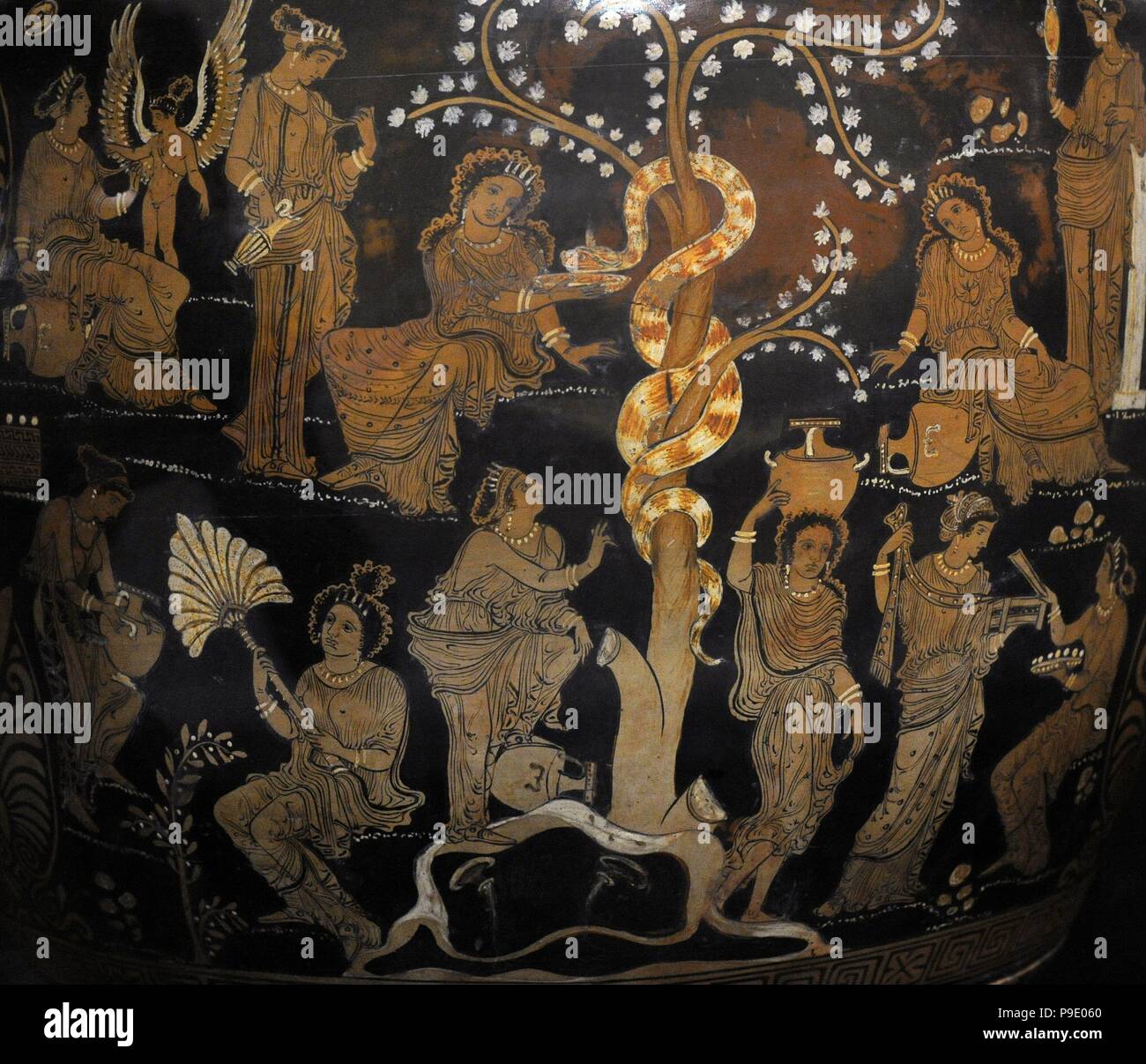 Krater with decoration depicting the Garden of the Hesperides. 360 BC. Detail. Lycurgus Painter. Made in Puglia. From Ruvo di Puglia. Jatta National Archaeological Museum. Ruvo di Puglia. Italy. Stock Photohttps://www.alamy.com/image-license-details/?v=1https://www.alamy.com/krater-with-decoration-depicting-the-garden-of-the-hesperides-360-bc-detail-lycurgus-painter-made-in-puglia-from-ruvo-di-puglia-jatta-national-archaeological-museum-ruvo-di-puglia-italy-image212363816.html
Krater with decoration depicting the Garden of the Hesperides. 360 BC. Detail. Lycurgus Painter. Made in Puglia. From Ruvo di Puglia. Jatta National Archaeological Museum. Ruvo di Puglia. Italy. Stock Photohttps://www.alamy.com/image-license-details/?v=1https://www.alamy.com/krater-with-decoration-depicting-the-garden-of-the-hesperides-360-bc-detail-lycurgus-painter-made-in-puglia-from-ruvo-di-puglia-jatta-national-archaeological-museum-ruvo-di-puglia-italy-image212363816.htmlRMP9E060–Krater with decoration depicting the Garden of the Hesperides. 360 BC. Detail. Lycurgus Painter. Made in Puglia. From Ruvo di Puglia. Jatta National Archaeological Museum. Ruvo di Puglia. Italy.
 Terracotta proteome or bust of the god Dionysus Greek 380-360 BC. The god holds an egg and a wine jug. Stock Photohttps://www.alamy.com/image-license-details/?v=1https://www.alamy.com/stock-photo-terracotta-proteome-or-bust-of-the-god-dionysus-greek-380-360-bc-the-57434962.html
Terracotta proteome or bust of the god Dionysus Greek 380-360 BC. The god holds an egg and a wine jug. Stock Photohttps://www.alamy.com/image-license-details/?v=1https://www.alamy.com/stock-photo-terracotta-proteome-or-bust-of-the-god-dionysus-greek-380-360-bc-the-57434962.htmlRMD9CATJ–Terracotta proteome or bust of the god Dionysus Greek 380-360 BC. The god holds an egg and a wine jug.
 Head of Heracles. Roman copy after a Greek original from about 360 BC on display in the Glyptothek Museum in Munich, Bavaria, Germany. Stock Photohttps://www.alamy.com/image-license-details/?v=1https://www.alamy.com/stock-photo-head-of-heracles-roman-copy-after-a-greek-original-from-about-360-135831773.html
Head of Heracles. Roman copy after a Greek original from about 360 BC on display in the Glyptothek Museum in Munich, Bavaria, Germany. Stock Photohttps://www.alamy.com/image-license-details/?v=1https://www.alamy.com/stock-photo-head-of-heracles-roman-copy-after-a-greek-original-from-about-360-135831773.htmlRMHTYJPN–Head of Heracles. Roman copy after a Greek original from about 360 BC on display in the Glyptothek Museum in Munich, Bavaria, Germany.
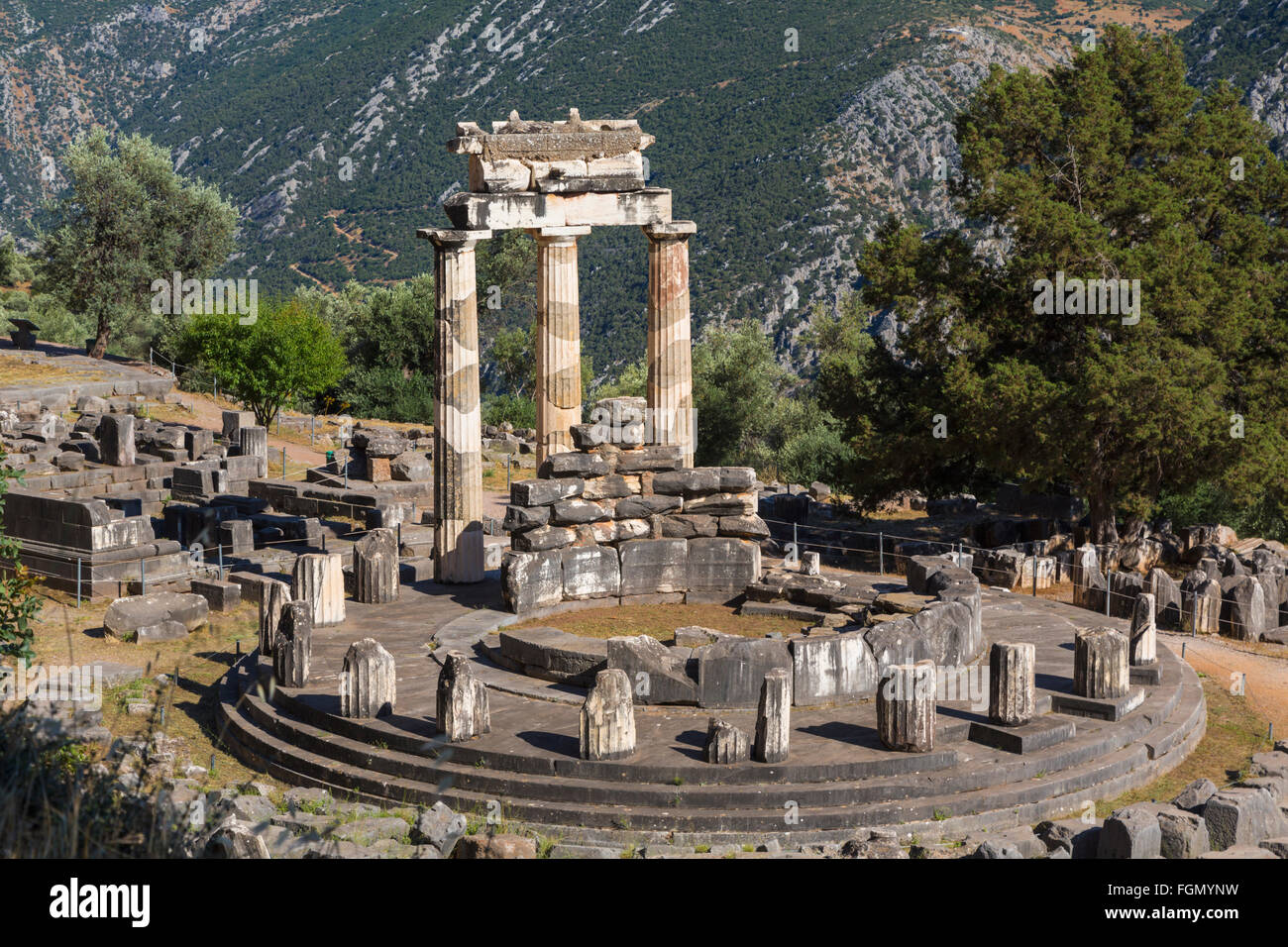 Delphi, Phocis, Greece. The tholos, dating from around 380-360 BC, beside the Sanctuary of Athena Pronaia. Stock Photohttps://www.alamy.com/image-license-details/?v=1https://www.alamy.com/stock-photo-delphi-phocis-greece-the-tholos-dating-from-around-380-360-bc-beside-96347157.html
Delphi, Phocis, Greece. The tholos, dating from around 380-360 BC, beside the Sanctuary of Athena Pronaia. Stock Photohttps://www.alamy.com/image-license-details/?v=1https://www.alamy.com/stock-photo-delphi-phocis-greece-the-tholos-dating-from-around-380-360-bc-beside-96347157.htmlRMFGMYNW–Delphi, Phocis, Greece. The tholos, dating from around 380-360 BC, beside the Sanctuary of Athena Pronaia.
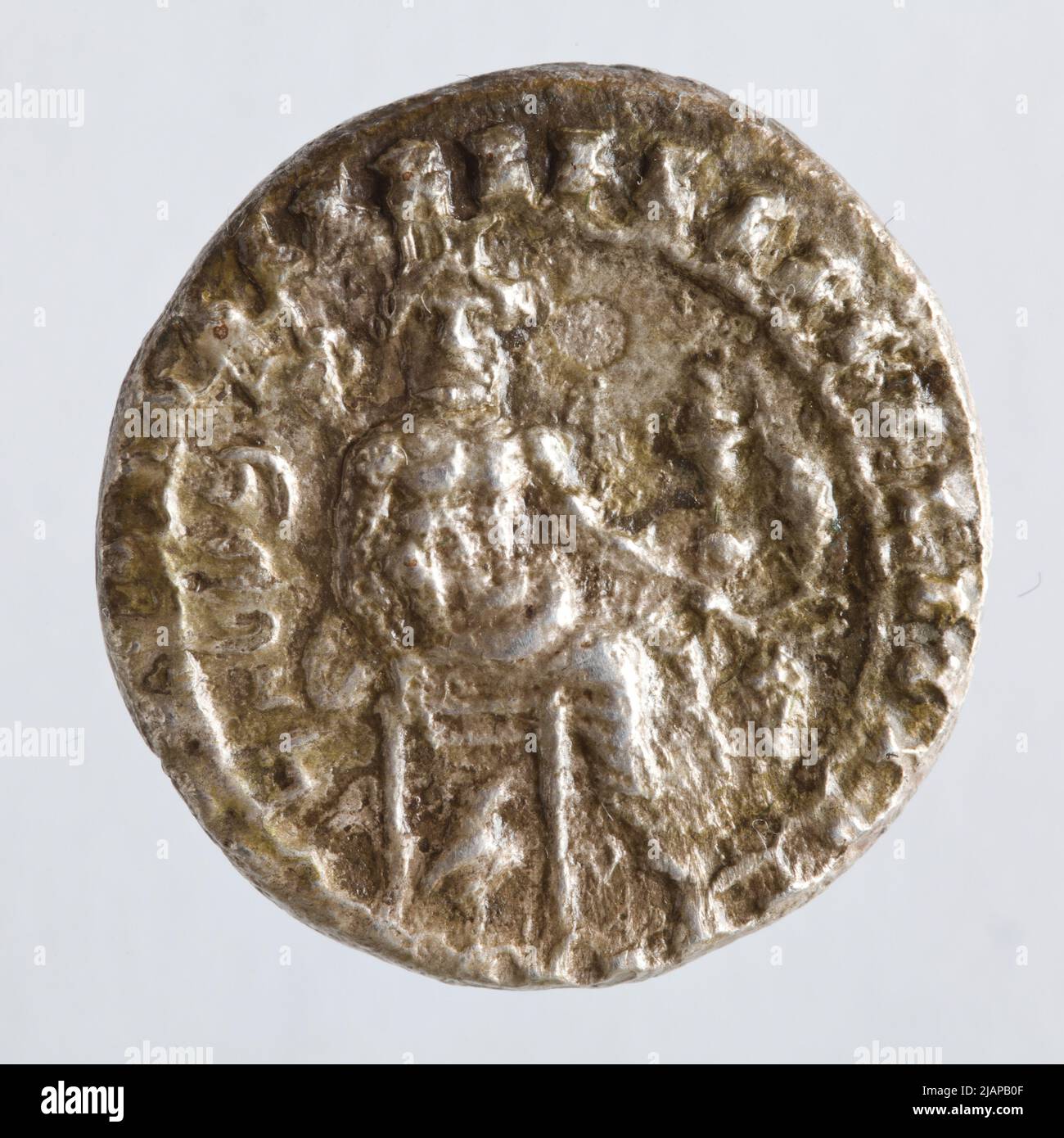 Cilicia, Tarkumuva (380 360), Stater, Tarsus; 364 360 BC Tarkumuwa / Datames, Tars, Cylicja Stock Photohttps://www.alamy.com/image-license-details/?v=1https://www.alamy.com/cilicia-tarkumuva-380-360-stater-tarsus-364-360-bc-tarkumuwa-datames-tars-cylicja-image471318079.html
Cilicia, Tarkumuva (380 360), Stater, Tarsus; 364 360 BC Tarkumuwa / Datames, Tars, Cylicja Stock Photohttps://www.alamy.com/image-license-details/?v=1https://www.alamy.com/cilicia-tarkumuva-380-360-stater-tarsus-364-360-bc-tarkumuwa-datames-tars-cylicja-image471318079.htmlRM2JAPB0F–Cilicia, Tarkumuva (380 360), Stater, Tarsus; 364 360 BC Tarkumuwa / Datames, Tars, Cylicja
 Marble grave marker of a family in the Metropolitan Museum of Art, (Met) New York City USA Stock Photohttps://www.alamy.com/image-license-details/?v=1https://www.alamy.com/stock-photo-marble-grave-marker-of-a-family-in-the-metropolitan-museum-of-art-55871094.html
Marble grave marker of a family in the Metropolitan Museum of Art, (Met) New York City USA Stock Photohttps://www.alamy.com/image-license-details/?v=1https://www.alamy.com/stock-photo-marble-grave-marker-of-a-family-in-the-metropolitan-museum-of-art-55871094.htmlRMD6W446–Marble grave marker of a family in the Metropolitan Museum of Art, (Met) New York City USA
 The Tholos at the sanctuary of Athena Pronaia is a circular building that was constructed between 380 and 360 BC. Stock Photohttps://www.alamy.com/image-license-details/?v=1https://www.alamy.com/stock-photo-the-tholos-at-the-sanctuary-of-athena-pronaia-is-a-circular-building-55325219.html
The Tholos at the sanctuary of Athena Pronaia is a circular building that was constructed between 380 and 360 BC. Stock Photohttps://www.alamy.com/image-license-details/?v=1https://www.alamy.com/stock-photo-the-tholos-at-the-sanctuary-of-athena-pronaia-is-a-circular-building-55325219.htmlRFD607TK–The Tholos at the sanctuary of Athena Pronaia is a circular building that was constructed between 380 and 360 BC.
 Greece, East Macedonia and Thrace Region, Philippi, ruins of ancient city founded in 360 BC, view of the Forum Stock Photohttps://www.alamy.com/image-license-details/?v=1https://www.alamy.com/stock-photo-greece-east-macedonia-and-thrace-region-philippi-ruins-of-ancient-149612484.html
Greece, East Macedonia and Thrace Region, Philippi, ruins of ancient city founded in 360 BC, view of the Forum Stock Photohttps://www.alamy.com/image-license-details/?v=1https://www.alamy.com/stock-photo-greece-east-macedonia-and-thrace-region-philippi-ruins-of-ancient-149612484.htmlRMJKBC70–Greece, East Macedonia and Thrace Region, Philippi, ruins of ancient city founded in 360 BC, view of the Forum
 Triobol; Pantikapaion; 375-360 BC (375-00-00-360-00-00);Nadczarzyorze, Protassowicki, Rafał (1894-1957), Protassowicki, Rafał (1894-1957)-collections, satir (mitol.), Lions, purchase (provenance), animals Stock Photohttps://www.alamy.com/image-license-details/?v=1https://www.alamy.com/triobol-pantikapaion-375-360-bc-375-00-00-360-00-00nadczarzyorze-protassowicki-rafa-1894-1957-protassowicki-rafa-1894-1957-collections-satir-mitol-lions-purchase-provenance-animals-image598708340.html
Triobol; Pantikapaion; 375-360 BC (375-00-00-360-00-00);Nadczarzyorze, Protassowicki, Rafał (1894-1957), Protassowicki, Rafał (1894-1957)-collections, satir (mitol.), Lions, purchase (provenance), animals Stock Photohttps://www.alamy.com/image-license-details/?v=1https://www.alamy.com/triobol-pantikapaion-375-360-bc-375-00-00-360-00-00nadczarzyorze-protassowicki-rafa-1894-1957-protassowicki-rafa-1894-1957-collections-satir-mitol-lions-purchase-provenance-animals-image598708340.htmlRM2WP1EGM–Triobol; Pantikapaion; 375-360 BC (375-00-00-360-00-00);Nadczarzyorze, Protassowicki, Rafał (1894-1957), Protassowicki, Rafał (1894-1957)-collections, satir (mitol.), Lions, purchase (provenance), animals
 Paestrum, Andriuolo. Tomb 24. (370-360 BC ) Stock Photohttps://www.alamy.com/image-license-details/?v=1https://www.alamy.com/stock-photo-paestrum-andriuolo-tomb-24-370-360-bc-139216272.html
Paestrum, Andriuolo. Tomb 24. (370-360 BC ) Stock Photohttps://www.alamy.com/image-license-details/?v=1https://www.alamy.com/stock-photo-paestrum-andriuolo-tomb-24-370-360-bc-139216272.htmlRFJ2DRNM–Paestrum, Andriuolo. Tomb 24. (370-360 BC )
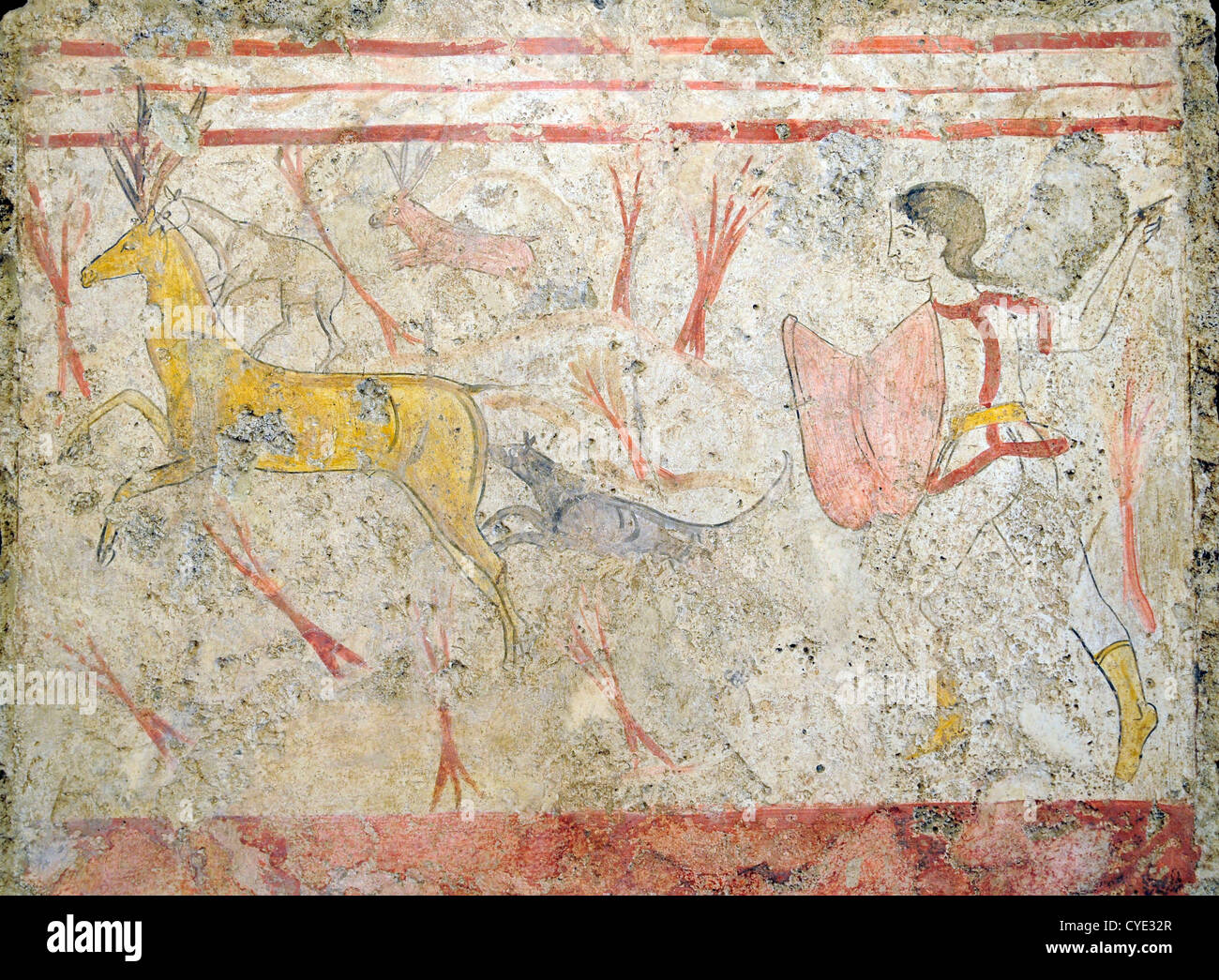 Hunt of the deer, Greek tomb slab c.370-360 BC, The museum at Paestum, site of Greek and Roman remains, Italy Stock Photohttps://www.alamy.com/image-license-details/?v=1https://www.alamy.com/stock-photo-hunt-of-the-deer-greek-tomb-slab-c370-360-bc-the-museum-at-paestum-51326207.html
Hunt of the deer, Greek tomb slab c.370-360 BC, The museum at Paestum, site of Greek and Roman remains, Italy Stock Photohttps://www.alamy.com/image-license-details/?v=1https://www.alamy.com/stock-photo-hunt-of-the-deer-greek-tomb-slab-c370-360-bc-the-museum-at-paestum-51326207.htmlRMCYE32R–Hunt of the deer, Greek tomb slab c.370-360 BC, The museum at Paestum, site of Greek and Roman remains, Italy
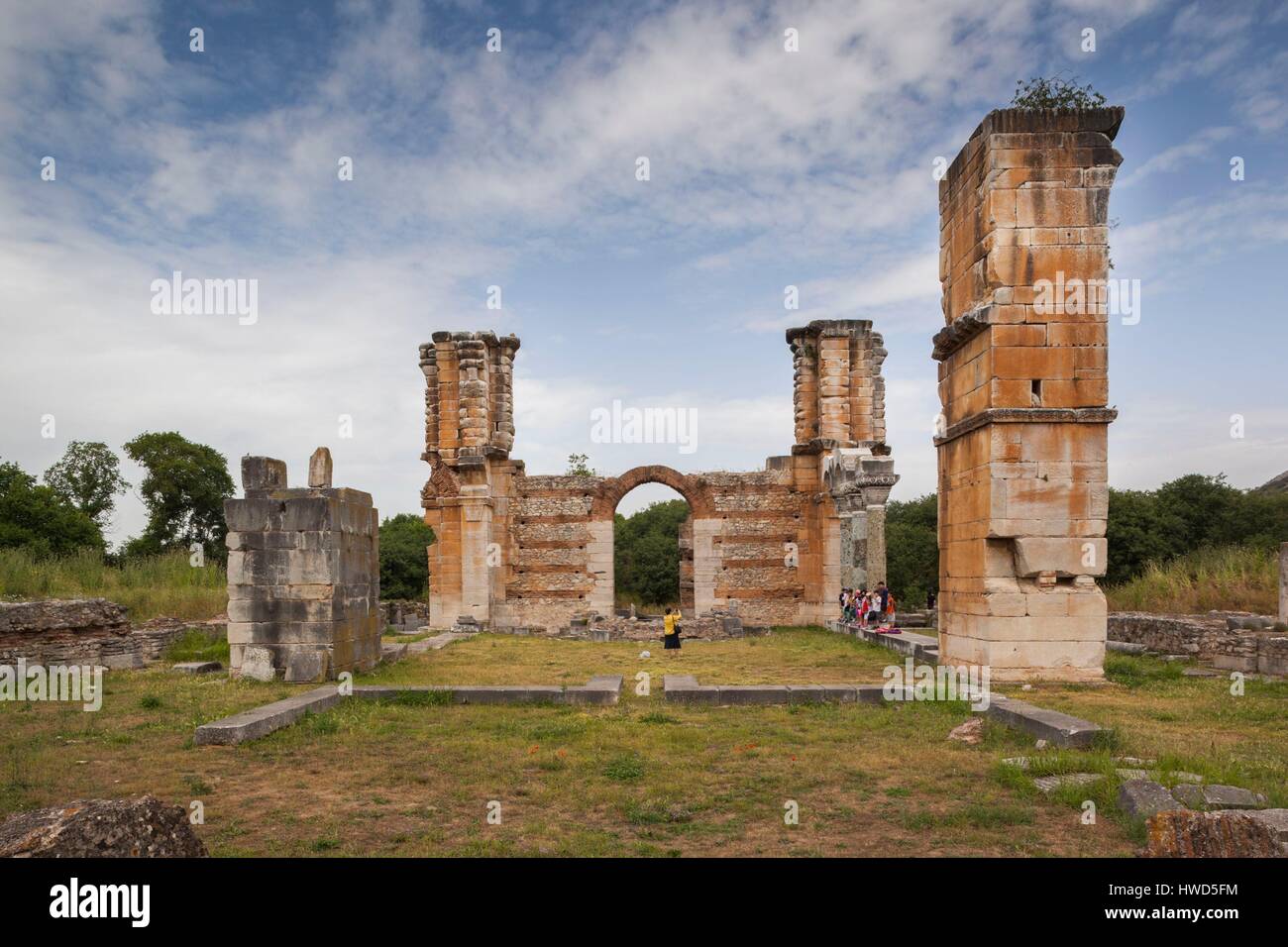 Greece, East Macedonia and Thrace Region, Philippi, ruins of ancient city founded in 360 BC, Basilica B Stock Photohttps://www.alamy.com/image-license-details/?v=1https://www.alamy.com/stock-photo-greece-east-macedonia-and-thrace-region-philippi-ruins-of-ancient-136128712.html
Greece, East Macedonia and Thrace Region, Philippi, ruins of ancient city founded in 360 BC, Basilica B Stock Photohttps://www.alamy.com/image-license-details/?v=1https://www.alamy.com/stock-photo-greece-east-macedonia-and-thrace-region-philippi-ruins-of-ancient-136128712.htmlRMHWD5FM–Greece, East Macedonia and Thrace Region, Philippi, ruins of ancient city founded in 360 BC, Basilica B
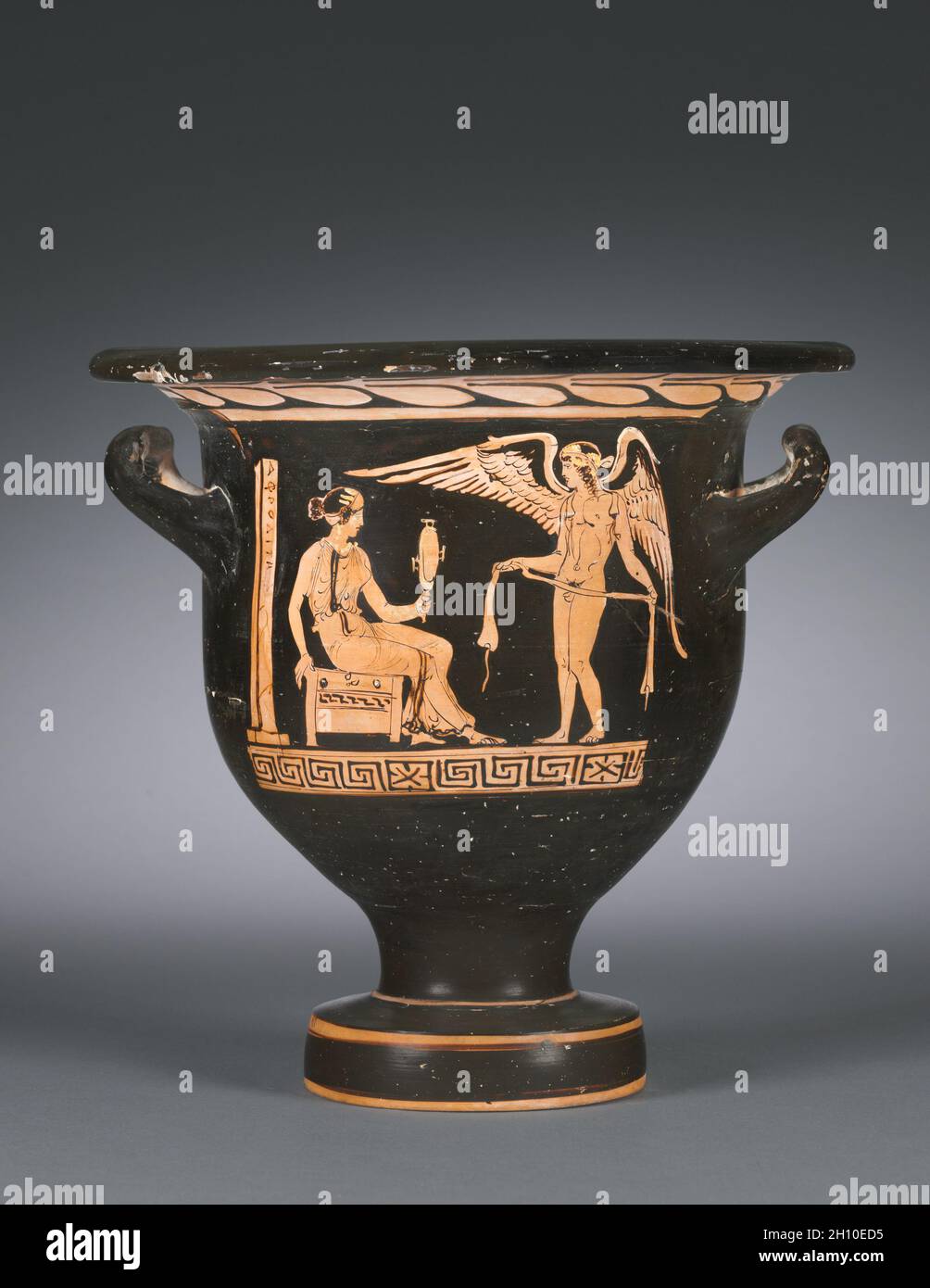 Red-Figure Bell Krater (Mixing Vessel): Aphrodite and Eros, c. 370-360 BC. Attributed to Graz Painter (South Italian, Apulian, active c. 380-360 BC). Ceramic; overall: 30.5 cm (12 in.). Stock Photohttps://www.alamy.com/image-license-details/?v=1https://www.alamy.com/red-figure-bell-krater-mixing-vessel-aphrodite-and-eros-c-370-360-bc-attributed-to-graz-painter-south-italian-apulian-active-c-380-360-bc-ceramic-overall-305-cm-12-in-image448095569.html
Red-Figure Bell Krater (Mixing Vessel): Aphrodite and Eros, c. 370-360 BC. Attributed to Graz Painter (South Italian, Apulian, active c. 380-360 BC). Ceramic; overall: 30.5 cm (12 in.). Stock Photohttps://www.alamy.com/image-license-details/?v=1https://www.alamy.com/red-figure-bell-krater-mixing-vessel-aphrodite-and-eros-c-370-360-bc-attributed-to-graz-painter-south-italian-apulian-active-c-380-360-bc-ceramic-overall-305-cm-12-in-image448095569.htmlRM2H10ED5–Red-Figure Bell Krater (Mixing Vessel): Aphrodite and Eros, c. 370-360 BC. Attributed to Graz Painter (South Italian, Apulian, active c. 380-360 BC). Ceramic; overall: 30.5 cm (12 in.).
 Greece, East Macedonia and Thrace Region, Philippi, ruins of ancient city founded in 360 BC, detail of mosaic floor in the cathedral quarter Stock Photohttps://www.alamy.com/image-license-details/?v=1https://www.alamy.com/greece-east-macedonia-and-thrace-region-philippi-ruins-of-ancient-city-founded-in-360-bc-detail-of-mosaic-floor-in-the-cathedral-quarter-image259649673.html
Greece, East Macedonia and Thrace Region, Philippi, ruins of ancient city founded in 360 BC, detail of mosaic floor in the cathedral quarter Stock Photohttps://www.alamy.com/image-license-details/?v=1https://www.alamy.com/greece-east-macedonia-and-thrace-region-philippi-ruins-of-ancient-city-founded-in-360-bc-detail-of-mosaic-floor-in-the-cathedral-quarter-image259649673.htmlRMW2C1PH–Greece, East Macedonia and Thrace Region, Philippi, ruins of ancient city founded in 360 BC, detail of mosaic floor in the cathedral quarter
 Greece, East Macedonia and Thrace, Philippi, ruins of ancient city founded in 360 BC, view of the Forum Stock Photohttps://www.alamy.com/image-license-details/?v=1https://www.alamy.com/stock-photo-greece-east-macedonia-and-thrace-philippi-ruins-of-ancient-city-founded-88805571.html
Greece, East Macedonia and Thrace, Philippi, ruins of ancient city founded in 360 BC, view of the Forum Stock Photohttps://www.alamy.com/image-license-details/?v=1https://www.alamy.com/stock-photo-greece-east-macedonia-and-thrace-philippi-ruins-of-ancient-city-founded-88805571.htmlRMF4DCBF–Greece, East Macedonia and Thrace, Philippi, ruins of ancient city founded in 360 BC, view of the Forum
RM2WP1KPN–Triobol; Pantikapaion; 375-360 BC (375-00-00-360-00-00);Nadczarzyorze, satir (mitol.), Terlecki, Ignacy (1860-1916), Terlecki, Ignacy (1860-1916)-collection, weapons (iconogr.), Lions, weapons, weapons (iconogr.), Scripture, Purchase, Purchase (provenance), animals
 Germany, Bavaria, Munich, Glyptothek Museum, Head Statue of Heracles, Roma Sculpture, About 360 BC. Stock Photohttps://www.alamy.com/image-license-details/?v=1https://www.alamy.com/germany-bavaria-munich-glyptothek-museum-head-statue-of-heracles-roma-sculpture-about-360-bc-image611294364.html
Germany, Bavaria, Munich, Glyptothek Museum, Head Statue of Heracles, Roma Sculpture, About 360 BC. Stock Photohttps://www.alamy.com/image-license-details/?v=1https://www.alamy.com/germany-bavaria-munich-glyptothek-museum-head-statue-of-heracles-roma-sculpture-about-360-bc-image611294364.htmlRM2XEET5G–Germany, Bavaria, Munich, Glyptothek Museum, Head Statue of Heracles, Roma Sculpture, About 360 BC.